SCIENCE LABSTUDENT EXPERIMENTS SYSTEM



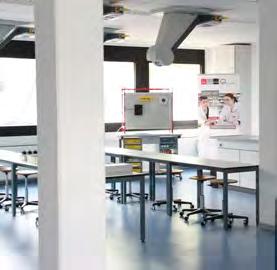

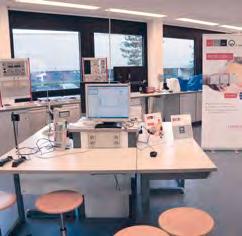


THE SECRET OF SUCCESS IS THE MIX OF THEORY & PRACTICE
Experimentation has always been a core competence of scientists and ensures to really understand STEM phenomena.
The planning, carrying out and recording of experiments is an important element of a well-founded education in science. In order to reinforce newly acquired knowledge, experiments must be well matched to the theory.
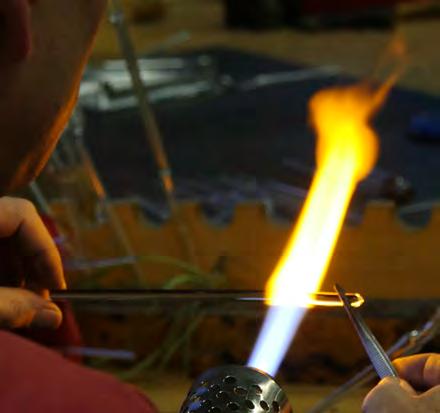
We believe in the importance of education as a fundamental driver of personal, national and global development. In a highly specialised world, knowledge has become a decisive factor: Skilled personnel are in greater demand than ever. Investing in the practical training of your students, you equip them with important science skills that the labour market requires.
FOR TEACHING EQUIPMENT
From the very beginning in 1850 we at LEYBOLD concentrate on how to make academic content understandable and tangible for students at different levels of education. Therefore we are proud that for generations our training and educational systems have made a significant contribution to knowledge transfer in natural sciences.
However, for 170 years of experience we have found that you can achieve a lot when keeping pace with customer needs: we continuously challenge ourselves to preserve our high quality standards and develop our products and services in line with changing curricula and new technologies.
The LD DIDACTIC Group is a leading global manufacturer of high quality STEM teaching and training system.
We can supply all from a single source: Teaching systems, experiment literature and documentation for STEM as well as training and didactic seminars.
Headquarter Huerth, Germany
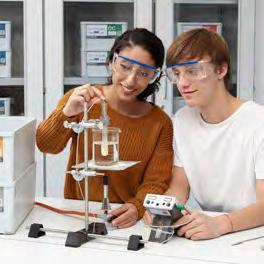
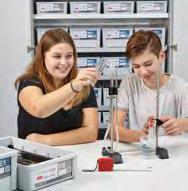




n Best solution for STEM education
Skill enhancing: Problem solving and planning, observation and analysis learning processes
n Save time
Fast search of experiments and distribution of the student worksheets
n Easy preparation
At home or on the go: Cloud solution makes all information accessible from everywhere
n Supports every teaching style
Work fully digital or with pen and paperthe system fits to each way of teaching
n For excellent teaching results
Adjust the content to the level of the student by using the Lab Docs Editor

STORAGE SYSTEM & DEVICES
BIOLOGY
CHEMISTRY
TECHNOLOGY
ENGINEERING
1 3 2 ACQUIRE DIGITAL & EXPERIMENTAL SKILLS
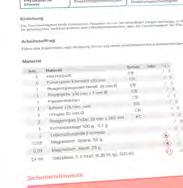
COMPLETE SOLUTION
+ Curricular consulting
+ Teacher/lecturer training
+ Lab management
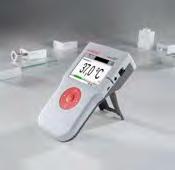
DATA LOGGING
EXPERIMENT INSTRUCTIONS
Developed in collaboration with didactic institutes from the University of Cologne.


n Experiments developed according to the latest didactic research
n Fundamental & professional experiments
n High-quality and innovative devices
n Developed for experimenting in student groups
n Experimental units fit into prescribed timeframe (class/lectures)
n Experiments are easy to understand and safe
n Reduced preparation time for teachers/lecturers
n Ideal in combination with the universal student measuring deviceMobile-CASSY 2 WiFi - for all topics due to various sensors specially designed for student experiments
n Customisable, interactive experiment instructions with teacher/lecturer and student sections
n Pre-formed storage for quick completeness checks
n Durable due to robust & sturdy materials
n Innovative design enables easy storage and quick use
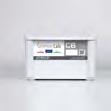
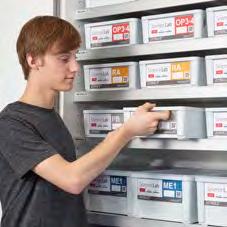

n With and without lid symmetrically stackable
n Front and rear moulded grips for easy removal and transport
n Systematic arrangement of the devices

n All the materials from the tray to the divider
n Knock and bump-resistant
n Washable and easy to clean
n No discolouration with sun exposure

n Additional safety for devices in the tray and during transport
n Lid fits on and under the tray for easy handling and low space requirements

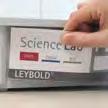
n Labelling on front and back of the tray
n Clear labels, recognisable from a distance
n Personalise the labels for student groups
n Waterproof
n Labels are in a protective cover
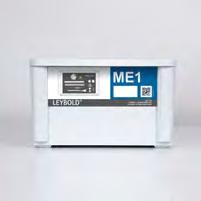
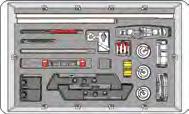
n Quick identification of the right equipment and efficient clean-up
n Easy check completeness before and after experimenting
n Online accessable by using QR code (available for printing)



n Clear structure of the experiment collection due to unique colour codes and abbreviated set identifiers
n By subject
n By subject/topic area
n By topic
n Quick and easy locating by combining the colour coding with the abbreviations of the individual trays
n QR code: directly to all product information and detailed inventory plan
n Direct assignment to student groups using the customisable label



DIGITAL PREPARATION
n Online portal - Organisation & management of experiments and devices
n LD management system LeyLab may contain LD and own experiment instructions

DIGITAL EVALUATION & PROTOCOL
Interactive usage
n Answer questions
n Analyse
n Write digital protocols
n Save
n Share with the teacher/lecturer



DIGITAL DISTRIBUTION
n Easily access from all students’ tablets and smartphones using a QR code

DIGITAL EXPERIMENTING
n Opening the Lab Doc
n Setting up experiment
DIGITAL DATA ACQUISITION
Interactive with Mobile-CASSY 2 WiFi
n Perform experiment & measurement
n Measured values in tables & diagrams in real time

INTERACTIVITY: STUDENTS – LAB DOC – EXPERIMENT
Every student answers the questions in the individual Lab Doc on their tablet, smartphone or laptop and analyses the measurements. Then the individual protocol can be stored and shared.

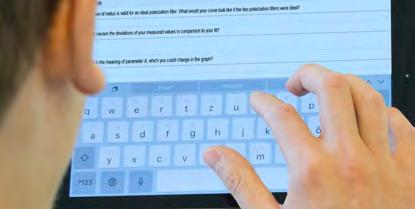
Enter answers directly

Live measured values from the Mobile-CASSY 2 WiFi are transmitted to measuring instruments, tables & diagrams


Enter the measured values manually, diagrams are created automatically

Smart diagrams, selection of alignments by touch
MANUAL INPUT
INTERACTIVE MEASURING INSTRUMENTS
Save and share the protocols, stored data can be reloaded at any time (e.g. for further editing at home)
DIGITAL PROTOCOL

Effortless preparation, straightforward implementation
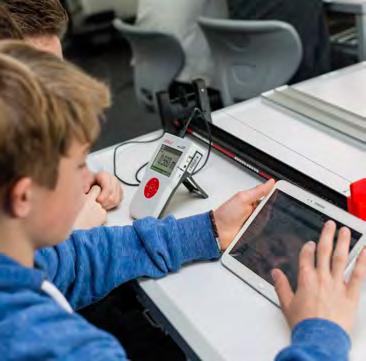
n Short and easy-to-follow experiment descriptions with direct student addressing
n Sufficient space for student’s answers
n Modular design allows for many options for specialisation and working speeds
n Contains instructions and a to be completed worksheet
n Systematic illustration of the experimental set-up and performing


n Designed for useful prescribed timeframes
n Tailored to the respective age group
n Recommendations for the use of experiments and their goals as well as a classification in the subject-related context
n Detailed accompanying information for preparation, naming of possible sources of error and safety measures
n Worksheet contains sample answers and sample measurements as well as sample evaluations for planning classes or lectures
n Classification of experiments according to level, degree of difficulty, preparation time and duration
1. Set-up instructions and assignments of tasks
2. Measured values (table, diagram)
3. Data evaluation (answers, alignments of measured values)
This produces: a complete digital protocol

All information about the experiment is in the Lab Doc of each student. No additional programs or apps are needed to analyse the measured values.
Work fully digital on all platforms or traditionally with paper




n Download as a PDF file for printing
n For all platforms

n The digital version can be accessed from any student device
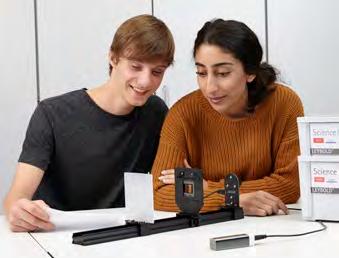
n Any tablet, smartphone or PC
n Solutions for any IT infrastructure
n Allows for BYOD
n No installation necessary iOS iOS iOS LINUX macOS



n Experiment title and subject
n Age/degree
n Difficulty level
n Preparation time for teachers/lecturers
n Experiment duration


TEACHER/LECTURER SECTION INCLUDES
ADDITIONAL
n
n Assignment
n Equipment
n
n Setup
n Experimental procedure

QUICKLY AND EASILY EDIT AND CREATE EXPERIMENT INSTRUCTIONS
ADAPT PURCHASED LAB DOCS FROM LITERATURE PACKAGES
MAKE YOUR EXISTING INSTRUCTIONS SUITABLE FOR THE DIGITAL CLASS/LECTURE
CREATE BRAND NEW INSTRUCTIONS OF YOUR OWN
n Easy-to-use tool, HTML skills are not needed
n Design experiment instructions easily and adapt to your own needs
n Responsive layout - adapts to any screen size
n Central availability for all colleagues
n Measured values tables & diagrams with or without integration of a Mobile-CASSY interface
COMPREHENSIVE
n Edit & delete assignments
n Modify instructions
n Add text
n Integrate and adapt interactive diagrams & tables
n Insert images, vector graphics, hyperlinks, etc.
n Prepare and create equipment lists
n Create formulas


n Changes are immediately visible in the web browser
n Convenient view of student & teacher/lecturer section
n Export as PDF possible
n Export to LeyLab for centralised management
n Distribution of Lab Docs using QR code

n For all measuring tasks and subjects in physics, chemistry & biology
n Measure and analyse all in one
n With WiFi to connect to school/university WiFi or set up your own access point
n Large display for high-contrast diagrams
n Measure voltage, current, power, energy and temperature directly with the device - no accessories needed
n Compatible with all CASSY sensors S and M
n Automatic sensor detection
n Fast recording of measured values - up to 500,000 values per second

EASY TO MEASURE DIRECTLY
1. SWITCH ON |
2. ATTACH THE SENSOR |
3. AUTOMATIC SENSOR DETECTION |
4. START THE MEASUREMENT |
5. SAVE VALUES IN MOBILE-CASSY |
6. CREATE PROTOCOL

MEASURE WITH LAB DOCS
1. SWITCH ON |
2. ATTACH THE SENSOR |
3. MESSEINSTELLUNG VON LAB DOC |
4. START THE MEASUREMENT |
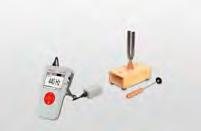

5. MEASUREMENT RESULTS LIVE IN LAB DOC |
6. ANALYSIS IN LAB DOC |
7. SAVE DIGITAL PROTOCOL

MEASURE WITH CASSY.APP WEB
1. SWITCH ON |
2. ATTACH THE SENSOR |
3. SET MEASUREMENT SETTINGS IN WEB-APP |
4. START DER MESSUNG |
5. SAVE MEASUREMENT RESULTS |

6. VARIETY OF EVALUATION OPTIONS (WEB-APP, EXCEL, ETC.)
1. SWITCH ON |
2. ATTACH THE SENSOR |
3. AUTOMATIC SENSOR DETECTION |
4. START THE MEASUREMENT |
5. SAVE VALUES IN MOBILE-CASSY |
6. CREATE PROTOCOL
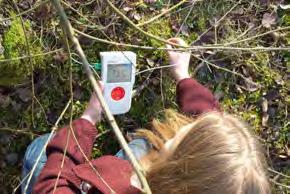
Digital student experiments can also be carried out exclusively with the Mobile-CASSY 2 WiFi.
The student measuring device can set up a so-called access point. This WiFi network allows then the interaction with tablets or smartphones.



The CASSY sensors M are the ideal completion for LEYBOLD student experiments with the Mobile-CASSY 2 WiFi.
n Affordable sensor family, specially developed for student experiments
n Sensors with several measurement parameters and/or ranges
n Automatic parameter setting
n Immediate measurement with simple set-up
n Range can be continuously expanded with further sensors
n Including over 50 CASSY S Sensors
n Supported by the Lab Docs and the CASSY app


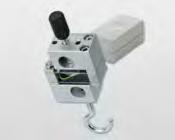



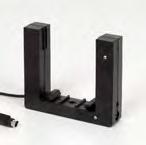


Up to four devices (tablet/smartphone/laptop) can be connected to one Mobile-CASSY 2 WiFi (= 1 student group)
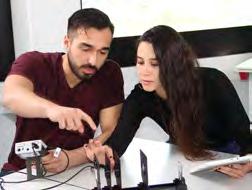

Once connected to Mobile-CASSY 2 WiFi, the settings for the experiment are transferred (measurement parameters or ranges etc.).
Measurement values are directly put into tables and diagrams of the Lab Doc.


n Complete online portal
n For organisation & management of experiments and devices
n No installation needed
n For all platforms, tablets, smartphones and PC‘s

n Anytime and from anywhere access to the whole LD experiments catalogue with all the relevant information for every experiment
n Find desired experiment quickly and reliably
n Set-up own experiment collection
n Easily expand the LD experiments
n Easily create own, new experiments
n Collaborate with colleagues
n Intelligently link devices
n Additional documents are where you need them for the experiment
n Collection of all kinds of documents like PDFs, videos or links to websites or apps; can be shared with students
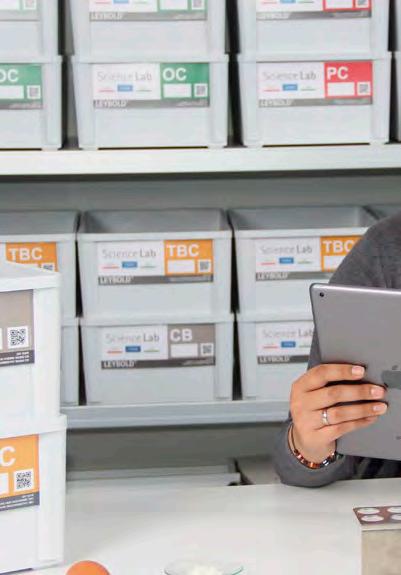

n Entire inventory at a glance
n Direct overview of all available devices including quantity and storage location
n Save time searching for equipment
n Detailed information on every item
n Easy inventory of the complete collection
n LD devices and other manufacturers’ devices
n With barcode functionality
n Clear inventory management with borrowing and return function




n Manage all LD software and literature in one place
n Licence codes are safely stored in the cloud so they are not lost and can be used to install software on new hardware
n Third party access to LeyLab is possible
n Share information with teachers/lecturers from other institutes
n Enables a centralised organisation (e.g. by ministry) of many institutes and therefore a more efficient use of the equipment, documents, etc.
You get customised training programs to ensure sustainable facilities and resources

n Specialised training programs for teachers, lecturers and trainers
n Methodological, didactic and technical training
n Content and training focus is chosen on requirements
n Practical work is central point, incl. whole process to perform experiments
n Organisation & maintenance of equipment
n Seminar has external parts at well-known schools, universities and institutions
n Insights into German didactic standards and trends
n Comprehensive guides and seminar documentation
n Possibility to achieve qualification to train other teachers, lecturers or trainers


The university “Universidad Autónoma del Estado de Hidalgo” achieved a higher educational level for natural science teachers in implementing experiments in natural science classes. The university teachers also obtained sustainable know-how with regard to lab management in order to further educate other school teachers in Mexico. The seminar took place in the labs at LEYBOLD, the University of Cologne and an extracurricular place of learning.



DETAILED INDIVIDUAL OFFER

CONSULTING

TEACHER/ LECTURER
ACADEMY



AFTER SALES SUPPORT






FINANCE




PRODUCTION & QUALITY CONTROL
INSTALLATION & TRAINING ON SITE
We guarantee a repair or replacement solution for at least 10 years after purchase - for the majority of our range even longer.
SEMINAR ON LAB MANAGEMENT AND LAB WORK FOR SUSTAINABLE NATURAL
6 day seminar for all natural sciences
n Lab management & organisation
n Maintenance of lab equipment
n Lab safety
n Integration of lab work in organisational & content-related learning process
n Data logging
n Theory of natural science didactics and latest trends
n Practical lab work, incl. preparation, set-up, evaluation and documentation of experiments
n Transfer of theoretical content through experiments to students
n Exciting new insights into German & international didactic standards and trends in science education
n Deepened knowledge on lab management and new understanding of work flow processes
n Step-by-step guides to integrate experiments in science classes
n Motivational expertise and inspiration
n High increase of practical lab work experience
n Achieved qualification to train other teachers/lecturer
n International exchange of didactic know-how
To make it easier for you to use our catalogue, we would like to explain how our catalogue is structured using sample pages. The structure of the chapters and pages is laid out in the same way throughout as follows:





Marking and explanation of sensors required to perform the experiments.






Marking of digital experiments, where Mobile-CASSY 2 WiFi is used


General overview of the individual subject areas as well as a bullet point list of the curriculum-compliant topics.
Detailed information on the individual Science Lab set, incl. scope of delivery, etc.








Description of the basic set which is required for several subject areas.
QR code for each Science Lab set (for more information)













Overview of advantages
Overview of additionally required material per student, working group and class/lecture to perform experiments



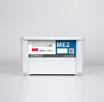
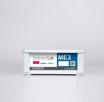

LP1.1
LP1.3



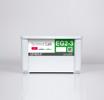



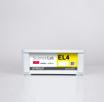
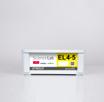

LP3.1
LP3.2
LP3.3 BASIC ELECTRICAL CIRCUITS AND ELECTROCHEMISTRY
electricity; Forces acting between charges; Electrostatic induction; Charge storage; Electrostatic interaction; Insulators and conductors; Equipotential lines; Plate capacitor
circuits and switches; Electrical measurement methods; Ohmic resistance; Special resistors; Voltage sources; Electrical application circuits; Electrochemistry
LP3.4 ELECTROMAGNETISM AND INDUCTION Electromagnetism; Electromagnetism applications; Induction; Transformers; Applications of induction; Coils in direct and alternating current circuits
LP3.5
LP4.1 BASIC ELECTRONICS CIRCUITS Capacitors; Relay circuits; Diodes; Transistors;

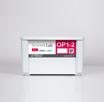

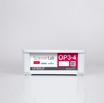
LP5.1 RAY OPTICS AND GEOMETRICAL OPTICS
Propagaton of light and shadow formation; Light and shadow in nature; Reflection in mirrors; Light refraction; Dispersing light and recombination of the spectrum; Lenses and lens aberrations; Optical instruments for angular magnification; Optical instruments and the eye
LP5.2 CHROMATICS Examination of the light paths through a prism; Spectral colours; Colour
LP5.3
LP5.4 POLARISATION Polarisation filters; Photoelastic double refraction; Polarisation due to reflection and diffraction; Polarisation due to scattering; Optical activity

LP6.2 ENVIRONMENTAL RADIOACTIVITY

LP8.1 ARDUINO
Introduction to radioactivity; Investigating the influence of sample properties and the size of the measurement window; Environmental radioactivity; Statistics of radioactive decay; Radiation shielding; Distance; Investigating the radiation in a magnetic field; Half-life
Introduction to microcontroller programming; Data types; Variables and operators; Error analysis; Control structures; Smaller projects
n This Basic Set contains the basic devices which are regularly needed for student experiments in physics
n Each device has its own specified space in the pre-formed storage tray.
n In combination with the experiment set ME1 (207 111S) students can perform 15 experiments; with the experiment set ME2 (207 112S) 41 experiments and with the set EG1 (207 121S) 36 experiments can be realised.
n One Basic Set for the fields of mechanics and energy in physics and a maximum of two trays on the student workstation.
n The Basic Set contains the material required for one work group consisting of 2-3 students.
n Experiments from the Science Lab Physics can then be carried out with only one additional set, depending on the topic.
n Same devices = always the same handling: no need to re-learn devices for every topic.

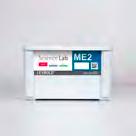




Student experiment set of the student experiment system Science Lab in the field of physics. Basic equipment for mechanics and energy experiments. Set-up material for one working group in pre-formed tray. The individual trays are stackable and can optionally be closed with a lid (647 003)
The equipment set Science Lab Physics Basic PB, in combination with the Mechanics Sets ME1 (207 111S), ME2 (207 112S) and the Energy Set EG1 (207 121S), enables the performance of experiments at school, college and university level for worldwide curriculums.
Scope of delivery:
Count Name
1 Bosshead S
2 Stand base MF
2 Support block
1 Stand rod 25 cm, 10 mm Ø
2 Stand rod 40 cm, 10 mm Ø
1 Pointer, pair
1 Universal pencil
1 Tape measure 2 m / 1 mm
1 Dynamometer, tension and compression, 1.5 N
3 Support clip, for plugging in
6 Weight, 50 g
1 Leaf spring 370 mm
1 Aluminium block
1 Tray, low
1 Universal bosshead
1 Scissors 125 mm, round-ended
1 Metal plate
1 Cord
1 Stopwatch, digital
Additionally required: Count Cat.-No. Name
1 207 111S Science Lab Mechanics ME1 (Set)
1 207 112S* Science Lab Mechanics ME2 (Set)
1 207 121S* Science Lab Energy EG1 (Set)
* alternative
Additionally recommended:
Count Cat.-No. Name
1 647 003 Lid

Every physical variable also has a unit. To make students aware of this, the Science Lab for Mechanics starts with some very basic experiments on the topic of length and density. This also gives students the opportunity to concentrate completely on the description of the experiment protocol. Forces and oscillations as well as linear motion are included under the topic of mechanics. Here, time differences and velocities can be measured with the help of two light barriers. The topic of acoustics completes the mechanics section. From analysing noises to measuring the speed of sound - there is something for every age group.
One Basic Set and four Mechanics Sets provide four topic areas with 97 experiments. This perfect combination of experiments is suitable for perceivable experiments as well as for digital analysis with the Mobile-CASSY 2 WiFi and different sensors. For fast-working students additional tasks are available.

LP1.3.4.1C Determining the acceleration of gravity by plotting a s(t) diagram
Objects fall down when dropped. The gravitational acceleration involved can be measured in this experiment. For this experiment you will need the set Science Lab Mechanics ME3 (207 113S)
EXPERIMENT TOPICS
LP1.1 MEASURING METHODS, PROPERTIES OF MATTER AND LIQUID
LP1.1.1 MEASUREMENT OF LENGTH AND TIME
LP1.1.2 MEASUREMENT OF MASS AND DENSITY
LP1.1.3 PRESSURE IN LIQUIDS
LP1.1.4 FORCES ACTING ON BODIES IN LIQUIDS
LP1.1.5 FORCES ON THE SURFACE OF FLUIDS
LP1.2 FORCES, SIMPLE MACHINES AND OSCILLATIONS
LP1.2.1 MECHANICS OF SOLID BODIES
LP1.2.2 DEFORMATION DUE TO A FORCE
LP1.2.3 COMPOSITION AND DECOMPOSITION OF FORCES
LP1.2.4 LEVERS
LP1.2.5 PULLEY AND INCLINED PLANE
LP1.2.6 HARMONIC OSCILLATIONS
LP1.2.7 FORCED OSCILLATIONS AND STANDING WAVES
LP1.2.8 SUPERPOSITION OF WAVES




LP1.3 LINEAR MOTION, FREE FALL AND COLLISION EXPERIMENTS
LP1.3.1 UNIFORM MOTION
LP1.3.2 UNIFORMLY ACCELERATED MOTION
LP1.3.3 NEWTON’S LAWS
LP1.3.4 FREE FALL
LP1.3.5 EXPERIMENTS ON ELASTIC COLLISIONS
LP1.3.6 EXPERIMENTS ON INELASTIC COLLISIONS
LP1.3.7 CONSERVATION OF MOMENTUM
LP1.4 ACOUSTICS
LP1.4.1 PROPAGATION OF SOUND
LP1.4.2 OSCILLATIONS AND SOUNDS
LP1.4.3 NOISE ANALYSIS
LP1.4.4 RESONANCE AND BEATING
LP1.4.5 SPEED OF SOUND


Further information about our curriculum-compliant topics and student experiments as well as the corresponding sets can be found on the following pages.
Sensors
LP1.1.1 Measurement of length and time
LP1.1.1.1
LP1.1.1.2
LP1.1.1.3
Length measurement
Calculating the volume of regularly shaped bodies
Time measurement
LP1.1.2 Measurement of mass and density
LP1.1.2.1
LP1.1.2.2
LP1.1.2.3
Determining the density of regularly shaped bodies
Determining the density of irregularly shaped bodies
Determining the density of liquids
LP1.1.3 Pressure in liquids
LP1.1.3.1
LP1.1.3.2
LP1.1.3.3
Connected vessels
Hydrostatic pressure
The effects of air pressure
LP1.1.4 Forces acting on bodies in liquids
LP1.1.4.1
LP1.1.4.2
LP1.1.4.3
LP1.1.4.3C
LP1.1.4.4
Buoyancy force as a function of depth of immersion and body mass
Buoyancy force as a function of the density of a fluid
Archimedes’ principle
Archimedes’ principle (with Mobile-CASSY 2 WiFi)
Sinking - floating suspended in a liquid - floating on a liquid
LP1.1.5 Forces on the surface of fluids
LP1.1.5.1 Capillary action


Students use a U-tube manometer and a pressure probe to detect that hydrostatic pressure is increasing in proportion to depth. For this experiment you will need the sets Science Lab Physics Basic PB (207 100S) and Science Lab
OVERVIEW OF EQUIPMENT REQUIRED FOR PERFORMING EXPERIMENTS
LP1.1 MEASURING METHODS, PROPERTIES OF


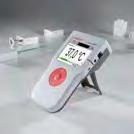



Student experiment set of the student experiment system Science Lab in the field of physics. Set-up material for one working group in pre-formed tray With the equipment set ME1, together with the Science Lab Physics Basic PB (207 100S), 15 experiments at school, college and university level for worldwide curriculums can be performed. The students deal with the topics measuring methods, properties of matter and liquids. While working out the curriculum required topics, they are also trained in communication and assessment skills. In combination with the Mobile-CASSY 2 WiFi (524 005W2), there are additional evaluation options which enable the students digital learning.
Scope of delivery:
1 Funnel PE 40 mm Ø
1 Vernier callipers
1 Rubber
Rubber stopper solid, 19...24 mm Ø

n Students learn about units of measurement
n Simple calculations to determine densities
n Includes a “pressure probe” for measuring the hydrostatic pressure
n Devices can be combined to perform many different experiments
n Acquired skills: writing experiment protocols; differentiation between observation, measurement and evaluation
STUDENT MEASURING DEVICE


The universal student measuring device with WiFi for all measuring tasks in physics, chemistry and biology.
524 005W22 Mobile-CASSY 2 WiFi
Detailed information on the Mobile-CASSY 2 WLAN can be found on the Internet at www.leybold-shop.com/524005W2
Force sensor M, ±50 N
For measuring force components up to ±50 N (e.g. spring pendulum or centrifugal force components) with Mobile-CASSY 2 WiFi (524 005W2). Its rigid design enables the measurement of force components in any position of the force sensor.
524 434 Force sensor M, ±50 N
Detailed information on this and other sensors can be found on the Internet at www.leybold-shop.com

Here you will find an overview of our literature packages. You can find detailed information on our literature on the internet at www.leybold-shop.com.



LIT-print: LP1.1 Measuring methods, properties of matter & liquids
Detailed experiment instructions relating to Science Lab Set ME1 (207 111S) and Science Lab Physics Basic PB (207 100S). Describes 15 experiments from the fields of measuring methods, properties of matter and liquids. Topics:
Measurement of length and time; Measurement of mass and density; Pressure in liquids; Forces acting on bodies in liquids; Forces on the surface of liquids
520 7111EN LIT-print: LP1.1 Measuring methods, properties of matter & liquids
LIT-digital: LP1 Science Lab Mechanics
Comprehensive physics experiment instructions in the field of mechanics for the Science Lab. Contains 97 experiments on measuring methods, properties of matter and liquid; forces, simple machines and oscillations; linear motion, free fall and collisions experiments; acoustics.
Includes all interactive experiment instructions (Lab Docs) as html file.
520 711 LIT-digital: LP1 Science Lab Mechanics
LIT-digital: LP Science Lab Physics
Comprehensive physics experiment instructions for the Science Lab. Contains more than 460 experiments in the fields of mechanics, energy, electricity and electronics, optics, atomic and nuclear physics as well as informatics and technology.
Includes all interactive experiment instructions (Lab Docs) as html file.
520 71 LIT-digital: LP Science Lab Physics
Technical data of the digital version:
• Product key for literature (activation & selection of one literature language in LeyLab)
• Can then be used in LeyLab and Document Center (school/institute licence)
• System requirements:
Document Center:
- PC with Windows 7 or higher; internet access during installation; local network for distribution to students LeyLab:
- PC, tablet or smartphone with a current browser; internet access




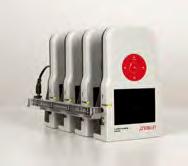
n Comprehensible introduction to the first physical variables
n Effective experiments which quickly teach content-related skills and make students enthusiastic about physics classes/lectures
n Creates links between “weighing” as an everyday experience with physics-related questions of “gravitational force”




n Easy-to-use devices
n Manageable number of devices
n Quick set-up


LP1.2.1 Mechanics of solid bodies
LP1.2.1.1
LP1.2.1.2
LP1.2.1.3
LP1.2.1.4
Types of friction generated by solid bodies
Sliding friction (quantitative)
Centre of gravity
Stability
LP1.2.2 Deformation due to a force
LP1.2.2.1
LP1.2.2.2
LP1.2.2.3
Elongation of a helical spring (Hooke’s law)
Elongation of a rubber ring
Deflection of a leaf spring
LP1.2.3 Composition and decomposition of forces
LP1.2.3.1
LP1.2.3.2
LP1.2.3.3
Composition of forces in the same or opposing directions
Composition of forces in specified amounts
Decomposition of a force into force components
LP1.2.4 Levers
LP1.2.4.1
LP1.2.4.2
LP1.2.4.3
LP1.2.4.4
LP1.2.4.5
LP1.2.4.6
Two-sided lever
Two-sided lever with several forces acting upon it
Beam balance
One-sided lever
Shaft-mounted wheel
Belt-driven gear
LP1.2.5 Pulley and inclined plane
LP1.2.5.1
LP1.2.5.2
LP1.2.5.3
LP1.2.5.4
LP1.2.5.4C
LP1.2.5.5
LP1.2.5.5C
LP1.2.5.6
LP1.2.5.6C
LP1.2.5.7
LP1.2.5.7C
LP1.2.5.8
Fixed pulley
Movable pulley
Hoist with two pulleys
Block and tackle 1 (open type)
Block and tackle 1 (open type) (with Mobile-CASSY 2 WiFi)
Block and tackle 2 (compact type)
Block and tackle 2 (compact type) (with Mobile-CASSY 2 WiFi)
Forces on an inclined plane
Forces on an inclined plane (with Mobile-CASSY 2 WiFi)
Work on an inclined plane
Work on an inclined plane (with Mobile-CASSY 2 WiFi)
Conversion of energy
LP1.2.6 Harmonic oscillations
LP1.2.6.1
LP1.2.6.1C
LP1.2.6.2
LP1.2.6.2C
LP1.2.6.3
LP1.2.6.3C
LP1.2.6.4
Thread pendulum (mathematical pendulum)
Thread pendulum (mathematical pendulum) (with Mobile-CASSY 2 WiFi)
Rod pendulum (physical pendulum)
Rod pendulum (physical pendulum) (with Mobile-CASSY 2 WiFi)
Helical spring pendulum
Helical spring pendulum (with Mobile-CASSY 2 WiFi)
Oscillation patterns
LP1.2.7 Forced oscillations and standing waves
LP1.2.7.1
LP1.2.7.2
LP1.2.7.2C
LP1.2.7.3
LP1.2.7.4
Forced oscillations of pendulums
Oscillations on a mechanically coupled rod pendulum
Oscillations on a mechanically coupled rod pendulum (with Mobile-CASSY 2 WiFi)
Frequencies of standing thread waves
Standing helical spring waves – nodes and anti-nodes as a function of the excitation frequency
LP1.2.8 Superposition of waves
LP1.2.8.1 Superposition of waves of the same frequency


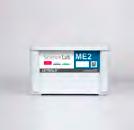




Student experiment set of the student experiment system Science Lab in the field of physics. Set-up material for one working group in pre-formed tray With the equipment set ME2, together with the Science Lab Physics Basic PB (207 100S), 41 experiments at school, college and university level for worldwide curriculums can be performed.
The students deal with the topics forces, simple machines and oscillations. While working out the curriculum required topics, they are also trained in communication and assessment skills. In combination with the Mobile-CASSY 2 WiFi (524 005W2), there are additional evaluation options which enable the students digital learning.
1
1

n The term “lever” is illustrated with the help of a beam scale
n Versatile assembly options with our rollers: from fixed rollers to pulleys and gear units
n Experiments with manual induction of vibrations are equally possible as with controlled frequency (using an additional motor)
n Acquired skills: setting up more complex experiments



Mobile-CASSY 2 WiFi
DIGITAL CLASS / EDUCATION
The universal student measuring device with WiFi for all measuring tasks in physics, chemistry and biology.
524 005W2 Mobile-CASSY 2 WiFi
Detailed information on the Mobile-CASSY 2 WLAN can be found on the Internet at www.leybold-shop.com/524005W2
For measuring force components up to ±50 N (e.g. spring pendulum or centrifugal force components) with Mobile-CASSY 2 WiFi (524 005W2). Its rigid design enables the measurement of force components in any position of the force sensor.
524 434 Force sensor M, ±50 N
Cascadable photoelectric barrier for measuring period durations, travelling time, paths and velocities on the student track or during free fall with Mobile-CASSY 2 WiFi (524 005W2).
524 431 Light barrier M
Detailed information on these and other sensors can be found on the Internet at www.leybold-shop.com
Here you will find an overview of our literature packages. You can find detailed information on our literature on the internet at www.leybold-shop.com.

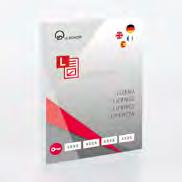

LIT-print: LP1.2 Forces, simple machines and oscillations
Detailed experiment instructions relating to Science Lab Set ME2 (207 112S) and Science Lab Physics Basic PB (207 100S). Describes 41 experiments from the fields of forces, simple machines and oscillations. Topics:
Mechanics of solid bodies; Deformation due to a force; Composition and decomposition of forces; Levers; Pulley and inclined plane; Harmonic oscillations; Forced oscillations and standing waves; Superposition of waves
520 7112EN LIT-print: LP1.2 Forces, simple machines and oscillations
Comprehensive physics experiment instructions in the field of mechanics for the Science Lab. Contains 97 experiments on measuring methods, properties of matter and liquid; forces, simple machines and oscillations; linear motion, free fall and collisions experiments; acoustics.
Includes all interactive experiment instructions (Lab Docs) as html file.
520 711 LIT-digital: LP1 Science Lab Mechanics
Comprehensive physics experiment instructions for the Science Lab. Contains more than 460 experiments in the fields of mechanics, energy, electricity and electronics, optics, atomic and nuclear physics as well as informatics and technology.
Includes all interactive experiment instructions (Lab Docs) as html file.
520 71 LIT-digital: LP Science Lab Physics
Technical data of the digital version:
• Product key for literature (activation & selection of one literature language in LeyLab)
• Can then be used in LeyLab and Document Center (school/institute licence)
• System requirements:
Document Center:
- PC with Windows 7 or higher; internet access during installation; local network for distribution to students LeyLab:
- PC, tablet or smartphone with a current browser; internet access





The fantastic four
INCLINED PLANE




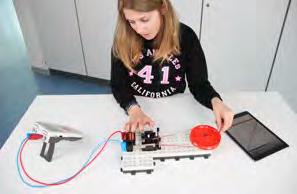


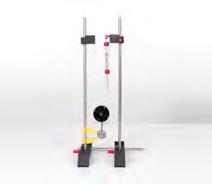


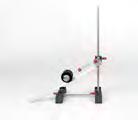
The pulley is also used in student experiments on electricity.
LP1.3.1 Uniform motion
LP1.3.1.1C
LP1.3.1.2C
Relation between distance and time (with Mobile-CASSY 2 WiFi)
Effect of friction - measurement of speeds (with Mobile-CASSY 2 WiFi)
LP1.3.2 Uniformly accelerated motion
LP1.3.2.1C
LP1.3.2.2C
LP1.3.2.3C
LP1.3.2.4C
Relation between distance and time (with Mobile-CASSY 2 WiFi)
Instantaneous speed (with Mobile-CASSY 2 WiFi)
Uniformly accelerated motion using a spoked wheel (with Mobile-CASSY 2 WiFi)
Relation between velocity and time (with Mobile-CASSY 2 WiFi)
LP1.3.3 Newton‘s laws
LP1.3.3.1C
LP1.3.3.2C
Relation between force and acceleration (with Mobile-CASSY 2 WiFi)
Relation between mass and acceleration (with Mobile-CASSY 2 WiFi)
LP1.3.4 Free fall
LP1.3.4.1C
LP1.3.4.2C
Determining the acceleration of gravity by plotting a s(t) diagram (with Mobile-CASSY 2 WiFi)
Determining the acceleration of gravity by plotting a v(t) diagram (with Mobile-CASSY 2 WiFi)
LP1.3.5 Experiments on elastic collisions
LP1.3.5.1C
LP1.3.5.2C
LP1.3.5.3C
LP1.3.5.4C
Elastic collisions between two moving trolleys of equal mass (with Mobile-CASSY 2 WiFi)
Elastic collisions between moving and stationary trolleys of equal mass (with Mobile-CASSY 2 WiFi)
Elastic collisions between moving and stationary trolleys (m1 < m2) (with Mobile-CASSY 2 WiFi)
Elastic collisions between moving and stationary trolleys (m1 > m2) (with Mobile-CASSY 2 WiFi)
LP1.3.6 Experiments on inelastic collisions
LP1.3.6.1C
LP1.3.6.2C
LP1.3.6.3C
LP1.3.6.4C
Inelastic collisions between two moving trolleys of equal mass (with Mobile-CASSY 2 WiFi)
Inelastic collisions between moving and stationary trolleys of equal mass (with Mobile-CASSY 2 WiFi)
Inelastic collisions between moving and stationary trolleys (m1 < m2) (with Mobile-CASSY 2 WiFi)
Inelastic collisions between moving and stationary trolleys (m1 > m2) (with Mobile-CASSY 2 WiFi)
LP1.3.7 Conservation of momentum
LP1.3.7.1C
LP1.3.7.2C
Explosive collisions in the case of trolleys of equal mass (with Mobile-CASSY 2 WiFi)
Explosive collisions in the case of trolleys of different mass (with Mobile-CASSY 2 WiFi)


LP1.3.4.1C Determining the acceleration of gravity by plotting a s(t) diagram
OVERVIEW
LP1.3 LINEAR MOTION, FREE FALL AND COLLISION EXPERIMENTS
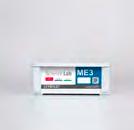




Student experiment set of the student experiment system Science Lab in the field of physics. Set-up material for one working group in pre-formed tray With the equipment set ME3, together with the Mobile-CASSY 2 WiFi (524 005W2), 20 experiments at school, college and university level for worldwide curriculums can be performed. The students deal with the topics dynamic and motion. While working out the curriculum required topics, they are also trained in communication and assessment skills. And the combination with the Mobile-CASSY 2 WiFi (524 005W2) enables the students to learn digitally.
Scope of delivery:

n Light barrier with flexible mounting, e.g. for spoke wheel or start release (very precise switching due to small opening)
n Cascadable light barriers are included in the set
n Experiments in horizontal construction (Movements on a track) and in vertical construction (Free fall) possible
n Light precision metal rail is easy to handle and available in different lengths
n Trolley with low-friction operation, protected wheel bearings and roll-away protection
n Elastic and inelastic collision

The universal student measuring device with WiFi for all measuring tasks in physics, chemistry and biology.
Detailed information on the Mobile-CASSY 2 WLAN can be found on the Internet at www.leybold-shop.com/524005W2

Cascadable photoelectric barrier for measuring period durations, travelling time, paths and velocities on the student track or during free fall with Mobile-CASSY 2 WiFi (524 005W2).
Here you will find an overview of our literature packages. You can find detailed information on our literature on the internet at www.leybold-shop.com.



LIT-print: LP1.3 Linear motion, free fall & collision experiments
Detailed experiment instructions relating to Science Lab Set ME3 (207 113S). Describes 20 experiments from the fields of linear motion, free fall and collision experiments.
Topics:
Uniform motion; Uniformly accelerated motion; Newton’s laws; Free fall; Experiments on elastic collisions; Experiments on inelastic collisions; Conservation of momentum
520 7113EN LIT-print: LP1.3 Linear motion, free fall and collision experiments
Comprehensive physics experiment instructions in the field of mechanics for the Science Lab. Contains 97 experiments on measuring methods, properties of matter and liquid; forces, simple machines and oscillations; linear motion, free fall and collisions experiments; acoustics.
Includes all interactive experiment instructions (Lab Docs) as html file.
Comprehensive physics experiment instructions for the Science Lab. Contains more than 460 experiments in the fields of mechanics, energy, electricity and electronics, optics, atomic and nuclear physics as well as informatics and technology.
Includes all interactive experiment instructions (Lab Docs) as html file.
520 71 LIT-digital: LP Science Lab Physics
Technical data of the digital version:
• Product key for literature (activation & selection of one literature language in LeyLab)
• Can then be used in LeyLab and Document Center (school/institute licence)
• System requirements:
Document Center:
- PC with Windows 7 or higher; internet access during installation; local network for distribution to students LeyLab:
- PC, tablet or smartphone with a current browser; internet access





INTRODUCING THE TOPIC
Experiment LP1.3.2.3C
Uniformly accelerated motion using a spoked wheel
n With sample answers and example measurements
n While measuring, live measured values are transferred from the Mobile-CASSY 2 WiFi to the Lab Doc and ...
n displayed in the interactive measuring instruments, tables and diagrams in real time

In our example, you can see the currently measured distance s = 0.285 m both in the Mobile-CASSY 2 WiFi display and in the Lab Doc.

Experiments on uniform and accelerated motion and experiments on collisions
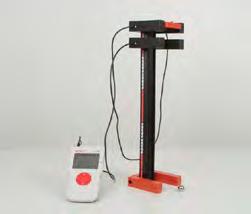

Free fall experiments
n Devices such as the light barrier are used in many experiments and are familiar to students, meaning it takes less time to set up the experiment n Efficient use of materials
Sensors
LP1.4.1 Propagation of sound
LP1.4.1.1
LP1.4.1.2
LP1.4.1.3
Propagation of sound in the air
Propagation of sound in solids
Propagation of sound in water
LP1.4.2 Oscillations and sounds
LP1.4.2.1
LP1.4.2.2
LP1.4.2.3
LP1.4.2.4
LP1.4.2.5C
Oscillations of a tuning fork 1
Oscillations of a tuning fork 2
Sound generation 1
Sound generation 2
Oscillation patterns (with Mobile-CASSY 2 WiFi)
LP1.4.3 Noise analysis
LP1.4.3.1C
LP1.4.3.2
LP1.4.3.3
LP1.4.3.3C
LP1.4.3.4
LP1.4.3.4C
LP1.4.3.5C
Measuring sound levels (with Mobile-CASSY 2 WiFi)
Noise vs. music
Noise protection
Noise protection (with Mobile-CASSY 2 WiFi)
Reflection of sound
Reflection of sound (with Mobile-CASSY 2 WiFi)
Measurement of frequencies (with Mobile-CASSY 2 WiFi)
LP1.4.4 Resonance and beating
LP1.4.4.1
LP1.4.4.2
LP1.4.4.3
LP1.4.4.3C
Resonating bodies
Transmitter-receiver principle
Beat
Beat (with Mobile-CASSY 2 WiFi)
LP1.4.5 Speed of sound
LP1.4.5.1C
LP1.4.5.2C
Measurement of the speed of sound (with Mobile-CASSY 2 WiFi)
Measurement of the speed of sound with 2 microphones (with Mobile-CASSY 2 WiFi)







Student experiment set of the student experiment system Science Lab in the field of physics. Set-up material for one working group in pre-formed tray With the equipment set ME4, 21 experiments at school, college and university level for worldwide curriculums can be performed. The students deal with the topics acoustic oscillations and sound. While working out the curriculum required topics, they are also trained in communication and assessment skills. In combination with the Mobile-CASSY 2 WiFi (524 005W2), there are additional evaluation options which enable the students digital learning.
Scope of delivery:
1
1
1
1
1
1

n With Mobile-CASSY 2 WiFi and the microphone M, even challenging acoustics experiments are possible (e.g. vibrations)
n Investigation of own materials during noise analysis possible
n Acquired skills: Comparison of self-measured values with literature values using the speed of sound
STUDENT MEASURING


Mobile-CASSY 2 WiFi
DIGITAL CLASS / EDUCATION
The universal student measuring device with WiFi for all measuring tasks in physics, chemistry and biology.
524 005W2 Mobile-CASSY 2 WiFi
Detailed information on the Mobile-CASSY 2 WLAN can be found on the Internet at www.leybold-shop.com/524005W2
Microphone M
For measuring sound level, frequency and the voltage of acoustic signals with Mobile-CASSY 2 WiFi (524 005W2).
524 442
Microphone M
Detailed information on this and other sensors can be found on the Internet at www.leybold-shop.com
Here you will find an overview of our literature packages. You can find detailed information on our literature on the internet at www.leybold-shop.com.



Detailed experiment instructions relating to Science Lab Set ME4 (207 114S). Describes 21 experiments from the field of acoustics.
Topics:
Propagation of sound; Oscillations and sounds; Noise analysis; Resonance and beating; Speed of sound
520 7114EN LIT-print: LP1.4 Acoustics
Comprehensive physics experiment instructions in the field of mechanics for the Science Lab. Contains 97 experiments on measuring methods, properties of matter and liquid; forces, simple machines and oscillations; linear motion, free fall and collisions experiments; acoustics.
Includes all interactive experiment instructions (Lab Docs) as html file.
520 711 LIT-digital: LP1 Science Lab Mechanics
Comprehensive physics experiment instructions for the Science Lab. Contains more than 460 experiments in the fields of mechanics, energy, electricity and electronics, optics, atomic and nuclear physics as well as informatics and technology.
Includes all interactive experiment instructions (Lab Docs) as html file.
520 71 LIT-digital: LP Science Lab Physics
Technical data of the digital version:
• Product key for literature (activation & selection of one literature language in LeyLab)
• Can then be used in LeyLab and Document Center (school/institute licence)
• System requirements:
Document Center:
- PC with Windows 7 or higher; internet access during installation; local network for distribution to students LeyLab:
- PC, tablet or smartphone with a current browser; internet access





INTRODUCING THE TOPIC

Explore well-known everyday experiences and physical phenomena using digital measuring devices

n The beats resulting from the superposition of two oscillations can be measured and displayed easily on Mobile-CASSY 2 WiFi
n The complex graph with increasing and decreasing amplitude can only be detected digitally and with a fast measuring system

n Automatic recognition of microphone M sensor
n Easy connection to Lab Doc “Beats”
n Settings imported from Lab Doc
n Quick recording of measured values
n Measured values are directly transferred to the Lab Doc tables and diagrams
n Students have the measured values and the beat corresponding graph visualisation in their own digital protocol
n Can also be used as a standalone device with its large, graphics-capable display for high-contrast diagrams
Energy is a topic that everyone has heard of. On the one hand, our Science Lab deals with the classic field of heat and, on the other hand, it also looks at renewable energies. The storage of energy with a fuel cell is additionally included. Section by section, the various components are examined in the experiments, ultimately setting up and tracing entire energy chains in one experiment.
One Basic Set and three Energy Sets provide three topic areas with a total of 85 experiments. The optimum selection of experiments, suitable for all academic years, is designed so that the experiments can be conducted qualitatively and quantitatively. Additionally, there is a high level of relevance for everyday life in the topic of renewable energies, thus providing a lot of motivation for students.

EXPERIMENT TOPICS
LP2.1 HEAT
LP2.1.1 EXPANSION OF HEAT
LP2.1.2 HEAT TRANSFER
LP2.1.3 THERMAL INSULATION
LP2.1.4 HEAT CAPACITIES
LP2.1.5 AGGREGATION STATES AND TRANSITIONS
LP2.2 RENEWABLE ENERGIES
LP2.2.1 SOLAR ENERGY
LP2.2.2 WIND ENERGY
LP2.2.3 PELTIER EFFECT
LP2.2.4 ENERGY STORAGE
LP2.2.5 ENERGY CONVERSION AND EFFICIENCY
LP2.3 FUEL CELLS
LP2.3.1 REVERSIBLE PEM FUEL CELL
LP2.3.2 THE ELECTROLYSER
LP2.3.3 THE FUEL CELL





Further information about our curriculum-compliant topics and student experiments as well as the corresponding sets can be found on the following pages.
LP2.1.1 Expansion of heat
LP2.1.1.1
LP2.1.1.2
LP2.1.1.3
LP2.1.1.4
LP2.1.1.5
LP2.1.1.6
LP2.1.1.6C
Thermal properties of water
Calibration of a thermometer
Linear expansion of solids
Thermal properties of a bimetal
Heating air (at a constant pressure) Boyle-Mariotte
Heating air (at constant volume)
Heating air (at constant volume) (with Mobile-CASSY 2 WiFi)
LP2.1.2 Heat transfer
LP2.1.2.1
LP2.1.2.2
LP2.1.2.3
LP2.1.2.3C
LP2.1.2.4C
LP2.1.2.5
Heat sensitivity
Heat transfer in fluids
Temperature dependence of the Brownian molecular movement
Temperature dependence of the Brownian molecular movement (with Mobile-CASSY 2 WiFi)
Thermal conductivity in solid bodies (with Mobile-CASSY 2 WiFi)
Heat transfer in gases
LP2.1.3 Thermal insulation
LP2.1.3.1
LP2.1.3.1C
LP2.1.3.2
LP2.1.3.2C
LP2.1.3.3
LP2.1.3.3C Heating of water
Heating of water (with Mobile-CASSY 2 WiFi)
Cooling of water
Cooling of water (with Mobile-CASSY 2 WiFi)
Assembling a calorimeter
Assembling a calorimeter (with Mobile-CASSY 2 WiFi)
LP2.1.4 Heat capacities
LP2.1.4.1
LP2.1.4.1C
LP2.1.4.2
LP2.1.4.2C
LP2.1.4.3
LP2.1.4.3C
LP2.1.4.4
LP2.1.4.4C
Temperature of mixtures
Temperature of mixtures (with Mobile-CASSY 2 WiFi)
Specific heat capacity of water
Specific heat capacity of water (with Mobile-CASSY 2 WiFi)
Specific heat capacity of solid bodies
Specific heat capacity of solid bodies (with Mobile-CASSY 2 WiFi)
Heat capacity of a calorimeter
Heat capacity of a calorimeter (with Mobile-CASSY 2 WiFi)
LP2.1.5 Aggregation states and transitions
LP2.1.5.1
LP2.1.5.1C
LP2.1.5.2
LP2.1.5.2C
LP2.1.5.3
LP2.1.5.3C
LP2.1.5.4
LP2.1.5.4C
LP2.1.5.5
Temperature changes during heating
Temperature changes during heating (with Mobile-CASSY 2 WiFi)
Fusion heat of ice
Fusion heat of ice (with Mobile-CASSY 2 WiFi)
Condensation of steam
Condensation of steam (with Mobile-CASSY 2 WiFi)
Temperatures of water-salt mixtures
Temperatures of water-salt mixtures (with Mobile-CASSY 2 WiFi)
36 EXPERIMENTS For experiments marked with „C“, the measurements are carried out digitally with the Mobile-CASSY 2 WiFi.
Distillation

Students will investigate thermal conductivity in solid bodies. They will monitor heat transfer from a warm to a cold water bath. Copper and steel are the materials used. For this experiment you will need the sets Science Lab Physics Basic PB (207 100S) and Science Lab Energy EG1 (207 121S)






Student experiment set of the student experiment system Science Lab in the field of physics. Set-up material for one working group in pre-formed tray With the equipment set EG1, together with the Science Lab Physics Basic PB (207 100S), 36 experiments at school, college and university level for worldwide curriculums can be performed.
The students deal with the topics heat. While working out the curriculum required topics, they are also trained in communication and assessment skills. In combination with the Mobile-CASSY 2 WiFi (524 005W2), there are additional evaluation options which enable the students digital learning.
Scope of delivery:
Count Name
1 Bosshead S
1 Colouring, red, 10 g
1 Funnel PE 40 mm Ø
1 Double scale
1 Double pipe support
2 Transparent tube with 2 caps
1 Plastic riser tube
1 Bimetallic strip
1 Pointer for linear expansion 1 Aluminium
1 Stirring thermometer -30...+110 °C, ungraduated
1 Stirring thermometer -10...+110 °C
1 Lid for glass calorimeter
1 Heat conducting rod steel
Name
Glass calorimeter
Blade wheel
Measuring cylinder 100 ml
Immersion heater 12 V/10 W
Wire gauze 120 mm x 120 mm
Tray, high
Beaker, Boro 3.3, 250 ml, squat
Petri dish 60 mm
Erlenmeyer flask, Boro 3.3, 50 ml, narrow neck
Connector, straight, 6/8 mm Ø
Universal clamp 0...80 mm
Stand ring with stem 100 mm Ø
Silicone tubing 7 mm Ø, 1 m


n Investigation of linear expansion and thermal conduction of various materials
n Understanding the functions of a calorimeter
n STEM experiments for heat insulation
STUDENT MEASURING DEVICE


The universal student measuring device with WiFi for all measuring tasks in physics, chemistry and biology.
524 005W22 Mobile-CASSY 2 WiFi
Detailed information on the Mobile-CASSY 2 WLAN can be found on the Internet at www.leybold-shop.com/524005W2
Temperature probe NiCr-Ni, type K
Already included in the scope of delivery of the Mobile-CASSY 2 WiFi (524 005W2).
INCLUDED IN SCOPE OF DELIVERY
Additionally required per student Count Cat.-No.
1 610 010 Laboratory safety goggles, Focomax
Additionally required per working group
1 207 100S Science Lab Physics Basic PB (Set)
1
1 524 005W2 Mobile-CASSY 2 WiFi for digital experiments
1 607 020 Safety gas hose with clamp 0.5 m Heat experiments (LP2.1.1, LP2.1.2)
1 656 017 Teclu burner, universal Heat experiments (LP2.1.1, LP2.1.2)
Additionally required per class
1 520 712 LIT-digital: LP2 Science Lab Energy Detailed information on literature packages are available on the following pages.
Here you will find an overview of our literature packages. You can find detailed information on our literature on the internet at www.leybold-shop.com.



Detailed experiment instructions relating to Science Lab Set EG1 (207 121S) and Science Lab Physics Basic PB (207 100S). Describes 36 experiments from the field of heat.
Topics:
Expansion of heat; Heat transfer; Thermal insulation; Heat capacities; Aggregation states and transitions
520 7121EN LIT-print: LP2.1 Heat
Comprehensive physics experiment instructions in the field of energy for the Science Lab. Contains 85 experiments on heat, renewable energies and fuel cells.
Includes all interactive experiment instructions (Lab Docs) as html file.
520 712 LIT-digital: LP2 Science Lab Energy
Comprehensive physics experiment instructions for the Science Lab. Contains more than 460 experiments in the fields of mechanics, energy, electricity and electronics, optics, atomic and nuclear physics as well as informatics and technology.
Includes all interactive experiment instructions (Lab Docs) as html file.
520 71 LIT-digital: LP Science Lab Physics
Technical data of the digital version:
• Product key for literature (activation & selection of one literature language in LeyLab)
• Can then be used in LeyLab and Document Center (school/institute licence)
• System requirements:
Document Center:
- PC with Windows 7 or higher; internet access during installation; local network for distribution to students LeyLab:
- PC, tablet or smartphone with a current browser; internet access





n The measured values can either be entered manually in own Lab Doc or
n They can be transferred directly into the Lab Doc via a connection with the Mobile-CASSY 2 WiFi
n The diagram “Height of the water drop depending on the water bath temperature” is automatically completed with the entered measured values
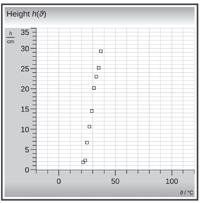

The students investigate the correlation between temperature and volume changes in the air under constant pressure (Gay-Lussac’s Law).

LP2.2.1 Solar energy
LP2.2.1.1
LP2.2.1.1C
LP2.2.1.2
LP2.2.1.2C
LP2.2.1.3
LP2.2.1.3C
LP2.2.1.4
LP2.2.1.4C
LP2.2.1.5
LP2.2.1.5C
LP2.2.1.6
LP2.2.1.6C
Black and white bodies
Black and white bodies (with Mobile-CASSY 2 WiFi)
Absorption of heat radiation
Absorption of heat radiation (with Mobile-CASSY 2 WiFi)
Greenhouse effect
Greenhouse effect (with Mobile-CASSY 2 WiFi)
Solar cell circuits
Solar cell circuits (with Mobile-CASSY 2 WiFi)
Examination of a solar module as a function of distance
Examination of a solar module as a function of distance (with Mobile-CASSY 2 WiFi)
Examination of a solar module as a function of the angle of incidence
Examination of a solar module as a function of the angle of incidence (with Mobile-CASSY 2 WiFi)
LP2.2.2 Wind energy
LP2.2.2.1
LP2.2.2.1C
LP2.2.2.2
LP2.2.2.2C
LP2.2.2.3
LP2.2.2.3C
LP2.2.2.4
LP2.2.2.4C
Measuring the voltage of a wind turbine
Measuring the voltage of a wind turbine (with Mobile-CASSY 2 WiFi)
Wind turbine with different blades
Wind turbine with different blades (with Mobile-CASSY 2 WiFi)
Wind turbine with varying number of blades
Wind turbine with varying number of blades (with Mobile-CASSY 2 WiFi)
Wind turbine with varying blade angles
Wind turbine with varying blade angles (with Mobile-CASSY 2 WiFi)
LP2.2.3 Peltier effect
LP2.2.3.1
LP2.2.3.1C
LP2.2.3.2
Examination of a Peltier element as a heat pump
Examination of a Peltier element as a heat pump (with Mobile-CASSY 2 WiFi)
Examination of a Peltier element as a voltage source
LP2.2.4 Energy storage
LP2.2.4.1
LP2.2.4.1C
Charging a capacitor
Charging a capacitor (with Mobile-CASSY 2 WiFi)
LP2.2.5 Energy conversion and efficiency
LP2.2.5.1
LP2.2.5.2
LP2.2.5.3
LP2.2.5.3C
Operating a motor using a solar module
Operating a lamp using a solar module
Operating a lamp using a generator
Operating a lamp using a generator (with Mobile-CASSY 2 WiFi)
For experiments marked with „C“, the measurements are carried out digitally with the Mobile-CASSY 2 WiFi.
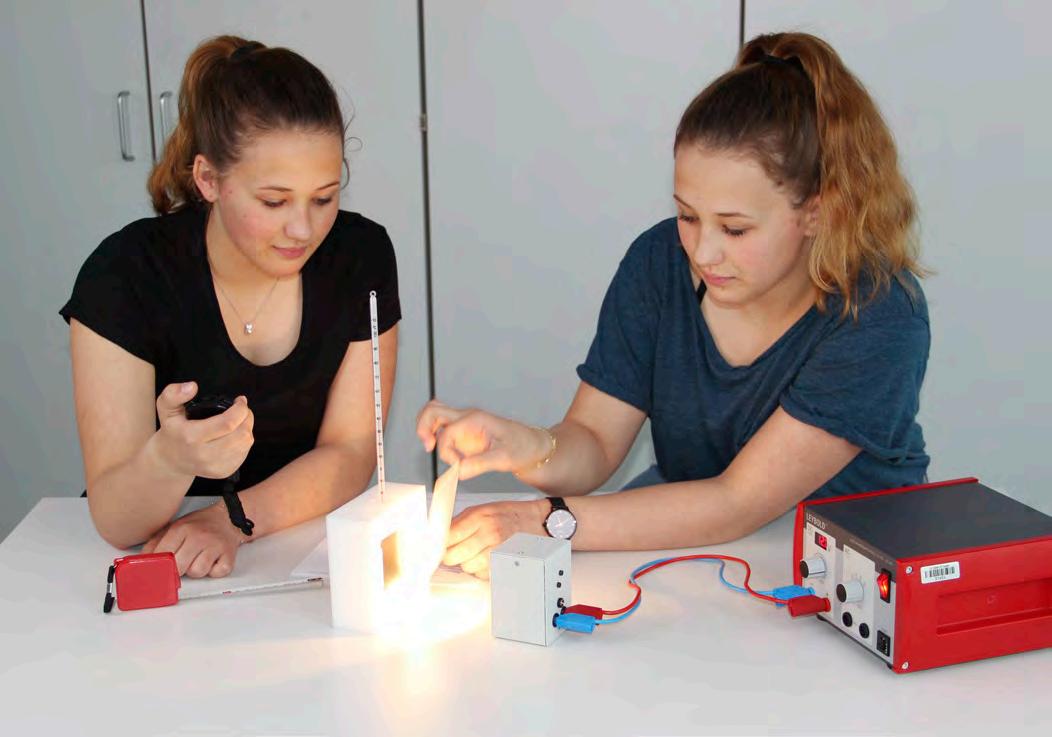





Student experiment set of the student experiment system Science Lab in the field of physics. Set-up material for one working group in pre-formed tray With the equipment set EG2 (207 122S), 29 experiments at school, college and university level for worldwide curriculums can be performed. The students deal with the topic renewable energies. While working out the curriculum required topics, they are also trained in communication and assessment skills. In combination with the Mobile-CASSY 2 WiFi (524 005W2), there are additional evaluation options which enable the students digital learning.
Scope of delivery:
Count Name
1 Tape measure 2 m / 1 mm
2 Stirring thermometer -10...+110 °C
1 Light source 12 V
1 Photovoltaic module
1 Wind machine
1 Wind wheel
1 Peltier element in tank
1 Insulating housing for Leslie body
1 Leslie body
1 Rotor blades, set
2 Safety connecting lead 50 cm, red
Count Name
2 Safety connecting lead 50 cm, blue 1 Safety connecting lead 50 cm, black 1 out of Bulb 2.5 V/0.25 W, E10, set of 10 1 Plug-in board safety socket, 20/10 1 Capacitor (electrolytic) 1 F, STE 2/19
1 Lamp holder, E10, top, STE 2/19
1 Immersion heater 12 V/10 W 1 Tray, high
Beaker PP, 100 ml, squat
Stopwatch


n STEM experiments for renewable energies
n Examination of a wind turbine with regard to shape, number and inclination of the rotors
n Simulation of the greenhouse effect
n Acquired skills: Applying technical language to everyday situations


The universal student measuring device with WiFi for all measuring tasks in physics, chemistry and biology.
Detailed information on the Mobile-CASSY 2 WLAN can be found on the Internet at www.leybold-shop.com/524005W2
Temperature probe NiCr-Ni, type K
Already included in the scope of delivery of the Mobile-CASSY 2 WiFi (524 005W2).
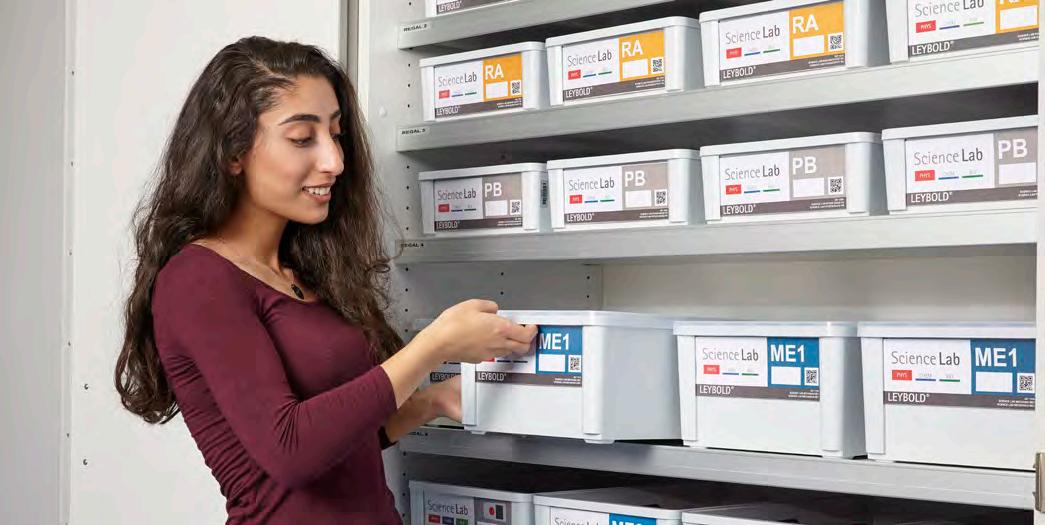
Here you will find an overview of our literature packages. You can find detailed information on our literature on the internet at www.leybold-shop.com.



LIT-print: LP2.2 Renewable energies
Detailed experiment instructions relating to Science Lab Set EG2 (207 122S). Describes 29 experiments from the field of renewable energies.
Topics: Solar energy; Wind energy; Peltier effect; Energy storage; Energy conversion and efficiency
520 7122EN LIT-print: LP2.2 Renewable energies
LIT-digital: LP2 Science Lab Energy
Comprehensive physics experiment instructions in the field of energy for the Science Lab. Contains 85 experiments on heat, renewable energies and fuel cells.
Includes all interactive experiment instructions (Lab Docs) as html file.
520 712 LIT-digital: LP2 Science Lab Energy
LIT-digital: LP Science Lab Physics
Comprehensive physics experiment instructions for the Science Lab. Contains more than 460 experiments in the fields of mechanics, energy, electricity and electronics, optics, atomic and nuclear physics as well as informatics and technology.
Includes all interactive experiment instructions (Lab Docs) as html file.
520 71 LIT-digital: LP Science Lab Physics
Technical data of the digital version:
• Product key for literature (activation & selection of one literature language in LeyLab)
• Can then be used in LeyLab and Document Center (school/institute licence)
• System requirements:
Document Center:
- PC with Windows 7 or higher; internet access during installation; local network for distribution to students LeyLab:
- PC, tablet or smartphone with a current browser; internet access





An
n Topic areas: Solar energy, wind energy, energy storage and energy conversion
n Hands-on experiments using tangible objects such as the solar module or the miniature wind turbine with the wind machine
n Qualitative investigations and quantitative measurements with digital measuring technology and the help of interactive experiment instructions
n Students experience:
n Structure and functionality of systems for energy production
n The laws of physics in relation to energy conversion, production and storage
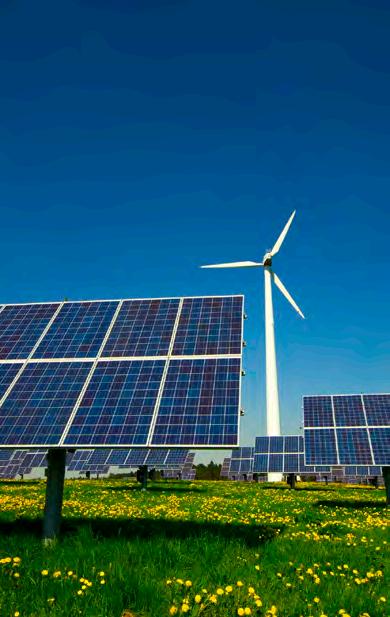

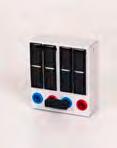
n Solar cells and solar modules
n The conversion of radiation energy (energy from the sun) into electrical energy
n Dependencies on the illumination intensity (distance from the sun) and the angle of incidence (orientation to the sun)
n The conversion of mechanical energy (wind energy) into electrical energy
n The influence of shape, number and adjustment angle of different rotor blades
n Realistic evaluation of efficiency

LP2.3.1 Reversible PEM fuel cell
LP2.3.1.1 Preparation of a fuel cell
LP2.3.2 The electrolyser
LP2.3.2.1
LP2.3.2.2
LP2.3.2.3
LP2.3.2.3C
LP2.3.2.4
LP2.3.2.4C
LP2.3.2.5
LP2.3.2.5C
LP2.3.2.6
LP2.3.2.6C
Using a reversible fuel cell as an electrolyser
Operating an electrolyser using a solar cell
Characteristic curve of the electrolyser
Characteristic curve of the electrolyser (with Mobile-CASSY 2 WiFi)
Faraday’s first law of electrolysis on the electrolyser
Faraday’s first law of electrolysis on the electrolyser (with Mobile-CASSY 2 WiFi)
Determining the Faraday constant
Determining the Faraday constant (with Mobile-CASSY 2 WiFi)
Energy efficiency on the electrolyser
Energy efficiency on the electrolyser (with Mobile-CASSY 2 WiFi)
LP2.3.3 The fuel cell
LP2.3.3.1
LP2.3.3.2
LP2.3.3.3
LP2.3.3.3C
LP2.3.3.4
LP2.3.3.4C
LP2.3.3.5
LP2.3.3.6
LP2.3.3.6C
Conversion of hydrogen and oxygen in a fuel cell
Operating a motor using a fuel cell
Characteristic curve and performance of a fuel cell
Characteristic curve and performance of a fuel cell (with Mobile-CASSY 2 WiFi)
Efficiency of a fuel cell
Efficiency of a fuel cell (with Mobile-CASSY 2 WiFi)
Energy storage
Efficiency of the system: electrolyser and fuel cell
Efficiency of the system: electrolyser and fuel cell (with Mobile-CASSY 2 WiFi)
experiments marked with „C“, the measurements are carried out digitally with the Mobile-CASSY 2 WiFi.






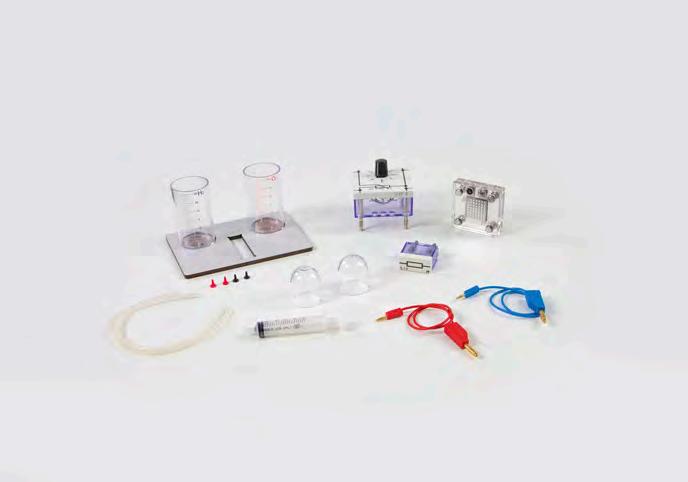
Student experiment set of the student experiment system Science Lab in the field of physics. Set-up material for one working group. The equipment is stored in Science Lab Energy EG2 (207 122S). With the equipment set EG3 (207 123S), together with the Science Lab Energy EG2 (207 122S), 20 experiments at school, college and university level for worldwide curriculums can be performed. The students deal with the topics fuel cells. While working out the curriculum required topics, they are also trained in communication and assessment skills. In combination with the Mobile-CASSY 2 WiFi (524 005W2), there are additional evaluation options which enable the students digital learning.
Scope of delivery:


n Students build models of energy chains
n Included: PEM (electrolyser and fuel cell combined)
n Acquired skills: Getting to know the storage possibilities of renewable energies

2 WiFi
The universal student measuring device with WiFi for all measuring tasks in physics, chemistry and biology.
Detailed information on the Mobile-CASSY 2 WLAN can be found on the Internet at www.leybold-shop.com/524005W2

Here you will find an overview of our literature packages. You can find detailed information on our literature on the internet at www.leybold-shop.com.



Detailed experiment instructions relating to Science Lab Set EG3 (207 123S). Describes 20 experiments from the field of fuel cells.
Topics: Reversible PEM fuel cell; The electrolyser; The fuel cell
520 7123EN LIT-print: LP2.3 Fuell cells
LIT-digital:
Comprehensive physics experiment instructions in the field of energy for the Science Lab. Contains 85 experiments on heat, renewable energies and fuel cells.
Includes all interactive experiment instructions (Lab Docs) as html file.
520 712 LIT-digital: LP2 Science Lab Energy
Comprehensive physics experiment instructions for the Science Lab. Contains more than 460 experiments in the fields of mechanics, energy, electricity and electronics, optics, atomic and nuclear physics as well as informatics and technology.
Includes all interactive experiment instructions (Lab Docs) as html file.
520 71 LIT-digital: LP Science Lab Physics
Technical data of the digital version:
• Product key for literature (activation & selection of one literature language in LeyLab)
• Can then be used in LeyLab and Document Center (school/institute licence)
• System requirements:
Document Center:
- PC with Windows 7 or higher; internet access during installation; local network for distribution to students LeyLab:
- PC, tablet or smartphone with a current browser; internet access





n Learning about the technology of the future through student experiments
n Fuel cells and their properties
n Electrolysers for splitting water into its elements
n Conversion between chemical and electrical energy with a reversible PEM fuel cell
n Efficiency and assignments on energy storage and energy transportation
n Solution-orientated learning with reference to everyday life, e.g. cars with hydrogen vehicles - advantages and challenges
n Independent qualitative investigations and quantitative measurements with the Mobile-CASSY 2 WiFi as well as the interactive experiment instructions Lab Docs
RENEWABLE ENERGY FOR A FUTURE-PROOF ENERGY SUPPLY

The introduction to Electricity/Electronics for the students usually begins with experiments such as the simple electric circuit. They learn the basic principles that are essential for understanding the experiments based on them.
The use of the innovative, modular plug-in board makes it particularly easy to reduce the experiments to a minimum. The safety sockets on the plug-in board enable the use of safety connecting leads. Five Electrics Sets provide six topic areas with 154 experiments.
The measurements of current and voltage can be carried out both with the Mobile-CASSY 2 WiFi and with multimeters.

LP3.1.7.1C Equipotential lines between identically shaped electrodes
In this experiment, students record the equipotential lines between two identically shaped electrodes by searching for the points of equal potential difference between the 0 V electrode and the steel needle with the Mobile-CASSY 2 WiFi and depict these points on a graph. For this experiment you will need the set Science Lab Electrics EL1 (207 131S)
Further information about our curriculum-compliant topics and student experiments as well as the corresponding sets can be found on the following pages.
EXPERIMENT TOPICS
LP3.1 ELECTROSTATICS
LP3.1.1 CONTACT ELECTRICITY
LP3.1.2 FORCES ACTING BETWEEN CHARGES
LP3.1.3 ELECTROSTATIC INDUCTION
LP3.1.4 CHARGE STORAGE
LP3.1.5 ELECTROSTATIC INTERACTION
LP3.1.6 INSULATORS AND CONDUCTORS
LP3.1.7 EQUIPOTENTIAL LINES
LP3.1.8 PLATE CAPACITOR
LP3.2 MAGNETISM
LP3.2.1 MAGNETIC FORCES AND FIELDS
LP3.2.2 MAGNETIC INDUCTION
LP3.2.3 MAGNETIC FIELDS


LP3.3 BASIC ELECTRICAL CIRCUITS AND ELECTROCHEMISTRY
LP3.3.1 ELECTRICAL CIRCUITS AND SWITCHES
LP3.3.2 ELECTRICAL MEASUREMENT METHODS
LP3.3.3 OHMIC RESISTANCE
LP3.3.4 SPECIAL RESISTORS
LP3.3.5 VOLTAGE SOURCES
LP3.3.6 ELECTRICAL APPLICATION CIRCUITS
LP3.3.7 ELECTROCHEMISTRY
LP3.4 ELECTROMAGNETISM AND INDUCTION
LP3.4.1 ELECTROMAGNETISM
LP3.4.2 ELECTROMAGNETIC APPLICATIONS
LP3.4.3 INDUCTION
LP3.4.4 TRANSFORMERS
LP3.4.5 APPLICATIONS OF INDUCTION
LP3.4.6 COILS IN DIRECT AND ALTERNATING CURRENT CIRUITS
LP3.5 MOTORS AND GENERATORS
LP3.5.1 GENERATORS
LP3.5.2 ELECTRIC MOTORS







EXPERIMENT TOPICS
LP4.1 BASIC ELECTRONIC CIRCUITS
LP4.1.1 CAPACITORS
LP4.1.2 RELAY CIRCUITS
LP4.1.3 DIODES
LP4.1.4 TRANSISTORS
LP4.1.5 DIODE CIRCUITS
LP4.1.6 FLIP-FLOPS
LP4.1.7 AMPLIFIER CIRCUITS
LP4.1.8 SOLAR CELLS


LP3.1.1 Contact electricity
LP3.1.1.1
LP3.1.1.2
LP3.1.1.3
Proof of charge types on friction rods with a glow lamp
Proof of charge types on foils and sheets with a glow lamp
Contact electricity generated by friction
LP3.1.2 Forces acting between charges
LP3.1.2.1
LP3.1.2.2
LP3.1.2.3
Forces acting between charges on friction rods
Forces acting on a charged pendulum pair
Operating principle of an electroscope
LP3.1.3 Electrostatic induction
LP3.1.3.1
LP3.1.3.2
LP3.1.3.3
LP3.1.3.4
Induction phenomena with conductors and non-conductors
Induction phenomena of a pointer
Electric induction on a pair of pendulums
Induction phenomena on an electroscope caused by friction rods
LP3.1.4 Charge storage
LP3.1.4.1
LP3.1.4.2
Conductive bodies as charge storage devices
Proof of charges on a Faraday cup
LP3.1.5 Electrostatic interaction
LP3.1.5.1
LP3.1.5.2
Electrostatic forces between friction rod and pendulum
Charge transfer through a pendulum
LP3.1.6 Insulators and conductors
LP3.1.6.1
LP3.1.6.2
LP3.1.6.3
Charges on insulators
Proof of conductivity with an electroscope Point discharge
LP3.1.7 Equipotential lines
LP3.1.7.1
LP3.1.7.1C
LP3.1.7.2
LP3.1.7.2C
LP3.1.7.3
LP3.1.7.3C
Equipotential lines between identically shaped electrodes
Equipotential lines between identically shaped electrodes (with Mobile-CASSY 2 WiFi)
Equipotential lines between non-identically shaped electrodes
Equipotential lines between non-identically shaped electrodes (with Mobile-CASSY 2 WiFi)
Distortion of equipotential lines
Distortion of equipotential lines (with Mobile-CASSY 2 WiFi)
LP3.1.8 Plate capacitor
LP3.1.8.1
LP3.1.8.1C The electric field in a plate capacitor The electric field in a plate capacitor (with Mobile-CASSY 2 WiFi)

Students will show that the two different charges can be retained on a Faraday cup and detected with the glow lamp. For this experiment you will need the set Science Lab Electrics EL1 (207 131S)
LP3.1 ELECTROSTATICS





Student experiment set of the student experiment system Science Lab in the field of physics. Set-up material for one working group in pre-formed tray With the equipment set EL1 (207 131S), 25 experiments at school, college and university level for worldwide curriculums can be performed. The students deal with the topics electrostatics and electric fields. While working out the curriculum required topics, they are also trained in communication and assessment skills. In combination with the Mobile-CASSY 2 WiFi (524 005W2), there are additional evaluation options which enable the students digital learning.
Scope of delivery:
2
2
3 Adapter 4-mm plug/4-mm
1
1
1 Electroscope
2
1


n Students build their “own” electroscope and learn about its function
n Straightforward experiments for the detection and storage of different charges and electric fields
n All electric and electronic components are in transparent housings for a safe and long term use and labelled with the same electronic symbols as real life devices
n Acquired skills: Design and function of electrical measuring instruments

2 WiFi
The universal student measuring device with WiFi for all measuring tasks in physics, chemistry and biology.
information on the


With the Mobile-CASSY 2 WiFi, voltage (U), current (I), power (P) and energy (E) can be measured via 4 mm safety sockets.
Here you will find an overview of our literature packages. You can find detailed information on our literature on the internet at www.leybold-shop.com.



Detailed experiment instructions relating to Science Lab Set EL1 (207 131S). Describes 25 experiments from the field of electrostatics.
Topics:
Contact electricity; Force acting between charges; Electrostatic induction; Charge storage; Electrostatic interaction; Insulators and conductors; Equipotential lines; Plate capacitor
520 7131EN LIT-print: LP3.1 Electrostatics
LIT-digital: LP3 Science Lab Electricity
Comprehensive physics experiment instructions in the field of electricity for the Science Lab. Contains 154 experiments on electrostatics, magnetism, basic electrical circuits and electrochemistry, electromagnetism and induction, motors and generators and electronics. Includes all interactive experiment instructions (Lab Docs) as html file.
520 713 LIT-digital: LP3 Science Lab Electricity
Comprehensive physics experiment instructions for the Science Lab. Contains more than 460 experiments in the fields of mechanics, energy, electricity and electronics, optics, atomic and nuclear physics as well as informatics and technology. Includes all interactive experiment instructions (Lab Docs) as html file.
520 71 LIT-digital: LP Science Lab Physics
Technical data of the digital version:
• Product key for literature (activation & selection of one literature language in LeyLab)
• Can then be used in LeyLab and Document Center (school/institute licence)
• System requirements:
Document Center:
- PC with Windows 7 or higher; internet access during installation; local network for distribution to students LeyLab:
- PC, tablet or smartphone with a current browser; internet access





Even though the names of the experiments may not sound like fun to students first, the electrostatics experiments vividly illustrate many everyday life experiences.



n Why do I get an electric shock if I touch a metal door after I have walked on carpet with shoes on?
n Why does that seem to be worse with certain shoes than with others?
n Why does hair stick to a balloon if I rub the balloon on my t-shirt first?
LP3.2.1 Magnetic forces and fields
LP3.2.1.1
LP3.2.1.2
LP3.2.1.3
Magnetic and non-magnetic materials
Position of the magnetic poles on a bar magnet Polarity of magnets
LP3.2.2 Magnetic induction
LP3.2.2.1
LP3.2.2.2
LP3.2.2.3
Magnetisation
Disassembling magnets Combining magnets
LP3.2.3 Magnetic fields
LP3.2.3.1
LP3.2.3.2
LP3.2.3.3
LP3.2.3.4
LP3.2.3.5
LP3.2.3.6
Demonstration of a magnetic field with iron powder
Field lines of a bar magnet
Model experiment on the earth’s magnetic field
Field lines of a horseshoe magnet
Field lines of attracting magnetic poles
Field lines of repelling magnetic poles
12
EXPERIMENTS

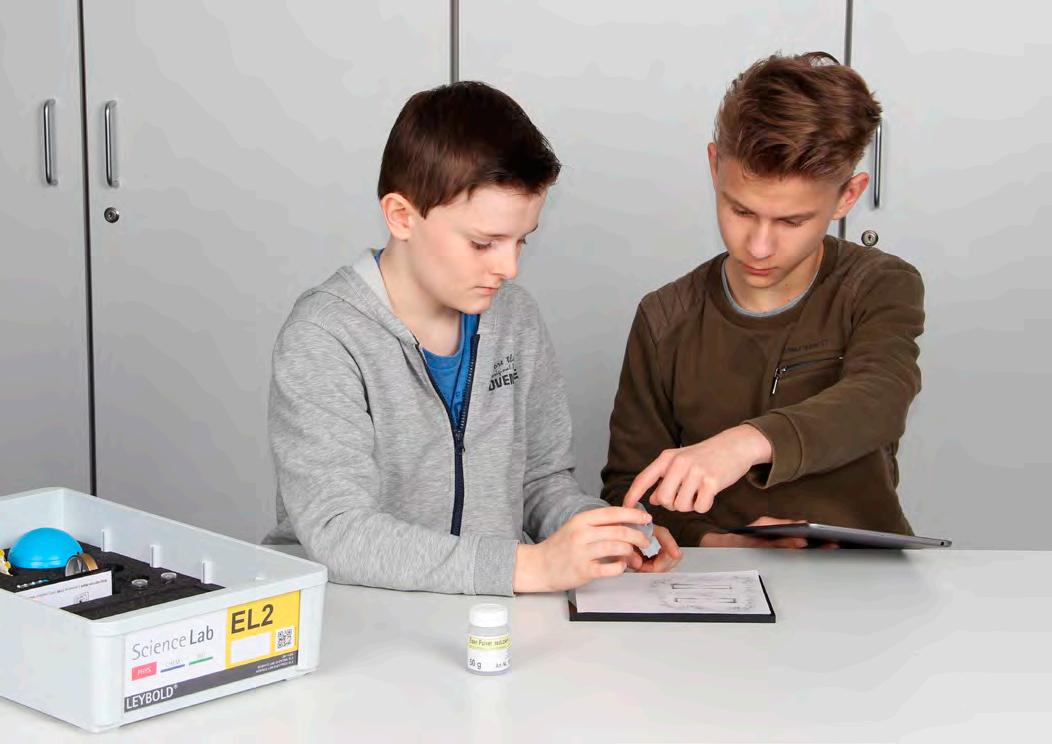





Student experiment set of the student experiment system Science Lab in the field of physics. Set-up material for one working group in pre-formed tray With the equipment set EL2, 12 experiments at school, college and university level for worldwide curriculums can be performed. The students deal with the topic magnetism. While working out the curriculum required topics, they are also trained in communication and assessment skills. In combination with the Mobile-CASSY 2 WiFi (524 005W2), there are additional evaluation options which enable the students digital learning.
Scope of delivery:
Count Name
2 Bar magnet
2 Plotting compass
1 Magnetizable rods, set of 4
1 Hemisphere for earth‘s magnetism
1 Magnetism experimental field
1 Iron yokes, pair
1 Pocket compass
Count Name
Magnetic field indicator
Shaker for iron filings
Cord 207 132S Science Lab Electrics EL2 (Set)
Additionally required per working group
1 510 55 Direction-finding compass
Additionally required per class
Count Cat.-No. Name
1 520 713
LIT-digital: LP3 Science Lab Electricity


n Understandable experiments to distinguish between attracting and repelling magnetic forces which can be visualised with the help of the magnetism experimental field and iron powder
n Investigation of the Earth’s magnetic field in a simple model
n Acquired skills: Explanation of everyday phenomena using simple models

The universal student measuring device with WiFi for all measuring tasks in physics, chemistry and biology.
Detailed information on the Mobile-CASSY 2 WiFi can be found on the Internet at www.leybold-shop.com/524005W2

Here you will find an overview of our literature packages. You can find detailed information on our literature on the internet at www.leybold-shop.com.


LIT-print: LP3.2 Magnetism
Detailed experiment instructions relating to Science Lab Set EL2 (207 132S). Describes 12 experiments from the field of magnetism.
Topics:
Magnetic forces and fields; Magnetic induction; Magnetic fields
520 7132EN LIT-print: LP3.2 Magnetism
Comprehensive physics experiment instructions in the field of electricity for the Science Lab. Contains 154 experiments on electrostatics, magnetism, basic electrical circuits and electrochemistry, electromagnetism and induction, motors and generators and electronics.
Includes all interactive experiment instructions (Lab Docs) as html file.
520 713 LIT-digital: LP3 Science Lab Electricity

Comprehensive physics experiment instructions for the Science Lab. Contains more than 460 experiments in the fields of mechanics, energy, electricity and electronics, optics, atomic and nuclear physics as well as informatics and technology. Includes all interactive experiment instructions (Lab Docs) as html file.
520 71 LIT-digital: LP Science Lab Physics
Technical data of the digital version:
• Product key for literature (activation & selection of one literature language in LeyLab)
• Can then be used in LeyLab and Document Center (school/institute licence)
• System requirements:
Document Center:
- PC with Windows 7 or higher; internet access during installation; local network for distribution to students LeyLab:
- PC, tablet or smartphone with a current browser; internet access





INTRODUCING THE TOPIC
Discover and experience magnetism by yourself

DESCRIBING FIELD LINES AND INTERPRETING THE BEHAVIOUR OF MAGNETS



MAKING MAGNETIC FIELDS VISIBLE

DRAWING CONCLUSIONS ABOUT THE EARTH’S MAGNETIC FIELD
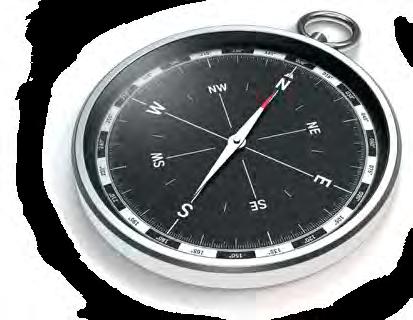
UNDERSTANDING THE FUNCTIONS OF A COMPASS
USING THE HEMISPHERE TO UNDERSTAND THAT THE EARTH IS A DIPOLE
LP3.3.1 Electrical circuits and switches
LP3.3.1.1
LP3.3.1.2
LP3.3.1.3
LP3.3.1.4
LP3.3.1.5
The simple circuit Conductors and non-conductors (insulators)
Switching over Two-way switches AND gate, OR gate
LP3.3.2 Electrical measurement methods
LP3.3.2.1
LP3.3.2.1C
LP3.3.2.2
LP3.3.2.2C
Measuring current intensity in a simple circuit
Measuring current intensity in a simple circuit (with Mobile-CASSY 2 WiFi)
Measuring voltage in a simple circuit
Measuring voltage in a simple circuit (with Mobile-CASSY 2 WiFi)
LP3.3.3 Ohmic resistance
LP3.3.3.1
LP3.3.3.1C
LP3.3.3.2
LP3.3.3.2C
LP3.3.3.3
LP3.3.3.3C
LP3.3.3.4
LP3.3.3.4C
LP3.3.3.5
LP3.3.3.5C
Ohm’s law
Ohm’s law (with Mobile-CASSY 2 WiFi)
How a wire’s resistance depends on its material, length and cross-section
How a wire’s resistance depends on its material, length and cross-section (with Mobile-CASSY 2 WiFi)
Voltage distribution in a current-carrying wire (potentiometer)
Voltage distribution in a current-carrying wire (potentiometer) (with Mobile-CASSY 2 WiFi)
Resistors in series
Resistors in series (with Mobile-CASSY 2 WiFi)
Resistors in parallel
Resistors in parallel (with Mobile-CASSY 2 WiFi)
LP3.3.4 Special capacitors
LP3.3.4.1
LP3.3.4.1C
LP3.3.4.2
LP3.3.4.2C
Temperature-dependent resistors (NTC)
Temperature-dependent resistors (NTC) (with Mobile-CASSY 2 WiFi)
Light-dependent resistors LDR (photo-conductive cell)
Light-dependent resistors LDR (photo-conductive cell) (with Mobile-CASSY 2 WiFi)
LP3.3.5 Voltage sources
LP3.3.5.1
LP3.3.5.1C
LP3.3.5.2
LP3.3.5.2C
Parallel and series connection of monocells
Parallel and series connection of monocells (with Mobile-CASSY 2 WiFi)
Terminal voltage and internal resistance of a voltage source
Terminal voltage and internal resistance of a voltage source (with Mobile-CASSY 2 WiFi)
LP3.3.6 Electrical application circuits
LP3.3.6.1
LP3.3.6.1C
LP3.3.6.2
LP3.3.6.3
LP3.3.6.4
LP3.3.6.4C
Self-heating and temperature sensitivity in wire-wound resistors
Self-heating and temperature sensitivity in wire-wound resistors (with Mobile-CASSY 2 WiFi)
Model of a fuse
Bimetal switch (model of a fire alarm)
Power and work of an electrical current
Power and work of an electrical current (with Mobile-CASSY 2 WiFi)
LP3.3.7 Electrochemistry
LP3.3.7.1
LP3.3.7.1C
LP3.3.7.2
LP3.3.7.2C
LP3.3.7.3
LP3.3.7.4
LP3.3.7.4C
experiments
Conductivity of aqueous solutions (electrolytes)
Conductivity of aqueous solutions (electrolytes) (with Mobile-CASSY 2 WiFi)
Relation between current and voltage in an electrolyte
Relation between current and voltage in an electrolyte (with Mobile-CASSY 2 WiFi)
Galvanising Galvanic cells
Galvanic cells (with Mobile-CASSY 2 WiFi)




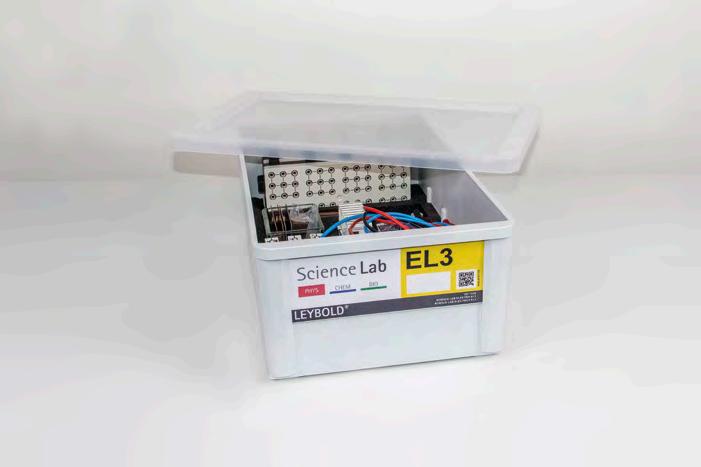
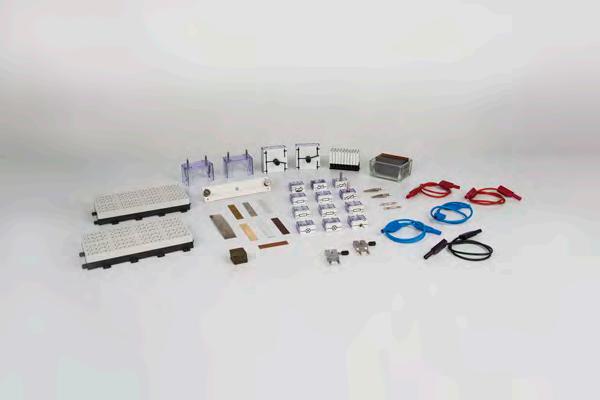
Student experiment set of the student experiment system Science Lab in the field of physics. Set-up material for one working group in pre-formed tray. With the equipment set EL3, 40 experiments at school, college and university level for worldwide curriculums can be performed. The students deal with the topics electrical basic circuits and electrochemistry. While working out the curriculum required topics, they are also trained in communication and assessment skills. In combination with the Mobile-CASSY 2 WiFi (524 005W2), there are additional evaluation options which enable the students digital learning.
Scope of delivery:
Count Name
2 Coupling plug 4 mm
1 Bimetallic strip
2 Safety connecting lead 50 cm, red
2 Safety connecting lead 50 cm, blue
1 Safety connecting lead 50 cm, black
1 Bridging plugs STE 2/19, set of 10
1 Adapter 4-mm plug/4-mm socket
2 Crocodile clip, polished
1 Conductors/insulators, set of 6
1 Wrapping plate for wires
2 Plug-in board safety socket, 20/10
2 Monocell holder STE 2/50
1 Resistor 47 Ohm, STE 2/19
2 Resistor 100 Ohm, STE 2/19
1 Resistor 1 kOhm, STE 2/19
1 Resistor 10 kOhm, STE 2/19
Count Name
Variable resistor 47 kOhm, STE 2/19
Photoresistor LDR 05, STE 2/19
NTC resistor 2.2 kOhm, STE 2/19
PTC resistor 100 Ohm, STE 2/19
Lamp holder E10, lateral, STE 2/19
Toggle switch STE 2/19
Plug-in holder STE
Contact strip
Change-over switch STE 4/50
Flat trough/electrolysis cell
Plate electrode copper 76 x 40 mm
Plate electrode zinc 76 x 40 mm
Plate electrode iron 76 x 40 mm
Tray, high
Grindstone


n The plug-in system enables even larger circuits to be mounted on the plug-in boards
n Variable plug-in board with safety sockets for 4 mm plugs
n Set up experiments in L- or T-shape with the plug-in board
n Easily expandable for more complex circuits by plugging several boards together
n Wrapping plate for wires allows easy experimentation on the resistance of wires while using less resources

DIGITAL CLASS / EDUCATION
The universal student measuring device with WiFi for all measuring tasks in physics, chemistry and biology. 524 005W2 Mobile-CASSY 2 WiFi
Detailed information on the Mobile-CASSY 2 WiFi can be found on the Internet at www.leybold-shop.com/524005W2
Additionally required per student
Count Cat.-No. Name Description
1 610 010 Laboratory safety goggles, Focomax
Additionally required per working group
Count Cat.-No. Name
1 505 07 Bulbs, 4 V/0,16 W, E10, Set of 10
1 505 08 Bulbs, 12 V/3 W, E10, Set of 10
2 505 11 Bulbs, 2.5 V/0,25 W, E10, Set of 10
1 521 487 AC/DC Power supply PRO 0...12 V/3 A
1 524 005W2 Mobile-CASSY 2 WiFi for digital experiments
2 531 120 Multimeter LDanalog 20 alternative for analog measurements
2 685 48 Mono cell 1.5 V (IEC R20) Voltage sources experiments (LP3.3.5)
Additionally required per class
Count Cat.-No. Name Description
1 520 713 LIT-digital: LP3 Science Lab Electrics
1 550 42 Constantan resistance wire, 0.35 mm diameter, 100 m
1 550 46 Chrome-nickel resistance wire, 0.25 mm diameter, 100 m
1 550 47 Chrome-nickel resistance wire, 0.35 mm diameter, 100 m
1 550 51 Iron resistance wire, 0.2 mm diameter, 100 m
1 672 9650 Copper (II) sulfate solution 1%, 50 ml
1 673 5700 Sodium chloride 250 g
1 674 7960 Sulfuric acid, diluted, 0.05 mol/l, 2 l
1 675 3400 Water, pure, 1 l
Ohmic resistance experiments (LP3.3.3)
Wire’s resistance experiments (LP3.3.3)
Wire’s resistance experiments (LP3.3.3)
Wire’s resistance experiments (LP3.3.3)
Electrochemistry experiments (LP3.3.7)
Electrochemistry experiments (LP3.3.7)
Electrochemistry experiments (LP3.3.7)
Electrochemistry experiments (LP3.3.7)
Detailed information on Mobile-CASSY 2 WiFi, sensors, literature packages and chemical sets are available on the following pages.

With the Mobile-CASSY 2 WiFi, voltage (U), current (I), power (P) and energy (E) can be measured via 4 mm safety sockets.
Here you will find an overview of our literature packages. You can find detailed information on our literature on the internet at www.leybold-shop.com.



LIT-print: LP3.3 Electrical basic circuits and electrochemistry
Detailed experiment instructions relating to Science Lab Set EL3 (207 133S). Describes 40 experiments from the field of basic electrical circuits and electrochemistry. Topics: Electrical circuits and switches; Electrical measurement methods; Ohmic resistance; Special resistors; Voltage sources; Electrical application circuits; Electrochemistry
520 7133EN LIT-print: LP3.3 Electrical basic circuits and electrochemistry
Comprehensive physics experiment instructions in the field of electricity for the Science Lab. Contains 154 experiments on electrostatics, magnetism, basic electrical circuits and electrochemistry, electromagnetism and induction, motors and generators and electronics. Includes all interactive experiment instructions (Lab Docs) as html file.
520 713 LIT-digital: LP3 Science Lab Electricity
Comprehensive physics experiment instructions for the Science Lab. Contains more than 460 experiments in the fields of mechanics, energy, electricity and electronics, optics, atomic and nuclear physics as well as informatics and technology. Includes all interactive experiment instructions (Lab Docs) as html file.
520 71 LIT-digital: LP Science Lab Physics
Technical data of the digital version:
• Product key for literature (activation & selection of one literature language in LeyLab)
• Can then be used in LeyLab and Document Center (school/institute licence)
• System requirements:
Document Center:
- PC with Windows 7 or higher; internet access during installation; local network for distribution to students LeyLab:
- PC, tablet or smartphone with a current browser; internet access





The possibilities of the plug-in boardchangeable and adaptable


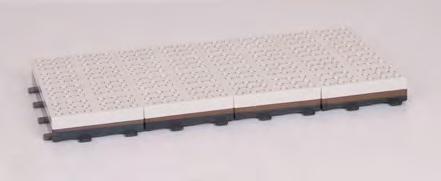
FOR SIMPLE ELECTRICAL EXPERIMENTS TO COMPLEX ELECTRONICS CIRCUITS
TO SET UP AND DISASSEMBLE
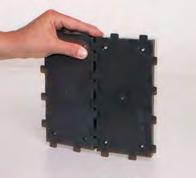

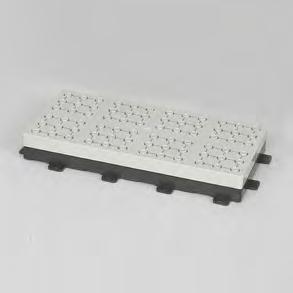
FLEXIBLE AND MODULAR
n Facilitates the use of safety wires in experiments
n Experiment set-up in T and L shapes
n Sturdy
n Minimal space required
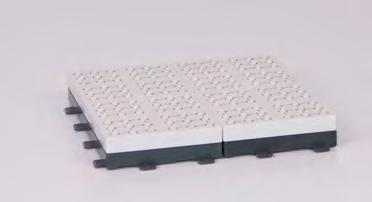


Sensors
LP3.4.1 Electromagnetism
LP3.4.1.1
LP3.4.1.2
LP3.4.1.3
LP3.4.1.3C
Magnetic effect of electric current
Current-carrying conductor in a magnetic field
Magnetic field of a coil
Magnetic field of a coil (with Mobile-CASSY 2 WiFi)
LP3.4.2 Electromagnetic applications
LP3.4.2.1
LP3.4.2.2
LP3.4.2.3
Electromagnet
Electromagnetic relays
The electric bell
LP3.4.3 Induction
LP3.4.3.1
LP3.4.3.1C
LP3.4.3.2
LP3.4.3.2C
Electromagnetic induction with bar magnet and a coil
Electromagnetic induction with bar magnet and a coil (with Mobile-CASSY 2 WiFi)
Electromagnetic induction with two coils
Electromagnetic induction with two coils (with Mobile-CASSY 2 WiFi)
LP3.4.4 Transformers
LP3.4.4.1
LP3.4.4.1C
LP3.4.4.2
LP3.4.4.2C
Voltage transformation
Voltage transformation (with Mobile-CASSY 2 WiFi)
Current transformation
Current transformation (with Mobile-CASSY 2 WiFi)
LP3.4.5 Applications of induction
LP3.4.5.1
LP3.4.5.2
LP3.4.5.2C
Self-induction of a coil (model of an induction coil)
Model of an alternating current generator
Model of an alternating current generator (with Mobile-CASSY 2 WiFi)
LP3.4.6 Coils in direct and alternating current circuits
LP3.4.6.1
LP3.4.6.2
LP3.4.6.2C
DC and AC resistance of a coil I (observation experiment)
DC and AC resistance of a coil II (measuring experiment)
DC and AC resistance of a coil II (measuring experiment) (with Mobile-CASSY 2 WiFi)
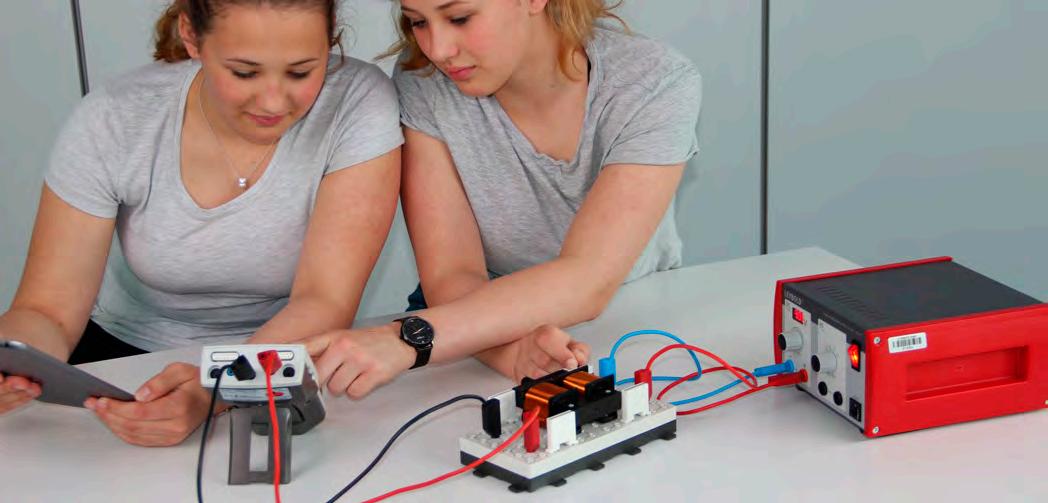

Electromagnetic induction with bar magnet and a coil
LP3.4 ELECTROMAGNETISM AND INDUCTION
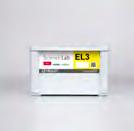





Student experiment set of the student experiment system Science Lab in the field of physics. Set-up material for one working group in pre-formed tray With the equipment set EL4, together with the Science Lab Electrics EL3 (207 133S), 21 experiments at school, college and university level for worldwide curriculums can be performed.
The students deal with the topic electromagnetism. While working out the curriculum required topics, they are also trained in communication and assessment skills. In combination with the Mobile-CASSY 2 WiFi (524 005W2), there are additional evaluation options which enable the students digital learning. Scope
1
1
1
1


n With EL 4, students understand the link between electricity and magnetismfor example through induction experiments
n The demountable transformer core is easy to use so the transformation of voltages can be worked on quickly and comprehensibly
n Acquired skills: Understanding the connections between magnetic and electrical phenomena

The universal student measuring device with WiFi for all measuring tasks in physics, chemistry and biology.
Detailed information on the Mobile-CASSY 2 WiFi can be found on the Internet at www.leybold-shop.com/524005W2


Magnetic field sensor M, ±100 mT
For measuring the tangential or axial magnetic flux density up to ±100 mT with Mobile-CASSY 2 WiFi (524 005W2).
Voltage sensor M, ±30 V
For measuring the electrical voltage up to ±30 V with Mobile-CASSY 2 (524 005W2). In connection with the integrated voltage input, Mobile-CASSY 2 WiFi (524 005W2) can become a two channel storage oscilloscope. 524 438
You can find detailed information on these and other sensors on the internet at www.leybold-shop.com.
Here you will find an overview of our literature packages. You can find detailed information on our literature on the internet at www.leybold-shop.com.



LIT-print: LP3.4 Electromagnetism and Induction
Detailed experiment instructions relating to Science Lab Set EL4 (207 134S) in conjunction with Science Lab Set EL3 (207 133S). Describes 21 experiments from the fields of electromagnetism and induction.
Topics:
Electromagnetism; Electromagnetic applications; Induction; Transformers; Applications of induction; Coils in direct and alternating current circuits
520 7134EN LIT-print: LP3.4 Electromagnetism and Induction
Comprehensive physics experiment instructions in the field of electricity for the Science Lab. Contains more than 154 experiments on electrostatics, magnetism, basic electrical circuits and electrochemistry, electromagnetism and induction, motors and generators and electronics. Includes all interactive experiment instructions (Lab Docs) as html file.
Comprehensive physics experiment instructions for the Science Lab. Contains about more than 460 experiments in the fields of mechanics, energy, electricity and electronics, optics, atomic and nuclear physics as well as informatics and technology. Includes all interactive experiment instructions (Lab Docs) as html file.
520 71 LIT-digital: LP Science Lab Physics
Technical data of the digital version:
• Product key for literature (activation & selection of one literature language in LeyLab)
• Can then be used in LeyLab and Document Center (school/institute licence)
• System requirements:
Document Center:
- PC with Windows 7 or higher; internet access during installation; local network for distribution to students LeyLab:
- PC, tablet or smartphone with a current browser; internet access






n Investigating the function of an electric bell
n The materials can be used to set up a bell that is operated with AC voltage
EVERYDAY EXPERIENCE - What happens if I press a bell button? + GAIN KNOWLEDGE ABOUT MAGNETISM + UNDERSTAND ELECTRICAL PHENOMENA
INTERESTING AND EASY-TO-UNDERSTAND EXPERIMENT INSTRUCTIONS
DIGITAL OR IN HARD COPY



Lab Docs are responsive. They adapt the layout to the screen size.
From the smallest smartphone, tablet or laptop to a projector.
LP3.5 MOTORS AND GENERATORS
LP3.5.1 Generators
LP3.5.1.1
LP3.5.1.1C
LP3.5.1.2
LP3.5.1.2C
LP3.5.1.3
LP3.5.1.3C
LP3.5.1.4
LP3.5.1.4C Dynamo
Dynamo (with Mobile-CASSY 2 WiFi)
Universal generator - functional principle
Universal generator - functional principle (with Mobile-CASSY 2 WiFi)
Power plant generator
Power plant generator (with Mobile-CASSY 2 WiFi)
AC/DC generator with electromagnetic stator
AC/DC generator with electromagnetic stator (with Mobile-CASSY 2 WiFi)
LP3.5.2 Electric motors
LP3.5.2.1
LP3.5.2.1C
LP3.5.2.2
LP3.5.2.2C
LP3.5.2.3
LP3.5.2.3C
DC motor - functional principle
DC motor - functional principle (with Mobile-CASSY 2 WiFi)
Universal shunt-wound motor
Universal shunt-wound motor (with Mobile-CASSY 2 WiFi)
Universal series-wound motor - functional principle
Universal series-wound motor - functional principle (with Mobile-CASSY 2 WiFi)
For experiments marked with „C“, the measurements are carried out digitally with the Mobile-CASSY 2 WiFi.

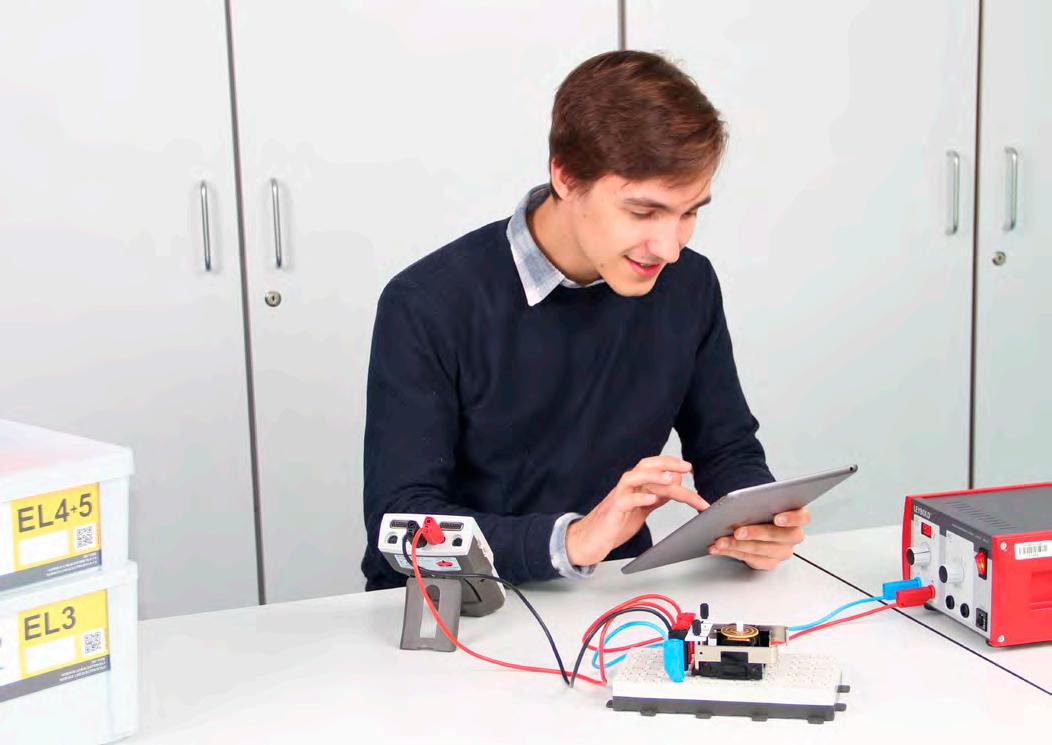
LP3.5.2.1C DC motor - functional principle
LP3.5 MOTORS AND GENERATORS
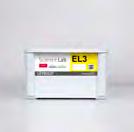






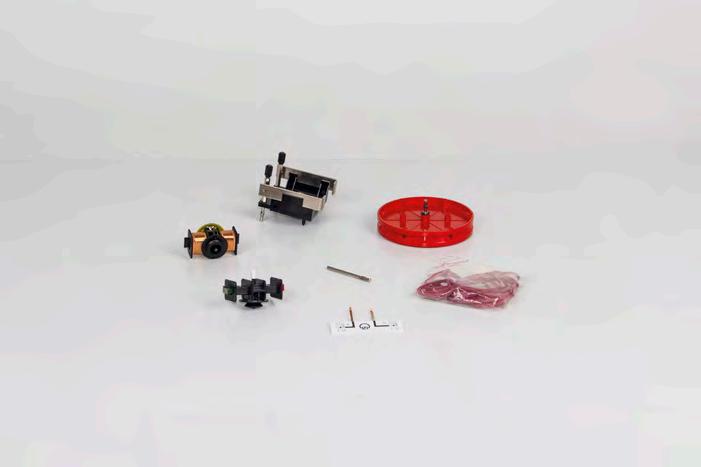
Student experiment set of the student experiment system Science Lab in the field of physics. Set-up material for one working group. The equipment is stored in Science Lab Electrics EL4 (207 134S). With the supplementary equipment set EL5, together with the Science Lab Electrics EL3 (207 133S) and EL4 (207 134S), 14 experiments at school, college and university level for worldwide curriculums can be performed. The students deal with the topics motors and generators. While working out the curriculum required topics, they are also trained in communication and assessment skills. In combination with the Mobile-CASSY 2 WiFi (524 005W2), there are additional evaluation options which enable the students digital learning.


n Everyday relevance: Further insights into electromagnetism through experiments with simple motors and generators
n Engine and generator models are quickly assembled and functionally reliable
n Acquired skills: understanding different drive technologies (relevant for the debate on electromobility)

The universal student measuring device with WiFi for all measuring tasks in physics, chemistry and biology.
Detailed information on the Mobile-CASSY 2 WiFi can be found on the Internet at www.leybold-shop.com/524005W2 MOBILE-CASSY 2 WIFI

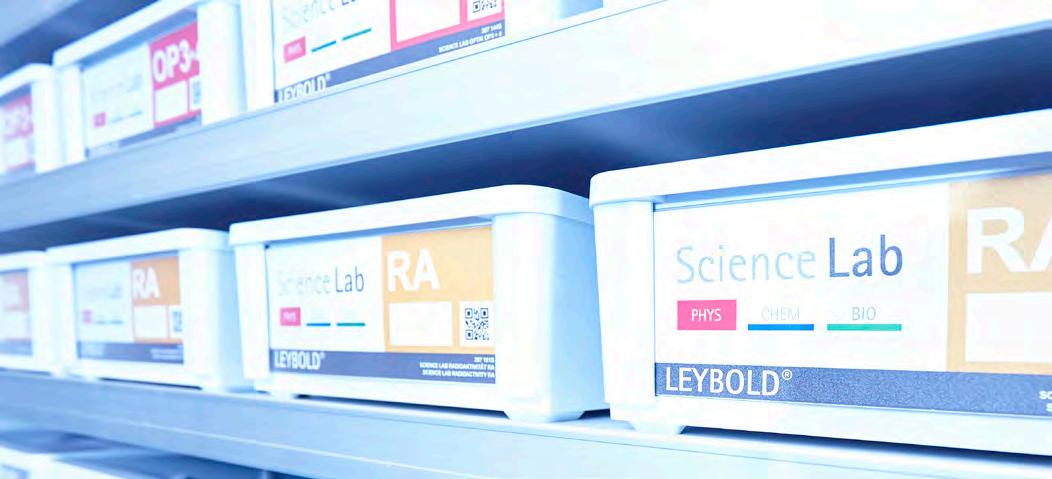
Here you will find an overview of our literature packages. You can find detailed information on our literature on the internet at www.leybold-shop.com.



Detailed experiment instructions relating to Science Lab Set EL5 (207 135S) in conjunction with Science Lab Set EL3 (207 133S) and EL4 (207 134S). Describes 14 experiments from the field of motors and generators.
Topics: Generators; Electric motors
520 7135EN LIT-print: LP3.5 Motors and Generators
Comprehensive physics experiment instructions in the field of electricity for the Science Lab. Contains 154 experiments on electrostatics, magnetism, basic electrical circuits and electrochemistry, electromagnetism and induction, motors and generators and electronics. Includes all interactive experiment instructions (Lab Docs) as html file.
520 713 LIT-digital: LP3 Science Lab Electricity
Comprehensive physics experiment instructions for the Science Lab. Contains more than 460 experiments in the fields of mechanics, energy, electricity and electronics, optics, atomic and nuclear physics as well as informatics and technology. Includes all interactive experiment instructions (Lab Docs) as html file.
520 71 LIT-digital: LP Science Lab Physics
Technical data of the digital version:
• Product key for literature (activation & selection of one literature language in LeyLab)
• Can then be used in LeyLab and Document Center (school/institute licence)
• System requirements: Document Center:
- PC with Windows 7 or higher; internet access during installation; local network for distribution to students LeyLab:
- PC, tablet or smartphone with a current browser; internet access






n As with every trend, it’s all about gaining basic knowledge
n By spinning the drive roller, the voltage can be measured or visualised using a light bulb
n General understanding of generators
n Transferable to wind energy
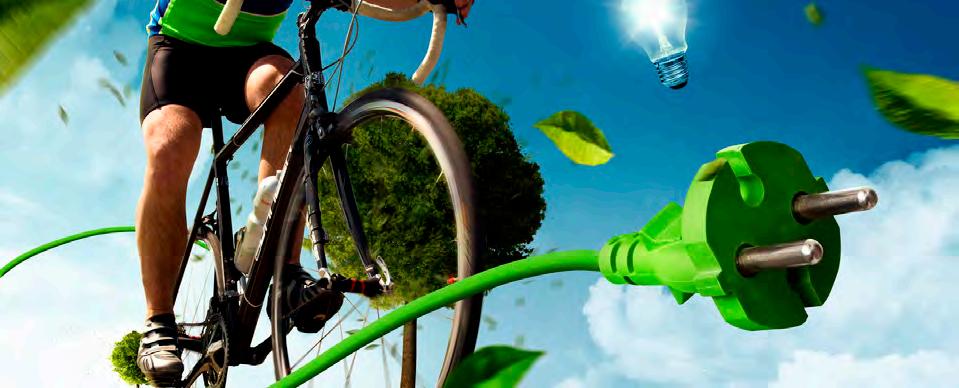
n The DC motor is comparable with an e-bike motor
n By assembling and operating different motors, the students gain knowledge of the respective functions
n Through this investigation and further experiments with electric motors, students get their first insight into the topic of electromobility

LP4.1.1 Capacitors
LP4.1.1.1
LP4.1.1.1C
LP4.1.1.2
LP4.1.1.2C
Capacitors in a DC circuit
Capacitors in a DC circuit (with Mobile-CASSY 2 WiFi)
Capacitors in an AC circuit
Capacitors in an AC circuit (with Mobile-CASSY 2 WiFi)
LP4.1.2 Relay circuits
LP4.1.2.1
LP4.1.2.1C Light-controlled relays
Light-controlled relays (with Mobile-CASSY 2 WiFi)
LP4.1.3 Diodes
LP4.1.3.1
LP4.1.3.1C
LP4.1.3.2
LP4.1.3.2C
LP4.1.3.3
LP4.1.3.3C
LP4.1.3.4
LP4.1.3.4C
LP4.1.3.5
LP4.1.3.5C
LP4.1.3.6
LP4.1.3.6C
LP4.1.3.7
LP4.1.3.7C
Characteristic curve of a diode
Characteristic curve of a diode (with Mobile-CASSY 2 WiFi)
Half-wave rectification
Half-wave rectification (with Mobile-CASSY 2 WiFi)
Full-wave rectification
Full-wave rectification (with Mobile-CASSY 2 WiFi)
Light-emitting diodes
Light-emitting diodes (with Mobile-CASSY 2 WiFi)
Polarity tester with diodes
Polarity tester with diodes (with Mobile-CASSY 2 WiFi)
Characteristic curve of a Z diode
Characteristic curve of a Z diode (with Mobile-CASSY 2 WiFi)
Overvoltage protection using a Z diode
Overvoltage protection using a Z diode (with Mobile-CASSY 2 WiFi)
LP4.1.4 Transistors
LP4.1.4.1
LP4.1.4.2
LP4.1.4.2C
LP4.1.4.3
LP4.1.4.3C
LP4.1.4.4
LP4.1.4.5
LP4.1.4.5C
Diode junctions on transistors, test circuit with light-emitting diodes
Transfer characteristic of a transistor
Transfer characteristic of a transistor (with Mobile-CASSY 2 WiFi)
Transistor circuit I, voltage control
Transistor circuit I, voltage control (with Mobile-CASSY 2 WiFi)
Light-controlled transistor I, light barrier
Delay switch
Delay switch (with Mobile-CASSY 2 WiFi)
LP4.1.5 Diode circuits
LP4.1.5.1
LP4.1.5.1C
LP4.1.5.2
LP4.1.5.2C
Overvoltage and reverse polarity protection using diodes
Overvoltage and reverse polarity protection using diodes (with Mobile-CASSY 2 WiFi)
Smoothing pulsating DC voltages with capacitors
Smoothing pulsating DC voltages with capacitors (with Mobile-CASSY 2 WiFi)
LP4.1.6 Flip-flops
LP4.1.6.1
LP4.1.6.1C Basic experiments with flip-flops
Basic experiments with flip-flops (with Mobile-CASSY 2 WiFi)
LP4.1.7 Amplifier circuits
LP4.1.7.2
LP4.1.7.2C Touch-sensitive switches, humidity and fill level indicators
Touch-sensitive switches, humidity and fill level indicators (with Mobile-CASSY 2 WiFi)
LP4.1.8 Solar cells
LP4.1.8.1
LP4.1.8.1C
LP4.1.8.2
LP4.1.8.2C
LP4.1.8.3
LP4.1.8.3C
Forward and reverse direction of a solar cell
Forward and reverse direction of a solar cell (with Mobile-CASSY 2 WiFi)
Output and power characteristics of a solar cell
Output and power characteristics of a solar cell (with Mobile-CASSY 2 WiFi) No-load
of a solar cell No-load voltage of a solar cell (with Mobile-CASSY 2 WiFi)

LP4.1.3.3C Full-wave rectification
LP4.1 BASIC ELECTRONIC CIRCUITS




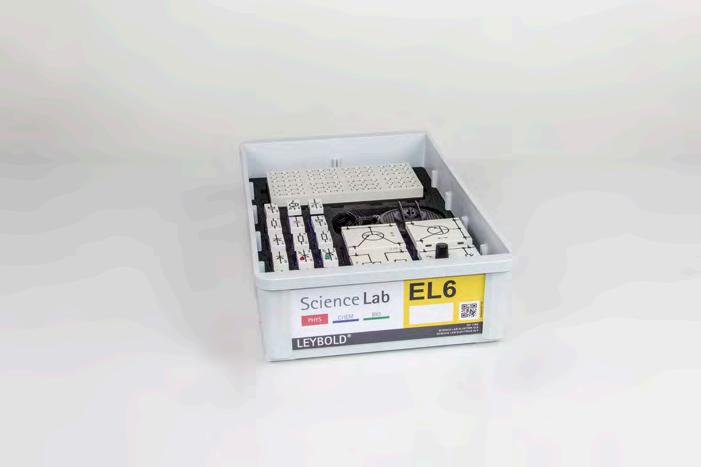

Student experiment set of the student experiment system Science Lab in the field of physics. Set-up material for one working group in pre-formed tray With the equipment set EL6, together with the Science Lab Electrics EL3 (207 133S), 42 experiments at school, college and university level for worldwide curriculums can be performed.
The students deal with the topics basic electronic circuits and transistor electronics. While working out the curriculum required topics, they are also trained in communication and assessment skills. In combination with the Mobile-CASSY 2 WiFi (524 005W2), there are additional evaluation options which enable the students digital learning.
Scope of delivery:
Count Name
1 Plug-in board safety socket, 20/10
1 Resistor 470 Ohm, STE 2/19
1 Resistor 4.7 kOhm, STE 2/19
1 Potentiometer 220 Ohm, STE 4/50
1 Capacitor, 1 µF, STE 2/19
1 Capacitor (electrolytic) 100 µF, STE 2/19
1 Capacitor (electrolytic) 470 µF, STE 2/19
1 Light emitting diode red, STE 2/19
4 Diode 1N 4007, STE 2/19
1 Zener diode 6.2, STE 2/19
Name 1 Light emitting diode green, STE 2/19 1 Photodiode, lateral 1 Solar cell, STE 2/19
1 Transistor BD 137, NPN, e.b., STE 4/50
1 Transistor BD 138, PNP, e.b., STE 4/50 1 Relay with change-over switch STE 4/50
Earphone 1 Tray, low


n Students learn to understand more complex structures, such as diode and transistor circuits, through the structured experiment instructions
n Similarities to the use of printed circuit boards in electronic components become visible
n Acquired skills: understanding the functions of electronic components in modern technical devices
524 005W2 Mobile-CASSY 2 WiFi STUDENT MEASURING DEVICE


The universal student measuring device with WiFi for all measuring tasks in physics, chemistry and biology.
Detailed information on the Mobile-CASSY 2 WiFi can be found on the Internet at www.leybold-shop.com/524005W2
Voltage sensor M, ±30 V
For measuring the electrical voltage up to ±30 V with Mobile-CASSY 2 WiFi (524 005W2). In connection with the integrated voltage input, Mobile-CASSY 2 WiFi (524 005W2) can become a 2 channel storage oscilloscope.
524 438 Voltage sensor M, ±30 V
You can find detailed information on this and other sensors on the internet at www.leybold-shop.com.
Here you will find an overview of our literature packages. You can find detailed information on our literature on the internet at www.leybold-shop.com.



Detailed experiment instructions relating to Science Lab Set EL6 (207 136S) in conjunction with Science Lab Set EL3 (207 133S). Describes 42 experiments from the field of electronics.
Topics: Capacitors; Relay circuits; Diodes; Transistors; Diode circuits; Flip-flops; Amplifier circuits; Solar cells
520 7136EN LIT-print: LP4.1 Electronics
Comprehensive physics experiment instructions in the field of electricity for the Science Lab. Contains 154 experiments on electrostatics, magnetism, basic electrical circuits and electrochemistry, electromagnetism and induction, motors and generators and electronics.
Includes all interactive experiment instructions (Lab Docs) as html file.
520 713 LIT-digital: LP3 Science Lab Electricity
Comprehensive physics experiment instructions for the Science Lab. Contains more than 460 experiments in the fields of mechanics, energy, electricity and electronics, optics, atomic and nuclear physics as well as informatics and technology. Includes all interactive experiment instructions (Lab Docs) as html file.
520 71 LIT-digital: LP Science Lab Physics
Technical data of the digital version:
• Product key for literature (activation & selection of one literature language in LeyLab)
• Can then be used in LeyLab and Document Center (school/institute licence)
• System requirements:
Document Center:
- PC with Windows 7 or higher; internet access during installation; local network for distribution to students LeyLab:
- PC, tablet or smartphone with a current browser; internet access





Name: Date:
Observation
n With the Mobile-CASSY 2 WiFi, two or more measuring quantities can be measured against each other and simultaneously recorded, such as:
n Current and voltage
n Temperature and voltage
n Dependencies between measuring quantities can be illustrated exceptionally well in diagrams
n This allows students to gain a deeper understanding of the basic principles of electronics
n Simple measuring of characteristic curves is only possible with digital measuring technology
Current and voltage measurement on a resistor

Disassembly Dismount
With interactivity between the Mobile-CASSY 2 WiFi and Lab Docs, the measured values are transferred in real time and the characteristic curves are displayed directly in the diagrams.

The Lab Doc with the recorded characteristic curve can also be saved as a digital protocol and then shared with the teacher.
With the Lab Docs Editor, the diagrams (among other features) can be adjusted.

Optics can be useful to introduce students to the methodology of investigating phenomena at a very early stage with simple experiments. Due to the flexible use of the LED lamp, light beams can be observed and described using various objects in simple experiment set-ups on the table. Additionally, more complex content, such as interference and diffraction phenomena, can be compiled in a comprehensible framework in advanced classes/lectures.
Two Optics Sets provide four topic areas with more than 70 experiments. Measured values can either be recorded in the classic way or, in some experiments, with the help of the Mobile-CASSY 2 WiFi and the lux sensor M.

LP5.3.2.2 Complementary crossed gratings (Babinet's principle)
Students will learn that complementary screens produce the same diffraction images. In comparison with the gap and web experiment, the crossed gratings represent a much more complex structure. For this experiment you will need the sets Science Lab Optics OP1 (207 141S) and Science Lab Optics OP3 (207 143S)
EXPERIMENT TOPICS
LP5.1 RAY OPTICS AND GEOMETRICAL OPTICS
LP5.1.1 PROPAGATION OF LIGHT AND SHADOW FORMATION
LP5.1.2 LIGHT AND SHADOW IN NATURE
LP5.1.3 REFLECTION IN MIRRORS
LP5.1.4 LIGHT REFRACTION
LP5.1.5 DISPERSING LIGHT AND RECOMBINATION OF THE SPECTRUM
LP5.1.6 LENSES AND LENS ABERRATIONS
LP5.1.7 OPTICAL INSTRUMENTS FOR ANGULAR MAGNIFICATION
LP5.1.8 OPTICAL INSTRUMENTS AND THE EYE
LP5.2 CHROMATICS
LP5.2.1 EXAMINATION OF THE LIGHT PATHS THROUGH A PRISM
LP5.2.2 SPECTRAL COLOURS
LP5.2.3 COLOUR MIXING





LP5.3 WAVE OPTICS
LP5.3.1 DIFFRACTION ON DIFFRACTION OBJECTS
LP5.3.2 DIFFRACTION ON COMPLEMENTARY APERTURES
LP5.3.3 TWO-BEAM INTERFERENCE


LP5.4 POLARISATION
LP5.4.1 POLARISATION FILTERS
LP5.4.2 PHOTOELASTIC DOUBLE REFRACTION
LP5.4.3 POLARISATION DUE TO REFLECTION AND DIFFRACTION
LP5.4.4 POLARISATION DUE TO SCATTERING
LP5.4.5 OPTICAL ACTIVITY




Further information about our curriculum-compliant topics and student experiments as well as the
can be found on the following pages.
LP5.1.1
LP5.1.1.1
LP5.1.1.2
LP5.1.1.3
LP5.1.1.4
LP5.1.1.4C
Propagation of light and shadow formation
Propagation of light
Can light pass through all matter?
Shadows
Illuminance
Illuminance (with Mobile-CASSY 2 WiFi)
LP5.1.2 Light and shadow in nature
LP5.1.2.1
LP5.1.2.2
LP5.1.2.3
LP5.1.2.4
Day and night
The seasons The phases of the moon Lunar and solar eclipses
LP5.1.3 Reflection in mirrors
LP5.1.3.1
LP5.1.3.2
LP5.1.3.3
LP5.1.3.4
LP5.1.3.5
LP5.1.3.6
LP5.1.3.7
Reflection in a plane mirror
Mirror image in a plane mirror
Optical paths in a concave mirror
Focal length of the convex mirror
Focal length of the concave mirror
Images in a concave mirror
Images in a convex mirror
LP5.1.4 Light refraction
LP5.1.4.1
LP5.1.4.2
LP5.1.4.3
LP5.1.4.4
LP5.1.4.5
Light refraction on a semicircular body
Refraction on a plane-parallel plate
Total internal reflection
Retroreflector prisms and dove prisms
Refraction in various media on a semicircular trough and semicircular body
LP5.1.5 Dispersing light and recombination of the spectrum
LP5.1.5.1
LP5.1.5.2
Dispersion of white light with a prism
Recombination of the spectrum
LP5.1.6 Lenses and lens aberrations
LP5.1.6.1
LP5.1.6.2
LP5.1.6.3
LP5.1.6.4
LP5.1.6.5
LP5.1.6.6
LP5.1.6.7
LP5.1.6.8
LP5.1.6.9
LP5.1.6.10
LP5.1.6.11
Optical path of a plano-convex lens
Optical path of a bi-convex lens
Images of convex lenses
Spherical aberration of lenses
Focal length determination of a convex lens via autocollimation
Optical path of a plano-concave lens
Optical path of a bi-concave lens
The image formula
Pincushion and barrel distortion
Optical path of lens combinations
Optical path of a lens system
LP5.1.7 Optical instruments for angular magnification
LP5.1.7.1
LP5.1.7.2
LP5.1.7.3
LP5.1.7.4
LP5.1.7.5
LP5.1.7.6
Magnification with a magnifying glass
The microscope
Changing the magnification of a microscope
Telescope models
Magnification in a Galilean telescope
Magnification in a Keplerian telescope
LP5.1.8 Optical instruments and the eye
LP5.1.8.1
LP5.1.8.2
LP5.1.8.3
LP5.1.8.4
LP5.1.8.5
LP5.1.8.6
The camera
Depth of field of a camera
The slide projector
The human eye
Refractive errors and vision correction
Optical illusions

In this experiment, students will discover that the illuminance E of a "point source" decreases with 1/r² and thus is subject to the law of distance. For this experiment you will need the set Science Lab Optics OP1 (207 141S)





Student experiment set of the student experiment system Science Lab in the field of physics. Set-up material for one working group in pre-formed tray With the equipment set OP1, 46 experiments at school, college and university level for worldwide curriculums can be performed. The students deal with the topics ray path optics and geometrical optics. While working out the curriculum required topics, they are also trained in communication and assessment skills. In combination with the Mobile-CASSY 2 WiFi (524 005W2), there are additional evaluation options which enable the students digital learning. Scope of delivery:
Count Name
1 Tape measure 2 m / 1 mm
1 Rubber rings, set of 8
1 Light box housing, LED
1 LED lamp
1 Plug-in power supply USB 5 V DC (A socket)
1 Cable USB (USB Type A - Mini-USB)
1 Translucent screen on rod
1 Plate holder on rod
1 Diaphragm and slide holder on rod
1 Plane mirror 7.5 cm x 5 cm
1 Earth-moon model on rod
1 Combined mirror model
1 Trapezoidal body 60/45 x 30 mm
1 Semicircular body r = 30 mm
1 Right-angled prism h = 30 mm
1 Plano-convex lens
mirror on rod
Precision metal rail, 50 cm
Clamp rider
Set of 2 slit diaphragms
Set of 4 different diaphragms
Set of 4 aperture diaphragms
Objects for investigating images, pair
Transparencies, optical illusions, set of 6

n Includes basic optical devices and all other devices for ray optics and geometrical optics
n The LED lamp can be used both for experiments on the work bench (light box) and on the precision metal rail
n Easy-to-use 50 cm precision metal rail, e.g. for mounting a telescope or as an optical bench (can also be used in mechanics)
n Digital measurement of light intensity with the Mobile-CASSY 2 WiFi and the lux sensor M
n LED lamp can be connected to Mobile-CASSY 2 WiFi or power bank – no power supply needed



The universal student measuring device with WiFi for all measuring tasks in physics, chemistry and biology.
Detailed information on the Mobile-CASSY 2 WiFi can be found on the Internet at www.leybold-shop.com/524005W2
Lux sensor M
For measuring the illuminance of visible light with Mobile-CASSY 2 WiFi (524 005W2). The lux sensor has a flat design so that it can, for example, be inserted directly into the holder for diaphragms and slides (459 33). With the lux sensor, measurements can be performed along and orthogonal to the optical axis. A printed millimetre scale is used to position the sensor on the optical axis and also enables the recording of intensity distributions of different diffraction objects (e.g. 469 731) without additional equipment.
524 444 Lux sensor M
You can find detailed information on this and other sensors on the internet at www.leybold-shop.com.
USB power bank 2200 mAh
Power bank with 2200 mAh suitable for LED lamp (459 094), triple LED lamp (459 098) and laser class 1, red (459 097). The 5V DC USB plug-in power supply unit (459 095) can be used to charge the power bank.
You can find detailed information on the USB power bank on the internet at www.leybold-shop.com.
Here you will find an overview of our literature packages. You can find detailed information on our literature on the internet at www.leybold-shop.com.
TOPIC

LIT-print: LP5.1 Ray optics and geometrical optics
Detailed experiment instructions relating to Science Lab Set OP1 (207 141S). Describes 46 experiments from the fields of ray path optics and geometrical optics. Topics:
Propagation of light and shadow formation; Light and shadow in nature; Reflection in mirrors; Light refraction; Dispersing light and recombination of the spectrum; Lenses and lens aberrations; Optical instruments for angular magnification; Optical instruments and the eye
520 7141EN LIT-print: LP5.1 Ray optics and geometrical optics
SUBJECT AREA

SUBJECT

LIT-digital: LP5 Science Lab Optics
Comprehensive physics experiment instructions in the field of optics for the Science Lab. Contains 72 experiments on ray optics and geometrical optics, chromatics, wave optics and polarisation.
Includes all interactive experiment instructions (Lab Docs) as html file.
520 714 LIT-digital: LP5 Science Lab Optics
LIT-digital: LP Science Lab Physics
Comprehensive physics experiment instructions for the Science Lab. Contains more than 460 experiments in the fields of mechanics, energy, electricity and electronics, optics, atomic and nuclear physics as well as informatics and technology.
Includes all interactive experiment instructions (Lab Docs) as html file.
520 71 LIT-digital: LP Science Lab Physics
Technical data of the digital version:
• Product key for literature (activation & selection of one literature language in LeyLab)
• Can then be used in LeyLab and Document Center (school/institute licence)
• System requirements: Document Center:
- PC with Windows 7 or higher; internet access during installation; local network for distribution to students LeyLab:
- PC, tablet or smartphone with a current browser; internet access





Just one light source! For experiments with the light box on the table and on the precision metal rail

FOR EXPERIMENTS IN RAY OPTICS WITH THE LIGHT BOX ON THE TABLE LED lamp FOR EXPERIMENTS IN GEOMETRICAL OPTICS ON THE PRECISION METAL RAIL


n Our LED lamp is classified according to DIN EN 62471 in risk group 1
n No risk of danger to students’ eyes when performing the experiments
n Minimal heat generated compared to halogen lamps
n Sturdy housing and easy operation

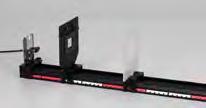
Lab Doc for the experiment of the illuminance

LP5.2.1
LP5.2.1.1
Examination of the light paths through a prism
LP5.2.1.2 Light paths through a prism Deflections in a prism
LP5.2.2 Spectral colours
LP5.2.2.1
LP5.2.2.2
LP5.2.2.3
LP5.2.2.4
Dispersion of white light Colour defects in illustrations
Examination of spectral colours Spectra of different slits
LP5.2.3 Colour mixing
LP5.2.3.1
LP5.2.3.2
LP5.2.3.3
LP5.2.3.4
LP5.2.3.5
Recombination of the spectrum
Light and body colours
Additive mixing of two light colours
Additive mixing of three light colours
Subtractive mixing

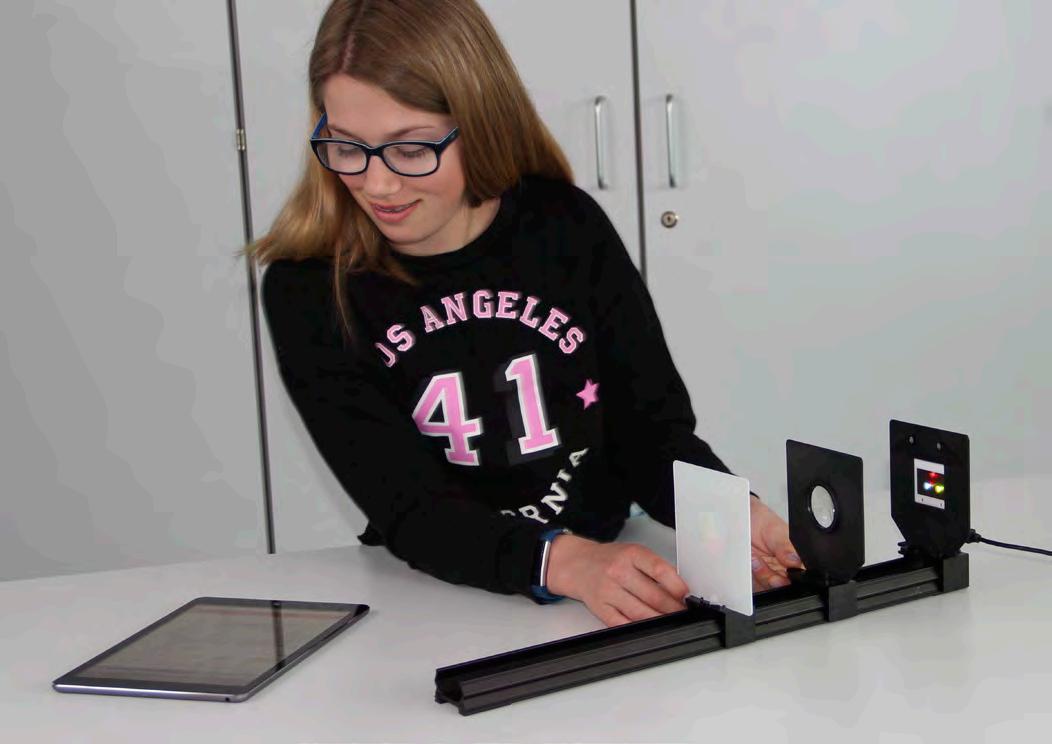
OVERVIEW OF EQUIPMENT REQUIRED FOR PERFORMING EXPERIMENTS
LP5.2 CHROMATICS






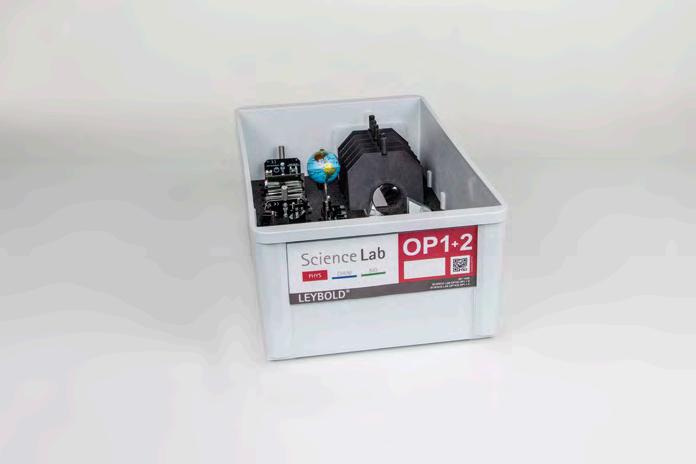

Student experiment set of the student experiment system Science Lab in the field of physics. Set-up material for one working group. The equipment is stored in Science Lab Optics OP1 (207 141S). With the supplementary equipment set OP2, together with the Science Lab Optics OP1, 11 experiments at school, college and university level for worldwide curriculums can be performed. The students deal with the topics chromatics. While working out the curriculum required topics, they are also trained in communication and assessment skills.
Scope of delivery:
Count Name
1 Triple LED lamp
1 Candle holder
1 Prism, plastic
1 Colour filter set, primary
1 Colour filter set, secondary
Count Name
1 Triple colour filter
1 Diffraction grating 500/mm
1 Extension pin


n Experiments from colour mixing to basics of diffraction
n Ingenious and easy-to-use triple LED lamp can be used to mix three or two colours by simply switching one of the built-in LED chips on and off
n With the included diffraction grating, students start discussing their first thoughts on diffraction as well as colour decomposition

The universal student measuring device with WiFi for all measuring tasks in physics, chemistry and biology.
www.leybold-shop.com/524005W2


Here you will find an overview of our literature packages. You can find detailed information on our literature on the internet at www.leybold-shop.com.

Detailed experiment instructions relating to Science Lab Set OP2 (207 142S) in conjunction with Science Lab Set OP1 (207 141S). Describes 11 experiments from the fields of chromatics. Topics:
Examination of the light paths through a prism; Spectral colours; Colour mixing
520 7142EN LIT-print: LP5.2 Chromatics


Comprehensive physics experiment instructions in the field of optics for the Science Lab. Contains 72 experiments on ray optics and geometrical optics, chromatics, wave optics and polarisation.
Includes all interactive experiment instructions (Lab Docs) as html file.
520 714 LIT-digital: LP5 Science Lab Optics
Comprehensive physics experiment instructions for the Science Lab. Contains more than 460 experiments in the fields of mechanics, energy, electricity and electronics, optics, atomic and nuclear physics as well as informatics and technology.
Includes all interactive experiment instructions (Lab Docs) as html file.
520 71 LIT-digital: LP Science Lab Physics
Technical data of the digital version:
• Product key for literature (activation & selection of one literature language in LeyLab)
• Can then be used in LeyLab and Document Center (school/institute licence)
• System requirements:
Document Center:
- PC with Windows 7 or higher; internet access during installation; local network for distribution to students LeyLab:
- PC, tablet or smartphone with a current browser; internet access






Operation using a power bank
n The triple LED lamp can be operated via the USB output on the Mobile-CASSY 2 WiFi, via a power bank or the USB AC adapter
n All experiments can be performed with the triple LED lamp without a power supply with the Mobile-CASSY 2 WiFi or a power bank

Operation using the Mobile-CASSY 2 WiFi

Operation using an AC adapter
If the triple LED lamp is switched from two to three light sources, colour mixing experiments can be performed with either two or three colours.
LP5.3.1
LP5.3.1.1
LP5.3.1.1C
LP5.3.1.2
LP5.3.1.3
LP5.3.1.4
LP5.3.1.5
Diffraction on diffraction objects
Diffraction at a slit
Diffraction at a slit (with Mobile-CASSY 2 WiFi)
Diffraction at a double slit
Diffraction at multiple slits
Diffraction at gratings
Diffraction at reflection gratings
LP5.3.2 Diffraction on complementary apertures
LP5.3.2.1
LP5.3.2.2 Slit and bar (Babinet’s principle)
Complementary crossed gratings (Babinet’s principle)
LP5.3.3 Two-beam interference
LP5.3.3.1
LP5.3.3.2
LP5.3.3.3
Fresnel’s double mirror experiment
Fresnel’s biprism experiment Newton’s rings 11
For experiments marked with „C“, the measurements are carried out digitally
EXPERIMENTS


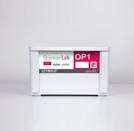
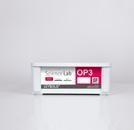
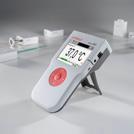



Student experiment set of the student experiment system Science Lab in the field of physics. Set-up material for one working group in pre-formed tray. With the equipment set OP3, together with the Science Lab Optics OP1 (207 141S), 11 experiments at school, college and university level for worldwide curriculums can be performed.
The students deal with the topic wave optics. While working out the curriculum required topics, they are also trained in communication and assessment skills. In combination with the Mobile-CASSY 2 WiFi (524 005W2), there are additional evaluation options which enable the students digital learning.
Scope of delivery: Count
1 Laser class 1, red
1 Diaphragm with single slits
1 Diaphragm with double slits (b=const.)
1 Diaphragm with double slits (d=const.)
1 Diaphragm with multiple slits
with slit and wire
with wire-mesh gratings
471 08
for Newton’s rings
Additionally required per class


n Student-safe laser, class 1
n New, improved diffraction objects
n Diffraction phenomena can be visualised with a simple set-up on the precision metal rail (50 cm)
n The lux sensor M can record intensity distributions for different diffraction objects so the students can develop the topic on a deeper level
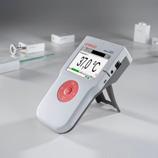
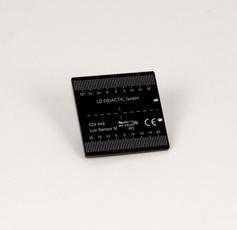
The universal student measuring device with WiFi for all measuring tasks in physics, chemistry and biology.
005W2
2 WiFi
Detailed information on the Mobile-CASSY 2 WiFi can be found on the Internet at www.leybold-shop.com/524005W2
Lux sensor M
For measuring the illuminance of visible light with Mobile-CASSY 2 WiFi (524 005W2). The lux sensor has a flat design so that it can, for example, be inserted directly into the holder for diaphragms and slides (459 33). With the lux sensor, measurements can be performed along and orthogonal to the optical axis. A printed millimetre scale is used to position the sensor on the optical axis and also enables the recording of intensity distributions of different diffraction objects (e.g.469 731) without additional equipment.
524 444 Lux sensor M
You can find detailed information on this and other sensors on the internet at www.leybold-shop.com.
Here you will find an overview of our literature packages. You can find detailed information on our literature on the internet at www.leybold-shop.com.

Detailed experiment instructions relating to Science Lab Set OP3 (207 143S) in conjunction with Science Lab Set OP1 (207 141S). Describes 11 experiments from the fields of wawe optics.
Topics: Diffraction on diffraction objects; Diffraction on complementary apertures
520 7143EN LIT-print: LP5.3 Wave optics
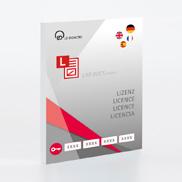

Comprehensive physics experiment instructions in the field of optics for the Science Lab. Contains more than 70 experiments on ray optics and geometrical optics, chromatics, wave optics and polarisation.
Includes all interactive experiment instructions (Lab Docs) as html file.
520 714 LIT-digital: LP5 Science Lab Optics
Comprehensive physics experiment instructions for the Science Lab. Contains more than 460 experiments in the fields of mechanics, energy, electricity and electronics, optics, atomic and nuclear physics and arduino.
Includes all interactive experiment instructions (Lab Docs) as html file.
520 71 LIT-digital: LP Science Lab Physics
Technical data of the digital version:
• Product key for literature (activation & selection of one literature language in LeyLab)
• Can then be used in LeyLab and Document Center (school/institute licence)
• System requirements:
Document Center:
- PC with Windows 7 or higher; internet access during installation; local network for distribution to students LeyLab:
- PC, tablet or smartphone with a current browser; internet access
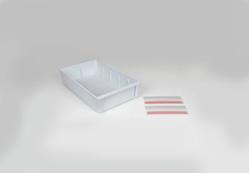

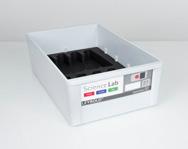



DIFFRACTION AND INTERFERENCEEXCITING TOPICS
n Laser complies with safety regulations (class 1 in accordance with DIN EN 60825-1:2015-07)
n In comparison, most commercially available laser pointers are categorised in class 2 and their suitability for student experiments is limited


n Simple performance of diffraction experiments in a confined space
n By providing suitable diffraction objects
n No additional or complicated observation lenses needed
n Only a few devices are needed
n With the lux sensor M, intensity distributions can also be recorded quantitatively
n Flexible power supply to the laser using a
n Power bank
n Mobile-CASSY 2 WiFi USB output
n USB AC adapter
Sensors
LP5.4.1 Polarisation filters
LP5.4.1.1
LP5.4.1.2C Applying polarisation filters Malus’s law (with Mobile-CASSY 2 WiFi)
LP5.4.2 Photoelastric double refraction
LP5.4.2.1 Chromatic polarisation
LP5.4.3 Polarisation due to reflection an diffraction
LP5.4.3.1
LP5.4.3.2 Polarisation due to reflection Brewster’s law
LP5.4.4 Polarisation due to scattering
LP5.4.4.1 Tyndall effect on an emulsion
LP5.4.5 Optical activity
LP5.4.5.1
LP5.4.5.1C Polarimetry (saccharimetry) Polarimetry (saccharimetry) (with Mobile-CASSY 2 WiFi)
EXPERIMENTS For experiments marked with „C“, the measurements are carried out digitally


LP5.4.5.1 Polarimetry (Saccharimetry)
OVERVIEW OF EQUIPMENT REQUIRED FOR PERFORMING EXPERIMENTS
LP5.4 POLARISATION








Student experiment set of the student experiment system Science Lab in the field of physics. Set-up material for one working group. The equipment can be stored in Science Lab Optics OP3 (207 143S). With the equipment set OP4, together with the Science Lab Optics OP1 (207 141S), 8 experiments at school, college and university level for worldwide curriculums can be performed. The students deal with the topic polarisation. While working out the curriculum required topics, they are also trained in communication and assessment skills. In combination with the Mobile-CASSY 2 WiFi (524 005W2), there are additional evaluation options which enable the students digital learning.
Scope of delivery:


n Experiments about the polarisation of light n Malus‘s law can be easily and vividly demonstrated with the Mobile-CASSY 2 WiFi and the lux sensor M


Mobile-CASSY 2 WiFi
The universal student measuring device with WiFi for all measuring tasks in physics, chemistry and biology.
524 005W2 Mobile-CASSY 2 WiFi
Detailed information on the Mobile-CASSY 2 WiFi can be found on the Internet at www.leybold-shop.com/524005W2
Lux sensor M
For measuring the illuminance of visible light with Mobile-CASSY 2 WiFi (524 005W2). The lux sensor has a flat design so that it can, for example, be inserted directly into the holder for diaphragms and slides (459 33). With the lux sensor, measurements can be performed along and orthogonal to the optical axis. A printed millimetre scale is used to position the sensor on the optical axis and also enables the recording of intensity distributions of different diffraction objects (e.g.469 731) without additional equipment.
524 444 Lux sensor M
You can find detailed information on this and other sensors on the internet at www.leybold-shop.com.
Here you will find an overview of our literature packages. You can find detailed information on our literature on the internet at www.leybold-shop.com.



Detailed experiment instructions relating to Science Lab Set OP4 (207 141S) in conjunction with Science Lab Set OP1 (207 141S). Describes 8 experiments from the fields of polarisation.
Topics: Polarisers; Photoelastic double refraction; Polarisation due to reflection and refraction; Polarisation due to scattering; Optical activity
520 7144EN LIT-print: LP5.4 Polarisation
Comprehensive physics experiment instructions in the field of optics for the Science Lab. Contains 72 experiments on ray optics and geometrical optics, chromatics, wave optics and polarisation.
Includes all interactive experiment instructions (Lab Docs) as html file.
520 714 LIT-digital: LP5 Science Lab Optics
Comprehensive physics experiment instructions for the Science Lab. Contains more than 460 experiments in the fields of mechanics, energy, electricity and electronics, optics, atomic and nuclear physics as well as informatics and technology.
Includes all interactive experiment instructions (Lab Docs) as html file.
520 71 LIT-digital: LP Science Lab Physics
Technical data of the digital version:
• Product key for literature (activation & selection of one literature language in LeyLab)
• Can then be used in LeyLab and Document Center (school/institute licence)
• System requirements: Document Center:
- PC with Windows 7 or higher; internet access during installation; local network for distribution to students LeyLab:
- PC, tablet or smartphone with a current browser; internet access






Students answer questions in their own Lab Doc.
n When not connected to the Mobile-CASSY 2 WiFi, the measured values read can be entered manually
n The diagram is then automatically completed
The student is currently entering the sixth measuring value for illuminance



n Lux sensor M, is automatically recognised by the Mobile-CASSY 2 WiFi
n Interactivity between measuring device and Lab Doc
n Illuminance is measured directly by using the lux sensor M

PERFORMING THE EXPERIMENT

Radioactivity has mostly negative associations such as nuclear reactor accidents. But radioactivity is also, in fact, completely natural. For example, the air that we breathe contains decay products of radon. These can be detected with a comprehensible experiment.
Different concentrations can also be measured in tap and rain water depending on the region. The human body has adjusted to this environmental radioactivity and copes with it well. This is known as background radiation.
In the Science Lab Set Atomic and Nuclear Physics, students investigate this environmental radioactivity.

Students will investigate the decay products of radon. For this experiment you will need the set Science Lab Radioactivity RA (207 152S)
EXPERIMENT TOPICS
LP6.2 ENVIRONMENTAL RADIOACTIVITY
LP6.2.1 INTRODUCTION TO RADIOACTIVITY
LP6.2.2 INVESTIGATING THE INFLUENCE OF SAMPLE PROPERTIES AND THE SIZE OF THE MEASUREMENT WINDOW
LP6.2.3 ENVIRONMENTAL RADIOACTIVITY
LP6.2.4 STATISTICS OF RADIOACTIVE DECAY
LP6.2.5 RADIATION SHIELDING
LP6.2.6 DISTANCE
LP6.2.7 INVESTIGATING THE RADIATION IN A MAGNETIC FIELD
LP6.2.8 HALF-LIFE


LP6.2.7.1C The influence of a magnet on beta radiation
Students will investigate how a magnetic field can deflect beta radiation. For this experiment you will need the set Science Lab Radioactivity
Further information about our curriculum-compliant topics and student experiments as well as the corresponding sets can be found on the following pages.
LP6.2.1 Introduction to radioactivity
LP6.2.1.1
LP6.2.1.1C
LP6.2.1.2
LP6.2.1.2C
LP6.2.1.3
LP6.2.1.3C
LP6.2.1.4
LP6.2.1.4C
LP6.2.1.5
LP6.2.1.5C
Detecting radioactive radiation in the environment
Detecting radioactive radiation in the environment (with Mobile-CASSY 2 WiFi)
Detecting radioactive radiation in the surrounding air (underground)
Detecting radioactive radiation in the surrounding air (underground) (with Mobile-CASSY 2 WiFi)
Detecting radioactive radiation in a button shaped source
Detecting radioactive radiation in a button shaped source (with Mobile-CASSY 2 WiFi)
Safety rules when working with radioactive materials
Safety rules when working with radioactive materials (with Mobile-CASSY 2 WiFi)
Number of N pulses and R counting rate
Number of N pulses and R counting rate (with Mobile-CASSY 2 WiFi)
LP6.2.2 Investigating the influence of sample properties and the size of the measurement window
LP6.2.2.1
LP6.2.2.1C
LP6.2.2.2
LP6.2.2.2C
LP6.2.2.3
LP6.2.2.3C
Potassium chloride in different layer thicknesses
Potassium chloride in different layer thicknesses (with Mobile-CASSY 2 WiFi)
Potassium chloride as normal
Potassium chloride as normal (with Mobile-CASSY 2 WiFi)
Counting rate when screening the entrance window
Counting rate when screening the entrance window (with Mobile-CASSY 2 WiFi)
LP6.2.3 Environmental radioactivity
LP6.2.3.1
LP6.2.3.1C
LP6.2.3.2
LP6.2.3.2C
LP6.2.3.3
LP6.2.3.3C
LP6.2.3.4
LP6.2.3.4C
Detecting decay products in the air
Detecting decay products in the air (with Mobile-CASSY 2 WiFi)
Detecting decay products in fresh tap water
Detecting decay products in fresh tap water (with Mobile-CASSY 2 WiFi)
Detecting decay products in rain water
Detecting decay products in rain water (with Mobile-CASSY 2 WiFi)
Detecting decay products in freshly fallen snow
Detecting decay products in freshly fallen snow (with Mobile-CASSY 2 WiFi)
LP6.2.4 Statistics of radioactive decay
LP6.2.4.1
LP6.2.4.1C
LP6.2.4.2
LP6.2.4.2C
LP6.2.4.3
LP6.2.4.3C
Investigating the fluctuations when measuring the pulse count
Investigating the fluctuations when measuring the pulse count (with Mobile-CASSY 2 WiFi)
Statistical examination of the radiation of the button shaped source
Statistical examination of the radiation of the button shaped source
Statistical examination of the radiation of the potassium chloride
Statistical examination of the radiation of the potassium chloride
LP6.2.5 Radiation shielding
LP6.2.5.1
LP6.2.5.1C
LP6.2.5.2
LP6.2.5.2C
Radiation shielding from the button shaped source using different materials
Radiation shielding from the button shaped source using different materials (with Mobile-CASSY 2 WiFi)
Radiation shielding from the button shaped source using different material thicknesses
Radiation shielding from the button shaped source using different material thicknesses (with Mobile-CASSY 2 WiFi)
LP6.2.6 Distance
LP6.2.6.1
LP6.2.6.1C
Dependence of the counting rate on the distance between button shaped source & counter tube
Dependence of the counting rate on the distance between button shaped source & counter tube (with Mobile-CASSY 2 WiFi)
LP6.2.7 Investigating the radiation in a magnetic field
LP6.2.7.1
LP6.2.7.1C
LP6.2.7.2
LP6.2.7.2C
The influence of a magnet on beta radiation
The influence of a magnet on beta radiation (with Mobile-CASSY 2 WiFi)
Use of the influence of a magnet on beta radiation
Use of the influence of a magnet on beta radiation (with Mobile-CASSY 2 WiFi)
LP6.2.8 Half-life
LP6.2.8.1
LP6.2.8.1C
Evaluation of a test series with radon water
Evaluation of a test series with radon water (with Mobile-CASSY 2 WiFi)
For experiments marked with „C“, the measurements are carried out digitally with the Mobile-CASSY 2 WiFi. GM adapter M




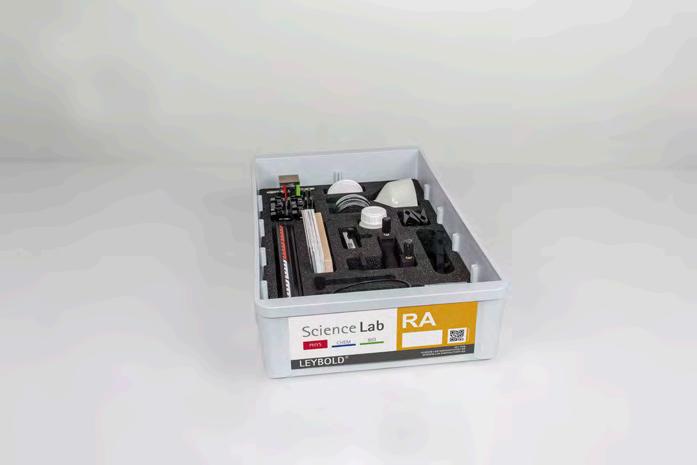

Student experiment set of the student experiment system Science Lab in the field of physics. Set-up material for one working group in pre-formed tray With the equipment set RA, in combination with the Mobile-CASSY 2 WiFi (524 005W2) and the GM adapter M (524 440) or with the counter S (575 471), 42 experiments at school, college and university level for worldwide curriculums can be performed. The students deal with the topic radioactivity and in particular with the environmental radioactivity. While working out the curriculum required topics, they are also trained in communication and assessment skills. The additional possibility of using the Mobile-CASSY 2 WiFi (524 005W2) enables the students the access of digital learning.
Scope of delivery:
Count Name
1 Plate holder on rod
1 Precision metal rail, 25 cm
4 Clamp rider
1 Horseshoe magnet, small
1 Buffer and Plastic Plate
1 Pancake GM counter tube
1 Holder for Pancake GM counter
1 Holder for radiation emitter and magnet
Count Name
1 Tray, low
25 out of Round filter fiber glass, 55 mm Ø, Set of 100
1 Petri dish 60 mm
1 Büchner funnel porcelain, for filters with 55 mm Ø
2 out of Plastic clamps, span 1.2 cm, set of 3
1 Potassium Chloride 50 g
1 Frame and Set of Aluminium slides
207 152S Science Lab Radioactivity RA (Set)
Additionally required per working group
Count
1 524 005W2 Mobile-CASSY 2 WiFi for digital experiments
1 524 440 GM adapter M
1 559 460 Button-shaped source
1 575 471 Counter S alternative for analog measurements
1 LDS00001 Stopwatch, digital alternative for analog measurements
Additionally required per class
Count Cat.-No. Name
1 520 715 LIT-digital: LP6 Science Lab Atomic and nuclear physics
1 666 767 Hotplate, 1500 W, 180 mm Ø
1 ADACB501 Compact scale 500 g: 0.1 g


n Proof of all relevant phenomena of environmental radioactivity
n Includes a large area (Pancake) GM counter tube with a stable protection net for the measurement of low decay rates
n The additionally required button-shaped source is below the exemption limits in Germany and many other countries
n Devices and detailed instructions were developed in cooperation with Prof. Dr. phil. Henning von Philipsborn (University of Regensburg)
n Acquired skills: Communication and evaluation
524 005W2 Mobile-CASSY 2 WiFi STUDENT MEASURING DEVICE

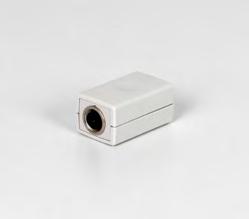
Mobile-CASSY 2 WiFi
The universal student measuring device with WiFi for all measuring tasks in physics, chemistry and biology.
Detailed information on the Mobile-CASSY 2 WiFi can be found on the Internet at www.leybold-shop.com/524005W2
For measuring radioactive radiation with a Geiger-Mueller counter tube (559 01 or 559 012) with Mobile-CASSY 2 WiFi (524 005W2).
524 440 GM adapter M
Detailed information on this and other sensors can be found on the Internet at www.leybold-shop.com
Here you will find an overview of our literature packages. You can find detailed information on our literature on the internet at www.leybold-shop.com.

Detailed experiment instructions relating to Science Lab Set RA (207 152S). Describes 42 experiments from the fields of environmental radioactivity.
Topics:
Introduction to radioactivity; Investigating the influence of sample properties and the size of the measurement window; Environmental radioactivity; Statistics of radioactive decay; Radiation shielding; Distance; Investigating the radiation in a magnetic field; Half-life
520 7151EN LIT-print: LP6.2 Environmental radioactivity

SUBJECT AREA SUBJECT

Comprehensive physics experiment instructions in the field of atomic and nuclear physics for the Science Lab. Contains 42 experiments on environmental radioactivity.
Includes all interactive experiment instructions (Lab Docs) as html file.
520 715 LIT-digital: LP6 Science Lab Atomic and Nuclear Physics
Comprehensive physics experiment instructions for the Science Lab. Contains more than 460 experiments in the fields of mechanics, energy, electricity and electronics, optics, atomic and nuclear physics as well as informatics and technology.
Includes all interactive experiment instructions (Lab Docs) as html file.
520 71 LIT-digital: LP Science Lab Physics
Technical data of the digital version:
• Product key for literature (activation & selection of one literature language in LeyLab)
• Can then be used in LeyLab and Document Center (school/institute licence)
• System requirements:
Document Center:
- PC with Windows 7 or higher; internet access during installation; local network for distribution to students LeyLab:
- PC, tablet or smartphone with a current browser; internet access





INTRODUCING THE TOPIC
The term “radioactivity” makes most people feel uneasy or anxious because it immediately makes them think of nuclear disasters. Therefore, it is important that students see a different picture and learn that natural radioactivity exists in our everyday lives that we cannot avoid and what this means. With the RA set, for example, radioactive radon can be collected from the ambient air, concentrated and detected from the air around us.
n The button-shaped source allows you to conduct reproducible and quantitative experiments on the basic properties of radioactive radiation
n With the large area (Pancake)
Geiger-Mueller counter tube from the set RA, all experiments are possible despite weak activity levels
n Quick and easy experimental procedure



n A “button” of uranium-coloured green glass
n Inserted into a holder
n Supplied with a certificate that confirms:
n Maximum activity of 250 Bq U-238
n No activity of thorium or radium
n Activity does not spread into the environment as the uranium is embedded into the glass
n Easy to use in the classroom
n Protected against theft
n The button-shaped source is far below the exemption limit (2.5 %)
n The sources may be used in the classroom without any particular advanced training as per German radiation protection law*
n Due to the low activity of the radioactive substances, there is no danger when being handled by untrained persons
Microcontrollers are integrated into our everyday lives in many different ways. Among other things, they are used in everyday devices such as temperature controllers, alarm systems, toys or even in the smart home sector. In the Science Lab set Arduino (IT1), the students will playfully discover the fascinating world of technology and learn the interplay between programming and electronics. After an introduction to the use of microcontrollers, the students are gradually introduced to programming using everyday examples so that they can then realise larger projects, e.g. in the field of artificial intelligence.
In the Science Lab Arduino, the students learn in which ways tasks can be taken over by a microcontroller.

In this experiment, students will work with variables and operators to program a digital thermo-meter to output temperatures in different temperature scales on the serial monitor. For this experiment you will need the set Science Lab Physik Arduino IT1 (207 161)
EXPERIMENT TOPICS
LP8.1.1 INTRODUCTION TO MICROCONTROLLER PROGRAMMING
LP8.1.2 DATA TYPES
LP8.1.3 VARIABLES AND OPERATORS
LP8.1.4 ERROR ANALYSIS
LP8.1.5 CONTROL STRUCTURES
LP8.1.6 SMALLER PROJECTS


For more information on our curriculum-compliant topics and student experiments, as well as the corresponding sets, please see the following pages.
LP8.1.1 Introduction to microcontroller programming
LP8.1.1.1
LP8.1.1.2
LP8.1.1.3 The flashing LED Hello World The distance measurement
LP8.1.2 Data types
LP8.1.2.1
LP8.1.2.2 The temperature measurement The light switch
LP8.1.3 Variables and operators
LP8.1.3.1
LP8.1.3.2 The temperature calculator The stepper motor control
LP8.1.4 Error analysis
LP8.1.4.1
LP8.1.4.2 The timer The simple traffic light circuit
LP8.1.5 Control structures
LP8.1.5.1
LP8.1.5.2
LP8.1.5.3
LP8.1.5.4 The automatic roller shutter The parking aid The SOS signal The pedestrian-dependent traffic light circuit
LP8.1.6 Smaller projects
LP8.1.6.1 The brightness control
14
EXPERIMENTS
Learning to program using a microcontroller is an extremely valuable skill that offers students numerous advantages. This method makes it possible to immerse oneself step-by-step in the world of programming, using everyday examples and practical applications as listed in the experiment list.
Skills to be learned during the experiments include:
Application-oriented learning: Programming with microcontrollers allows students to get immediate results and experience. They can write programs that solve real problems, such as controlling lights, motors or sensors.
Promoting problem-solving skills: Students learn how to think analytically and break down complex problems into smaller, more manageable subtasks.
Creativity and innovation: Programming opens up opportunities for students to put their creative ideas into action. They can develop their own projects and design personalised solutions to specific challenges.
Digital competence: In an increasingly digitalised world, understanding programming and microcontrollers is of great importance.
Preparing for the future: Programming skills are in demand in many professions, whether it‘s informatics, engineering, robotics, or even fields like medicine and art.

The students will programme, test and optimise a functioning traffic light circuit without additional dependencies by systematically analysing and correcting semantic errors. For this experiment you will need the set Science Lab Physik Arduino IT1 (207 161)
OVERVIEW OF EQUIPMENT FOR PERFORMING ALL EXPERIMENTS
LP8.1 Programming with Arduino




Student experiment set of the student experiment system Science Lab in the field of technology. Set-up material for 4 students in pre-formed tray. With the equipment set IT1 more than 14 experiments at high school, college and basic university level for worldwide curriculums can be performed. The students deal with the topics programming and the use of microcontrollers in experiments with clear relevance to everyday life. While working out the curriculum required topics, they are also trained in communication and assessment skills.
Scope of delivery:
Count Name
4 Arduino UNO R3 micro controller
1 OLED - 0.96" display VGSS, I2C (set of 4)
1 Temperature sensor LM35 (set of 4)
1 Button with XH2.54 3P socket (set of 4)
1 Rotary Encoder CJMCU-111 (set of 4)
1 Stepper motor 28BYJ-48 (set of 4)
1 3x4 keypad (set of 4)
1 Sensor shield V 5.0 (set of 4)
1 Ultrasonic sensor HC-SR04 (set of 4)
1 Traffic light module 5 V (set of 4)
Count Name 1 Passive buzzer KY-006 (set of 4) 1 Battery clip 9 V with DC plug (set of 4) 1 LDR 10 K photoresistor (set of 4) 1 Breadboard cable f/f 20 cm 40 pcs (set of 4) 1 Breadboard cable m/f 20 cm 40 pcs (set of 4)
207 161 Science Lab Arduino IT1 (Set)

Additionally required per student
Count Cat.-No. Name
1 685 45 Battery 9 V (block)
Additionally required per class
Count Cat.-No. Name
1 520 718 LIT-digital: LP8 Sience Lab Projects Arduino
n Equipment set with materials in 4-fold version
n 14 experiments in total
n Step-by-step introduction to microcontroller programming
n Everyday examples to prepare for larger projects
n Little preparation necessary for teacher/lecturer
Here you will find an overview of our literature packages. You can find detailed information on our literature on the internet at www.leybold-shop.com.


Comprehensive physics experiment instructions in the field of physics project Arduino for the Science Lab. Contains 14 experiments on control, regulation and programming of microcontrollers.
Includes all interactive experiment instructions (Lab Docs) as html file.
Comprehensive physics experiment instructions for the Science Lab. Contains more than 460 experiments in the fields of mechanics, energy, electricity and electronics, optics, atomic and nuclear physics as well as informatics and technology. Includes all interactive experiment instructions (Lab Docs) as html file.
520 71 LIT-digital: LP Science Lab Physics
Technical data of the digital version:
• Product key for German or English literature (activation and selection of the literature language via https://register.leylab.de necessary)
• System requirements: Document Center:
- PC with Windows 7 or higher
- Internet access during installation
- Local network for distribution to students Leylab:
- PC, tablet or smartphone with a current browser
- Internet access


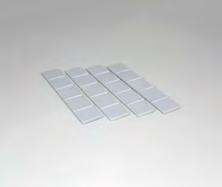

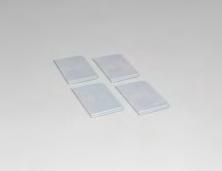
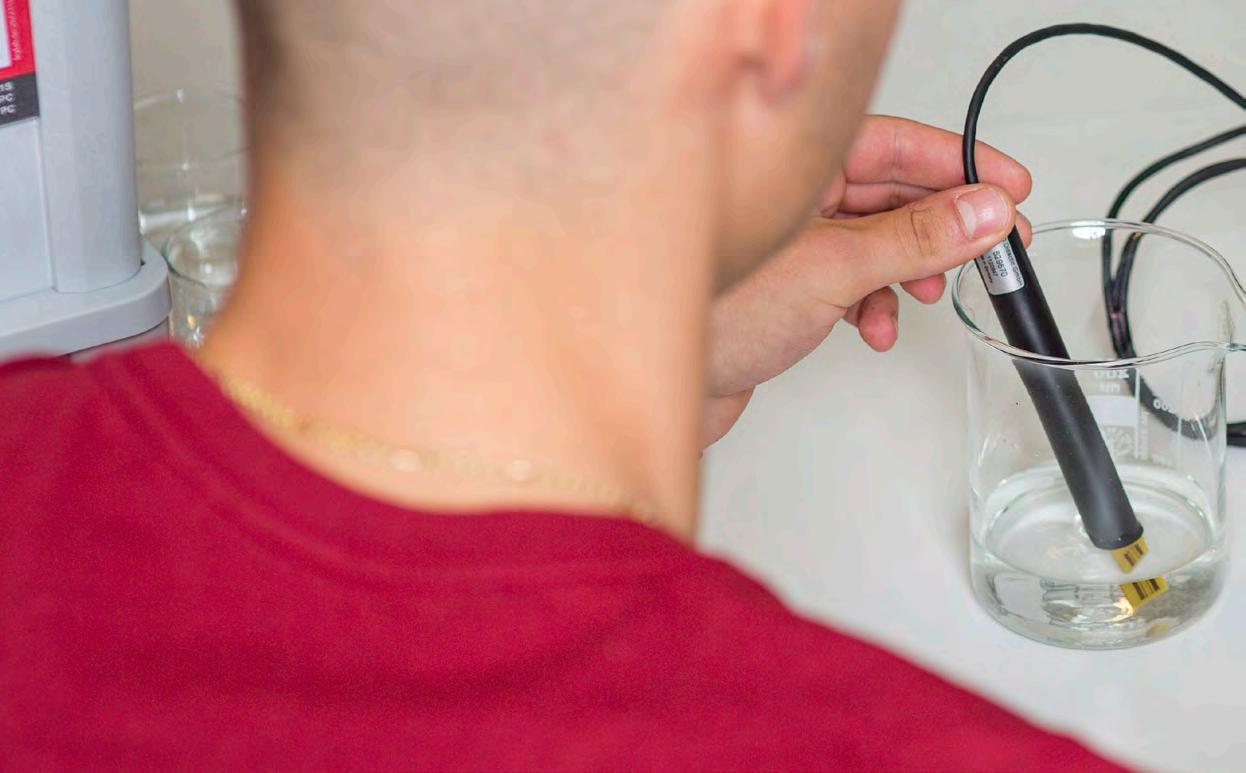
Here you will find a complete overview of our Science Lab student experiments in the field of chemistry.


EXPERIMENT TOPICS
LC1.1 GENERAL METHODS & SEPARATION METHODS Properties of substances; Mixtures of substances; Separation of substances
LC1.2 WATER
Water as a solvent; Analysis, synthesis and detection of water; Water treatment
LC1.3 AIR, GASES AND THEIR PROPERTIES Gases - synthesis, detection and properties; Air and combustion
LC1.4 ACIDIC AND ALKALINE SOLUTIONS Acidic and alkaline; Acids, Alkaline solutions; Protolysis equilibrium; Titrations; Neutralisation and salification
LC1.5 SALTS Ion detection; Utilising salts
LC1.6 METALS Properties of metals; Use of metals; Complex chemistry
LC1.7 REDOX REACTIONS Oxidation; Redox titration
Characteristics of a chemical reaction; Chemical laws


LC1.8 CHEMICAL REACTIONS
LC1.9 NEW FIELDS IN CHEMISTRY Nanochemistry
EXPERIMENT
LC2.1 ORGANIC SUBSTANCES Characteristics of organic substances; Elements in organic substances
LC2.2 HYDROCARBONS Saturated hydrocarbons; Unsaturated hydrocarbons; Petrochemistry
LC2.3 ALCOHOLS, ALDEHYDES AND KETONES Production of alcohols; Detection of alcohols; Properties and uses of alcohols; Aldehydes; Ketones
LC2.4 CARBOXYLIC ACIDS AND ESTERS


Production of carboxylic acids; Properties and uses of carboxylit acids; Production and properties of esters
LC2.5 REACTIONS IN ORGANIC CHEMISTRY Addition reactions; Substitution reactions
LC2.6 METHODS OF ORGANIC CHEMISTRY Distillations
LC3.1 ELECTROCHEMISTRY
LC3.2 PHYSICAL PROCESSES
LC3.3 ENERGY IN CHEMICAL REACTIONS
LC3.4 RATE OF REACTION
LC3.5 CHEMICAL EQUILIBRIUM
Electrial conductivity; Electrochemical potentials; Galvanic elements; Applied electrochemistry; Electrolysis
Particle movement
Calorimetry; Reaction heat
Course of a reaction; Influencing the rate of reaction
Chemical equilibrium; Le Chatelier‘s priniciple; The law of mass action and its applications



LC4.2 GLASS
LC4.3 METALS
Alloys
LC4.4 CHEMICAL APPLICATIONS Fertilisers; Photography
LC4.5 PRODUCTS OF THE ORGANIC INDUSTRY Pigment and Dyestuffs; Plastics; Soaps
LC5.2 CARBOHYDRATES Properties of carbohydrates; Extraction of sugars;
LC5.3
LC5.4 FOOD

Preservatives; Additives
n This Basic Set contains the basic devices which are regularly needed for student experiments in chemistry.
n Each device has its own specified space in the pre-formed storage tray.
n With four different thematic sets more than 250 student experiments can be performed in chemistry.
n One Basic Set for all fields of chemistry and a maximum of two trays on the student workstation.
n The Basic Set contains the material required for one work groupconsisting of 2-3 students.
n Experiments from the Science Lab Chemistry can then be carried out with only one additional set, depending on the topic.
n Same devices = always the same handling: no need to re-learn devices for every topic.


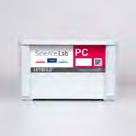




Student experiment set of the student experiment system Science Lab in the field of chemistry. Basic equipment for experiments in inorganic and general chemistry, organic chemistry, physical chemistry, technical and biochemistry. Set-up material for one working group in pre-formed tray. The individual trays are stackable and can optionally be closed with a lid (647 003).
The equipment set Science Lab Chemistry Basic CB, in combination with at least one of the following chemistry sets, enables the performance of experiments at school, college and university level for worldwide curriculums:
• Experiment set Science Lab Inorganic Chemistry AC (207 211S)
• Experiment set Science Lab Organic Chemistry OC (207 221S)
• Experiment set Science Lab Physical Chemistry PC (207 231S)
• Experiment set Science Lab Technical and Biochemistry TBC (207 241S)
Scope of delivery:
Count Name
2 Bosshead S
2 Stand base MF
1 Stand feet, pair
3 Stand rod 40 cm, 10 mm Ø
1 Universal pencil
1 Thermometer, -10...+150 °C/1 K
1 Powder spatula, steel, 185 mm
1 Tray, high
1 Round filter, Type 595, 125 mm Ø, Set of 100
1 Boiling stones 100 g
5 Watch glass dish 80 mm Ø
3 Glass stirring rod 200 x 8 mm Ø
1 Measuring cylinder 100 ml, with plastic base
5 Dropping pipette 150 mm x 7 mm Ø
5 Rubber bulb
2 Graduated pipette 10 ml
1 Pipetting ball (Peleus ball)
2 Universal clamp 0...80 mm
1 Test tube brush with head bundle 20 mm Ø
1 Scissors 125 mm, round-ended
1 Laboratory knife
1 Tweezers, blunt, 130 mm
1 Test tube holder 20 mm Ø
1 Crucible tongs 200 mm
1 Test tube rack metal 20 mm Ø
1 Universal indicator paper pH 1...14, roll
207 200S Science Lab Chemistry Basic CB (Set)
Additionally required:
Count Cat.-No. Name
1 207 211S Science Lab Inorganic Chemistry AC (Set)
1 207 221S* Science Lab Organic Chemistry OC (Set)
1 207 231S* Science Lab Physical Chemistry PC (Set)
1 207 241S* Science Lab Technical and Biochemistry TBC (Set)
* alternative
Additionally recommended:
Count Cat.-No. Name
1 647 003 Lid for tray

The Inorganic and General Chemistry experiment collection effortlessly arouses fascination towards chemistry: The Science Lab Set Inorganic Chemistry consists of two trays AC1 and AC2 and includes devices for both basic and advanced experiments, important for chemistry classes/lectures at school, college and university level.
Your students will use this set to carry out perceivable experiments, such as “Red cabbage as an indicator”, as well as complex experiments such as conductivity titrations or redox titrations.

In this experiment, the boiling temperatures of water and methylated spirits are determined. For this purpose, the temperature of the respective liquid is measured at constant time intervals during the heating process with the help of the Mobile-CASSY 2 WiFi. The value pairs are then plotted on a graph to determine the boiling temperature from the curve. For this experiment you will need the sets Science Lab Chemistry Basic CB (207 200S) and Science Lab Inorganic Chemistry AC (207 211S)
EXPERIMENT
LC1.1 GENERAL METHODS & SEPARATION METHODS
LC1.2 WATER
LC1.3 AIR, GASES AND THEIR PROPERTIES
LC1.4 ACIDIC AND ALKALINE SOLUTIONS
LC1.5 SALTS
LC1.6 METALS
LC1.7 REDOX REACTIONS
LC1.8 CHEMICAL REACTIONS
LC1.9 NEW FIELDS IN CHEMISTRY


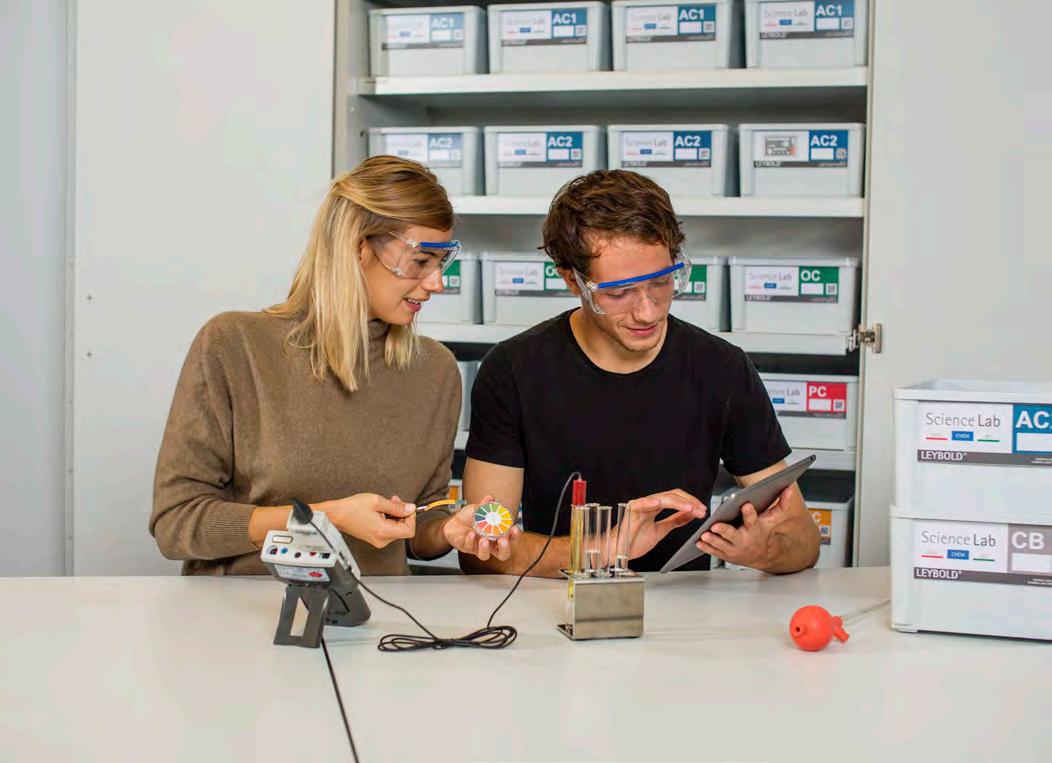
In this experiment, students will learn how to determine the pH values of solutions with pH paper and how to measure these with the Mobile-CASSY 2 WiFi and a pH probe. For this experiment you will need the sets Science Lab Chemistry Basic CB (207 200S) and Science Lab Inorganic Chemistry AC (207 211S)
Further information about our curriculum-compliant topics and student experiments as well as the corresponding sets can be found on the following pages.
Sensors
LC1.1 GENERAL METHODS & SEPARATION METHODS
LC1.1.1 Properties of substances
LC1.1.1.1
LC1.1.1.2
LC1.1.1.2C
LC1.1.1.3
Density, solubility, magnetisability and colour
Boiling point
Boiling point (with Mobile-CASSY 2 WiFi)
Sublimation
LC1.1.2 Mixtures of substances
LC1.1.2.1
LC1.1.2.2
LC1.1.2.3
LC1.1.2.4
Heterogeneous mixtures
Homogeneous mixtures
Comparison of different solvents
Solutions, colloids and suspensions
LC1.1.3 Separation of substances
LC1.1.3.1
LC1.1.3.2
LC1.1.3.3
LC1.1.3.4
LC1.1.3.5
LC1.1.3.6
LC1.1.3.7
LC1.1.3.8
Evaporation
Elutriation and decanting
Separation by melting and by magnets
Purification of rock salt
Separation of immiscible liquids
Extraction
Separation of substances by solvent extraction
Chromatography
LC1.2 WATER
LC1.2.1 Water as a solvent
LC1.2.1.1
LC1.2.1.2
LC1.2.1.3
LC1.2.1.4C
LC1.2.1.5
LC1.4.2 Acids
LC1.4.2.1C
LC1.4.2.2
LC1.4.2.2C
Conductivity of strong and weak acids (with Mobile-CASSY 2 WiFi)
Sulphuric acid and its properties
Sulphuric acid and its properties (with Mobile-CASSY 2 WiFi)
LC1.4.3 Alkaline solutions
LC1.4.3.1
LC1.4.3.2
LC1.4.3.2C
LC1.4.3.3
LC1.4.3.4
LC1.4.3.5
Using alkaline solutions in everyday life
Reaction of hydroxides with water
Reaction of hydroxides with water (with Mobile-CASSY 2 WiFi)
Reaction of alkali metals and alkaline earth metals with water
Reaction of metal oxides with water
Ammonia as an alkaline solution
LC1.4.4 Protolysis equilibrium
LC1.4.4.1C
LC1.4.4.2
LC1.4.4.2C
LC1.4.4.3C
Multi-step protolysis of phosphoric acid (with Mobile-CASSY 2 WiFi)
Buffer solutions
Buffer solutions (with Mobile-CASSY 2 WiFi)
From the pH value to the pKa value (with Mobile-CASSY 2 WiFi)
LC1.4.5 Titrations
LC1.4.5.1
LC1.4.5.2
LC1.4.5.3
LC1.4.5.3C
LC1.4.5.4
LC1.4.5.4C
LC1.4.5.5C
LC1.4.5.6C
Titration of hydrochloric acid with sodium hydroxide solution
Determining the acetic acid content in vinegar
Recording a titration curve
Recording a titration curve (with Mobile-CASSY 2 WiFi)
Selecting an indicator for titration
Selecting an indicator for titration (with Mobile-CASSY 2 WiFi)
Amino acids as dipolar ions (with Mobile-CASSY 2 WiFi)
Conductometric titration (with Mobile-CASSY 2 WiFi)
Detection of dissolved solid substances in different water samples
Detection of dissolved gases in drinking water
Total hardness of water
Saturated solutions (with Mobile-CASSY 2 WiFi)
Influencing the process of dissolution
LC1.2.2 Analysis, synthesis and detection of water
LC1.2.2.1
LC1.2.2.2 Water splitting and water synthesis
Chemical testing for water
LC1.2.3 Water treatment
LC1.2.3.1
LC1.2.3.2C
Filtering with gravel and activated charcoal filters Oxygen content of water (with Mobile-CASSY 2 WiFi)
LC1.3 AIR, GASES AND THEIR PROPERTIES
LC1.3.2 Gases - synthesis, detection and properties
LC1.3.2.1
LC1.3.2.2
LC1.3.2.3
LC1.3.2.4
Oxygen - synthesis, detection and properties
Carbon dioxide - synthesis, detection and properties
The carbon dioxide fire extinguisher Hydrogen - synthesis and properties
LC1.3.3 Air and combustion
LC1.3.3.1
LC1.3.3.2
LC1.3.3.3
LC1.3.3.4
Functionality of the burner
Importance of air for combustion processes
Oxygen content of air
Production of charcoal
LC1.4 ACIDIC
LC1.4.1 Acidic and alkaline
LC1.4.1.1
LC1.4.1.2
LC1.4.1.3
LC1.4.1.4
LC1.4.1.4C
LC1.4.1.5C
LC1.4.1.6
Effects of acids on indicators
LC1.4.6 Neutralisation and salification
LC1.4.6.1
LC1.4.6.2
LC1.4.6.3
Neutralisation
Reaction of metals with acids
Reaction of metal oxides with acids
LC1.5 SALTS
LC1.5.2 Ion detection
LC1.5.2.1
LC1.5.2.2
LC1.5.2.3
LC1.5.2.4
LC1.5.2.5
Detection of carbonate ions
Detection of chloride ions
Detection of sulphate ions
Detection of iron ions
Detection of copper ions
LC1.5.3 Utilising salts
LC1.5.3.1
LC1.5.3.1C
LC1.5.3.2
LC1.5.3.2C
Growing crystals
Growing crystals (with Mobile-CASSY 2 WiFi)
Cold and heat mixtures
Cold and heat mixtures (with Mobile-CASSY 2 WiFi)
LC1.6 METALS
LC1.6.1 Properties of metals
LC1.6.1.1
LC1.6.1.2
LC1.6.1.3
LC1.6.1.4
LC1.6.1.5
Heating metals
The copper envelope
Combustion of metals
The rusting process
Flame colouration
LC1.6.2 Use of metals
LC1.6.2.1
Rust protection by tin plating and galvanising
LC1.6.2.2
LC1.6.2.3
Heat treatment of steel
Silver mirror
The pH scale
The pH scale (with Mobile-CASSY 2 WiFi)
LC1.4.1.6C Preparing an indicator from red cabbage
Effects of alkaline solutions on indicators
pH paper versus pH electrode (with Mobile-CASSY 2 WiFi)
The pH value of everyday chemicals
The pH value of everyday chemicals (with Mobile-CASSY 2 WiFi)
LC1.6.3 Complex chemistry
LC1.6.3.1 Ligand exchange with copper complexes
LC1.7 REDOX REACTIONS
LC1.7.1 Oxidation
LC1.7.1.1
LC1.7.1.2
LC1.7.1.3
Reaction of metals with air The reason for oxidation Combustion of metals
LC1.7.2 Redox titration
LC1.7.2.1 Redox titration
LC1.8 CHEMICAL REACTIONS
LC1.8.1 Characteristics of a chemical reaction
LC1.8.1.1
LC1.8.1.2 Physical process or chemical reaction? The reaction of copper and iron with sulphur
LC1.8.2 Chemical laws
LC1.8.2.1
LC1.8.2.2 The law of conservation of mass The law of definite proportions
LC1.9 NEW FIELDS IN CHEMISTRY
LC1.9.1 Nanochemistry
LC1.9.1.1
LC1.9.1.2 Solutions, colloids and suspensions Nanochemistry of carbon
For experiments marked with „C“, the measurements are carried out digitally with the Mobile-CASSY 2 WiFi.
Conductivity sensor
Conductivity adapter S pH sensor, BNC pH adapter S

LC1.6.1.1 Heating metals
OVERVIEW OF EQUIPMENT REQUIRED FOR PERFORMING EXPERIMENTS

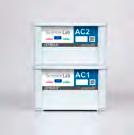



Detailed information on the above

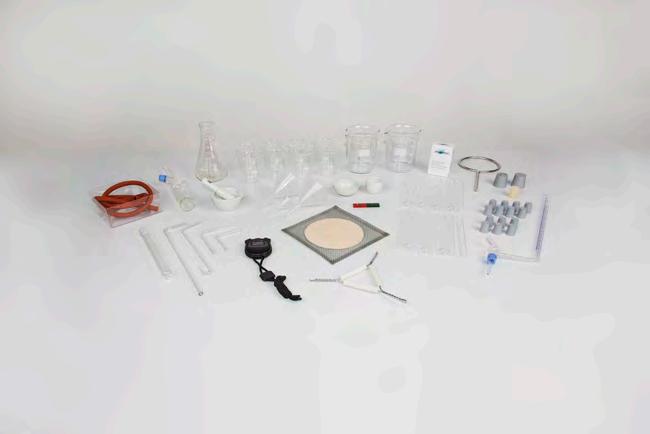
Student experiment set of the student experiment system Science Lab in the field of chemistry. Set-up material for one working group in pre-formed tray. With the equipment set AC, together with the Science Lab Chemistry Basic CB (207 200S), 93 experiments at school, college and university level for worldwide curriculums can be performed. The Science Lab Inorganic Chemistry AC contains two trays. The individual devices are assigned in such a way that the students have a maximum of 2 trays on the table for the experiments. The students deal with the topics general and inorganic chemistry. While working out the curriculum required topics, they are also trained in communication and assessment skills. In combination with the Mobile-CASSY 2 WiFi (524 005W2), there are additional evaluation options which enable the students digital learning.
Scope of delivery:
Count Name
1 Bar magnet
8 Beaker Boro 3.3, 100 ml, squat
2 Tray, high
1 Microscope slides 76 mm x 26 mm x 1 mm, set of 50
1 Crucible porcelain 20 ml
16 Test tube Fiolax 16 mm x 160 mm
1 Test tube Supremax 20 mm x 180 mm
2 Beaker Boro 3.3, 400 ml, squat
1 Pneumatic Tank, Plastic
1 Erlenmeyer flask 250 ml, narrow neck, SB 29
1 Evaporating dish 60 mm Ø
2 Funnel PP 75 mm Ø
1 Dropper funnel, 75 ml, ST 29
1 Gas delivery tube, angled, 8 mm Ø
1 Angled tube 90°, 50/50 mm, 8 mm Ø
1 Angled tube 90°, 300/50 mm, 8 mm Ø
Count Name 1 Glass nozzle 90°, 80 mm x 80 mm, 8 mm Ø 1 Burette filling funnel plastic, 35 mm Ø
1 Burette clear glass, 10 ml, side stopcock
1 Stand ring with stem 100 mm Ø 1 Wire gauze 160 mm x 160 mm 1 Wire triangle with clay sleeves 60 mm 1 Pestle 88 mm 1 Mortar porcelain 70 mm Ø 1 Rubber tubing 7 mm Ø, 1 m
Rubber stopper solid, 14...18 mm Ø
Rubber stopper solid, 25...31 mm Ø 1 Rubber stopper two 7 mm holes, 25...31 mm Ø 1 Silicone stopper, one 7 mm hole, 16...21 mm Ø
Stopwatch, digital

n Easy introduction to digital measurements and evaluation
n Includes the chemicals for at least 10 repetitions of all experiments
n Covers all requirement levels
Additionally required per student
Count Cat.-No. Name Description
1 610 010 Laboratory safety goggles, Focomax
Additionally required per working group
Count Cat.-No. Name
1 207 200S Science Lab Chemistry Basic CB (Set)
1 661 243 Wash bottle PE 500 ml
1 656 017 Teclu burner, universal
1 607 020 Safety gas hose with clamp 0.5 m
Description
1 524 005W2 Mobile-CASSY 2 WiFi for digital experiments
1 529 670 Conductivity sensor
1 524 0671 Conductivity adapter S
1 529 672 pH sensor, BNC
1 524 0672 pH adapter S
1 666 194 Protective sleeves for temperature probe, set of 5
1 ADACB501 Compact scale 500 g : 0.1 g
1 667 609 Safety gloves, nitrile rubber, size 8
1 607 105 Magnetic stirrer mini
1 666 851 Stirring magnet 25 mm x 6 mm Ø, circular
Additionally required per class
Count Cat.-No. Name
1 520 72 LIT-digital: LC Science Lab Chemistry
1 679 210 Chemicals Science Lab Inorganic Chemistry
1 675 3410 Water, pure, 5 l
1 MA91201 Test sticks total water hardness
Description
1 674 4640 Buffer solution pH 4.00, 250 ml pH measurement experiments (LC1.4)
1 674 4670 Buffer solution pH 7.00, 250 ml pH measurement experiments (LC1.4)
1 ADAHCB123 Compact Balance 120 g : 0.001 g Titration experiment (LC1.4.5)
Detailed information on Mobile-CASSY 2 WiFi, sensors, literature packages and chemical


The universal student measuring device with WiFi for all measuring tasks in physics, chemistry and biology.
524 005W2 Mobile-CASSY 2 WiFi
Temperature probe NiCr-Ni, type K
Included with the purchase of the Mobile-CASSY 2 WiFi (524 005W2).
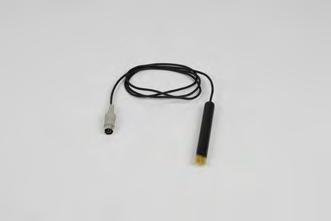



Conductivity sensor using four-wire technology with integrated Pt temperature sensor for use with chemistry box (524 067), conductivity adapter S (524 0671) and CASSY (524 013, 524 006, 524 005W2, 524 018) or the universal chemistry measuring instrument (531 836). Open design for rapid response to changes in conductivity. When conducting measurements a minimum distance of 1 cm from the side of the, as well as a minimum immersion depth of 2 cm are to be maintained.
529 670 Conductivity sensor
Used in conjunction with the conductivity sensor (529 670), this adapter enables conductivity and temperature to be measured with CASSY (524 013, 524 006, 524 005W2, 524 018) or the universal chemistry measuring instrument (531 836).
524 0671 Conductivity adapter S
pH glass electrode in plastic shaft and BNC plug for use with the chemistry box (524 067), pH adapter S (524 0672) and CASSY (524 013, 524 006, 524 005W2, 524 018) or the universal chemistry measuring instrument (531 836). Low-maintenance pH electrode with solid electrolyte made of a conductive gel-like polymer.
529 672 pH sensor, BNC
For storage 3 M Potassium chloride sol. is recommended (672 5250).
Enables a pH electrode to be connected to CASSY (524 013, 524 006, 524 005W2, 524 018) or the universal chemistry measuring instrument (531 836). Moreover, the voltage at the BNC socket can be measured at a very high resistance, e.g. for measuring electrochemical potentials.
524 0672 pH adapter S

Chemicals for carrying out student experiments in Science Lab Inorganic Chemistry. The chemical set contains 87 different chemicals which can be used to perform every experiment at least 10 times.
679 210 Chemicals Science Lab Inorganic Chemistry
The individual chemicals from this set can be found on the Internet at www.leybold-shop.com.
There you will also learn more about the corresponding hazard symbols and classes, the safe handling of chemicals and the hazard and safety instructions.
Here you will find an overview of our literature packages. You can find detailed information on our literature on the internet at www.leybold-shop.com.


Detailed experiment instructions relating to Science Lab Set AC (207 211S) and Science Lab Set Chemistry Basic CB (207 200S). Describes 93 experiments from the field of general and inorganic chemistry.
Topics:
General methods & separation methods; Water; Air, gases and their properties; Acidic and alkaline solutions; Salts; Metals; Redox reactions; Chemical reactions, New fields of chemistry
520 7211EN LIT-print: LC1 Inorganic and general chemistry
Comprehensive chemistry experiment instructions for the Science Lab. Contains more than 270 experiments in the fields of inorganic chemistry, organic chemistry, physical chemistry, technical chemistry and biochemistry and fuel cell.
Includes all interactive experiment instructions (Lab Docs) as html file.
520 72 LIT-digital: LC Science Lab Chemistry
Technical data of the digital version:
• Product key for literature (activation & selection of one literature language in LeyLab)
• Can then be used in LeyLab and Document Center (school/institute licence)
• System requirements: Document Center:
- PC with Windows 7 or higher; internet access during installation; local network for distribution to students LeyLab:
- PC, tablet or smartphone with a current browser; internet access





The Science Lab Set Organic Chemistry is the optimal collection of devices for teaching all topics relevant to organic chemistry.
Take advantage of the intelligent set-up system: Instead of using ground joint instruments, your students can implement complex set-ups themselves simply with GL screw joints. Thereby you can successfully conduct the experiment in just one class/lecture. This provides a large variety, from basic experiments on the properties of organic substances to insights into the petrochemical industry.

In this experiment, students will prove that organic matter consists of carbon and hydrogen. To do this, urea is heated together with copper oxide as an example of an organic substance. In doing so, the copper oxide reacts to the copper. The escaping gases are detected in a calcium hydroxide solution as CO2 For this experiment you will need the sets Science Lab Chemistry Basic CB (207 200S) and Science Lab Organic Chemistry OC (207 221S)
LC2.1 ORGANIC
LC2.2 HYDROCARBONS
LC2.3 ALCOHOLS, ALDEHYDES AND KETONES
LC2.4 CARBOXYLIC ACIDS AND ESTERS
LC2.5 REACTIONS IN ORGANIC CHEMISTRY
LC2.6 METHODS OF ORGANIC CHEMISTRY



Distillation is a classic chemical process. In this experiment, pure alcohol is isolated from wine through distillation. For this experiment you will need the sets Science Lab Chemistry Basic CB (207 200S) and Science Lab Organic Chemistry OC (207 221S)
Further information about our curriculum-compliant topics and student experiments as well as the corresponding sets can be found on the following pages.
Sensors
LC2.1 ORGANIC SUBSTANCES
LC2.1.1 Characteristics of organic substances
LC2.1.1.1
LC2.1.1.2 Characteristics of organic substances Combustion gas of organic substances
LC2.1.2 Elements in organic substances
LC2.1.2.1
LC2.1.2.2 Detection of hydrogen and carbon Detection of oxygen
LC2.2 HYDROCARBONS
LC2.2.1 Saturated hydrocarbons
LC2.2.1.1
LC2.2.1.2
LC2.2.1.3
LC2.2.1.4
Dry distillation of coal
Properties of propane
Properties of some alkanes
The melting point of paraffin
LC2.2.2 Unsaturated hydrocarbons
LC2.2.2.1
LC2.2.2.2 Detection of multiple bonds Properties of ethyne
LC2.2.3 Petrochemistry
LC2.2.3.1
LC2.2.3.2
LC2.2.3.3
LC2.2.3.4
LC2.2.3.5
LC2.2.3.5C
Properties of some crude oil fractions
Petrol as a solvent
Catalytic cracking
Analysis of crack products
Production of biodiesel
Production of biodiesel (with Mobile-CASSY 2 WiFi)
LC2.3.1 Production of alcohols
LC2.3.1.1
LC2.3.1.2
LC2.3.1.3
LC2.3.1.3C
Production of “wood alcohol”
Alcoholic fermentation
Distillation of wine
Distillation of wine (with Mobile-CASSY 2 WiFi)
LC2.3.2 Detection of alcohols
LC2.3.2.1
LC2.3.2.2
LC2.3.2.3
Differentiation of methanol and ethanol Iodoform test
Detection of multivalent alkanols
LC2.3.3 Properties and uses of alcohols
LC2.3.3.1
LC2.3.3.2
LC2.3.3.3
LC2.3.3.4
LC2.3.3.4C
LC2.3.3.5
Ethanol as a solvent
Flammability of an ethanol-water mixture
Water-solubility of different alkanols
Isomeric alkanols and their boiling points
Isomeric alkanols and their boiling points
(with Mobile-CASSY 2 WiFi)
Oxidation of alcohols
LC2.3.4 Aldehydes
LC2.3.4.1
LC2.3.4.2 The Tollens reaction
Synthesis and detection of ethanal
LC2.3.5 Ketones
LC2.3.5.1
LC2.3.5.2
Synthesis of alkanons Properties and uses of acetone
LC2.4 CARBOXYLIC ACIDS AND ESTERS
LC2.4.1 Production of carboxylic acids
LC2.4.1.1
LC2.4.1.2
Synthesis of acetic acid by oxidation
Synthesis of wine vinegar
LC2.4.2 Properties & uses of carboxylic acids
LC2.4.2.1
LC2.4.2.2
LC2.4.2.3
Formic acid as a preservative
Properties of formic acid and acetic acid
Properties and uses of wine vinegar
LC2.4.3 Production and properties of esters
LC2.4.3.1
LC2.4.3.2
LC2.4.3.3
LC2.4.3.4
LC2.4.3.5
LC2.4.3.5C
Esters of acetic acid
Esters of propane acid
Esters of benzoic acid
Ester synthesis as an equilibrium reaction
Alkaline ester hydrolysis
Alkaline ester hydrolysis (with Mobile-CASSY 2 WiFi)
LC2.5 REACTIONS IN ORGANIC CHEMISTRY
LC2.5.1 Addition reactions
LC2.5.1.1
LC2.5.1.2
Electrophilic addition reaction
Nucleophilic addition to the carbonyl group
LC2.5.2 Substitution reactions
LC2.5.2.1
LC2.5.2.2
LC2.5.2.2C
Nucleophilic substitution reaction
Radical substitution reaction
Radical substitution reaction (with Mobile-CASSY 2 WiFi)
LC2.6 METHODS OF ORGANIC CHEMISTRY
LC2.6.1 Distillations
LC2.6.1.1
LC2.6.1.1C
LC2.6.1.2
LC2.6.1.2C
Distillation of cola
Distillation of cola (with Mobile-CASSY 2 WiFi)
Steam distillation for the extraction of fragrances
Steam distillation for the extraction of fragrances (with Mobile-CASSY 2 WiFi)
For experiments marked with „C“, the measurements are carried out digitally with the Mobile-CASSY 2 WiFi.
Conductivity sensor
Conductivity adapter S pH sensor, BNC pH adapter S
EXPERIMENTS








Student experiment set of the student experiment system Science Lab in the field of chemistry. Set-up material for one working group in pre-formed tray. With the equipment set OC, together with the Science Lab Chemistry Basic CB (207 200S), 53 experiments at school, college and university level for worldwide curriculums can be performed.
The students deal with the topics organic chemistry. While working out the curriculum required topics, they are also trained in communication and assessment skills. In combination with the Mobile-CASSY 2 WiFi (524 005W2), there are additional evaluation options which enable the students digital learning.
Scope of delivery:
Count Name
2 Beaker Boro 3.3, 100 ml, squat
1 Syringe 50 ml
1 Luer Combi Stopper red
1 Two-neck round bottom flask Boro 3.3, 100 ml, GL 18
1 Cooling jacket
1 Tray, high
6 Test tube Fiolax 16 mm x 160 mm
1 Test tube Supremax 20 mm x 180 mm
1 Test tube with side arm, Boro 3.3, 20 x 180 mm
1 Copper wire gauze roll 80 x 7.5 mm Ø
2 Beaker Boro 3.3, 400 ml, squat
1 Petri dish, 100 x 20 mm, glass
1 Erlenmeyer flask 250 ml, narrow neck, SB 29
2 Evaporating dish 60 mm Ø
Count Name
1 Gas delivery tube, angled, 8 mm Ø
1 Angled tube 90°, 300/50 mm, 8 mm Ø
1 Glass nozzle 90°, 80 mm x 80 mm, 8 mm Ø
1 Fermentation tube 200 mm x 8 mm Ø
1 Pestle 88 mm
1 Mortar porcelain 70 mm Ø
2 Rubber tubing 7 mm Ø, 1 m
5 Rubber stopper solid, 14...18 mm Ø
1 Rubber stopper, one 7-mm hole, 14...18 mm Ø
1 Rubber stopper, one 7-mm hole, 16...21 mm Ø
1 Rubber stopper, one 7-mm hole, 25...31 mm Ø
1 Silicone stopper, one 7-mm hole, 16...21 mm Ø
1 Screw cap GL 18, solid
207 221S Science Lab Organic Chemistry OC (Set)


n GL screw joints instead of ground joints
n Includes chemicals for at least 10 repetitions of all experiments
n Wide range of experiments: basic and advanced level
Additionally required per student
Count Cat.-No.
1 610 010 Laboratory safety goggles, Focomax
Additionally required per working group
Count
1 207 200S Science Lab Chemistry Basic CB (Set)
1 661 243 Wash bottle PE 500 ml
1 656 017 Teclu burner, universal
1 607 020 Safety gas hose with clamp 0.5 m
1 524 005W2 Mobile-CASSY 2 WiFi for digital experiments
1 529 670 Conductivity sensor
1 524 0671 Conductivity adapter S
1 529 672 pH sensor, BNC
1 524 0672 pH adapter S
1 666 194 Protective sleeves for temperature probe, set of 5
1 ADACB501 Compact scale 500 g : 0.1 g
1 667 609 Safety gloves, nitrile rubber, size 8
1 666 839 Magnetic stirrer with hot plate for several experiments
1 666 851 Stirring magnet 25 mm x 6 mm Ø, circular
Additionally required per class
Count Cat.-No. Name
1 520 72 LIT-digital: LC Science Lab Chemistry
1 679 220 Chemicals Science Lab Organic Chemistry
1 675 3410 Water, pure, 5 l
1 674 4640 Buffer solution pH 4.00, 250 ml
1 674 4670 Buffer solution pH 7.00, 250 ml
1 674 9340 Anthracite coal, pieces, 100 g


DIGITAL CLASS / EDUCATION
The universal student measuring device with WiFi for all measuring tasks in physics, chemistry and biology.
524 005W2 Mobile-CASSY 2 WiFi
Detailed information on the Mobile-CASSY 2 WiFi can be found on the Internet at www.leybold-shop.com/524005W2
Temperature probe NiCr-Ni, type K
Included with the purchase of the Mobile-CASSY 2 WiFi (524 005W2).




INCLUDED IN SCOPE OF DELIVERY
Conductivity sensor using four-wire technology with integrated Pt temperature sensor for use with chemistry box (524 067), conductivity adapter S (524 0671) and CASSY (524 013, 524 006, 524 005W2, 524 018) or the universal chemistry measuring instrument (531 836). Open design for rapid response to changes in conductivity. When conducting measurements a minimum distance of 1 cm from the side of the, as well as a minimum immersion depth of 2 cm are to be maintained.
529 670 Conductivity sensor
Used in conjunction with the conductivity sensor (529 670), this adapter enables conductivity and temperature to be measured with CASSY (524 013, 524 006, 524 005W2, 524 018) or the universal chemistry measuring instrument (531 836).
524 0671 Conductivity adapter S
pH glass electrode in plastic shaft and BNC plug for use with the chemistry box (524 067), pH adapter S (524 0672) and CASSY (524 013, 524 006, 524 005W2, 524 018) or the universal chemistry measuring instrument (531 836). Low-maintenance pH electrode with solid electrolyte made of a conductive gel-like polymer.
529 672 pH sensor, BNC
For storage 3 M Potassium chloride sol. is recommended (672 5250).
Enables a pH electrode to be connected to CASSY (524 013, 524 006, 524 005W2, 524 018) or the universal chemistry measuring instrument (531 836). Moreover, the voltage at the BNC socket can be measured at a very high resistance, e.g. for measuring electrochemical potentials.
524 0672 pH adapter S
Detailed information on these and other sensors can be found on the Internet at www.leybold-shop.com

Chemicals for carrying out student experiments in Science Lab Organic Chemistry. The chemical set contains 68 different chemicals which can be used to perform every experiment at least 10 times.
679 220 Chemicals Science Lab Organic Chemistry
The individual chemicals from this set can be found on the Internet at www.leybold-shop.com. There you will also learn more about the corresponding hazard symbols and classes, the safe handling of chemicals and the hazard and safety instructions.
Here you will find an overview of our literature packages. You can find detailed information on our literature on the internet at www.leybold-shop.com.


Detailed experiment instructions relating to Science Lab Set OC (207 221S) and Science Lab Set Chemistry Basic CB (207 200S). Describes 53 experiments from the field of organic chemistry.
Topics:
Organic substances; Hydrocarbons; Alcohols, aldehydes and ketones; Carboxylic acids and esters; Reactions in organic chemistry; Methods of organic chemistry
520 7221EN LIT-print: LC2 Organic chemistry
Comprehensive chemistry experiment instructions for the Science Lab. Contains more than 270 experiments in the fields of inorganic chemistry, organic chemistry, physical chemistry, technical chemistry and biochemistry and fuel cell.
Includes all interactive experiment instructions (Lab Docs) as html file.
520 72 LIT-digital: LC Science Lab Chemistry
Technical data of the digital version:
• Product key for literature (activation & selection of one literature language in LeyLab)
• Can then be used in LeyLab and Document Center (school/institute licence)
• System requirements: Document Center:
- PC with Windows 7 or higher; internet access during installation; local network for distribution to students LeyLab:
- PC, tablet or smartphone with a current browser; internet access





With the Science Lab Set Physical Chemistry, you will inspire your students with basic, chemistry-related phenomena. With this selection of experiments students do not only gain a deep understanding of electrochemistry, but also of basic concepts such as reaction rate, the energy of chemical reactions or equilibrium concentrations.
Our long established devices, such as our cell batteries for the construction of electrochemical elements, can still be used hereby alongside with our Mobile-CASSY 2 WiFi with its state-of-the-art measuring technology.
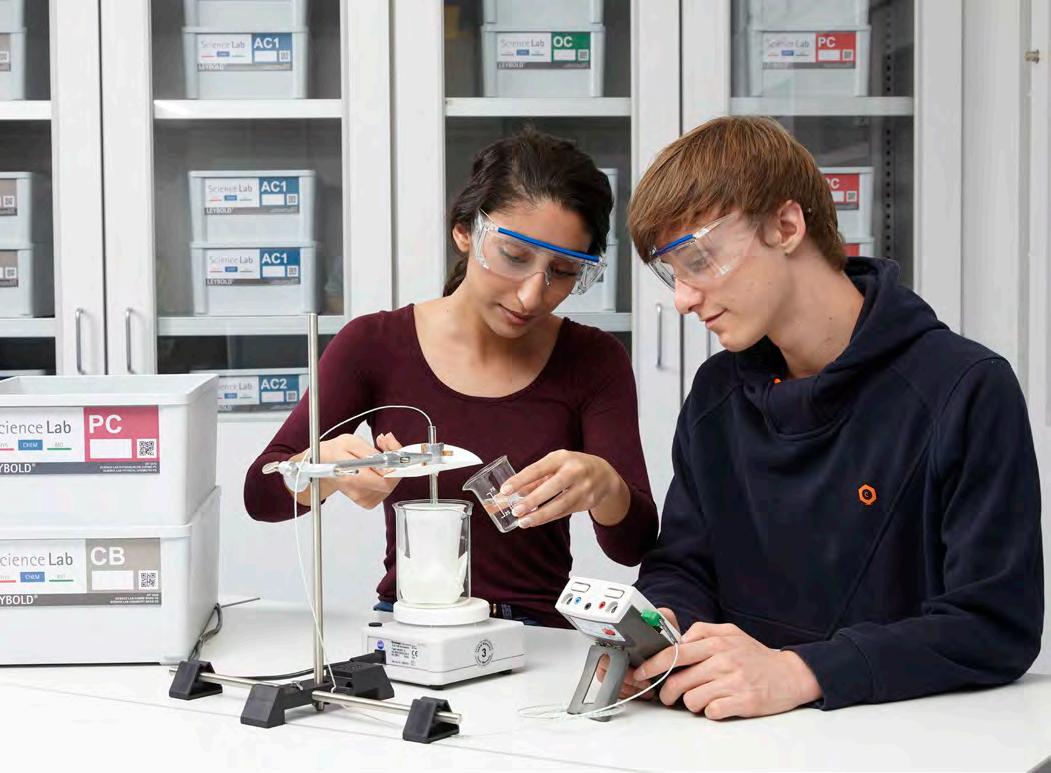
In this experiment, the students will build a simple calorimeter and use a water mixture to calculate the thermal capacity of their calorimeter. This forms a foundation for later calorimetry experiments. For this experiment you will need the sets Science Lab Chemistry Basic CB (207 200S) and Science Lab Physical Chemistry PC (207 231S).
Further information about our curriculum-compliant topics and student experiments as well as the corresponding sets can be found on the following pages.
LC3.2 PHYSICAL PROCESSES
LC3.3 ENERGY IN CHEMICAL REACTIONS
LC3.4 RATE OF REACTION
LC3.5 CHEMICAL EQUILIBRIUM

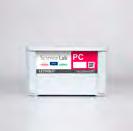

For this experiment, students will construct a zinc iodide battery and charge it using electrolysis in the first part of the experiment. This process is especially easy to observe, as iodine is formed in one half cell and zinc is deposited on the carbon electrode in the other half cell. Then, the battery discharge is examined by measuring the cell voltage and the short-circuit current with the Mobile-CASSY 2 WiFi. For this experiment you will need the sets Science Lab Chemistry Basic CB (207 200S) and Science Lab Physical Chemistry PC (207 231S).
Sensors
LC3.1
LC3.1.1 Electrical conductivity
LC3.1.1.1
LC3.1.1.2
LC3.1.1.3
Conductors and non-conductors
The conductivity of liquids and solutions
Ionic migration
LC3.1.2 Electrochemical potentials
LC3.1.2.1
LC3.1.2.2C
LC3.1.2.3C
LC3.1.2.4C
LC3.1.2.5C
LC3.1.2.6C
LC3.1.2.7C
LC3.1.2.8C
The redox series of metals
Creation of an electrochemical series (with Mobile-CASSY 2 WiFi)
Expansion of an electrochemical series (with Mobile-CASSY 2 WiFi)
The standard potentials of metals (with Mobile-CASSY 2 WiFi)
The standard potentials of non-metals (with Mobile-CASSY 2 WiFi)
The NERNST equation part I - Fundamentals (with Mobile-CASSY 2 WiFi)
The NERNST equation part II - Structure (with Mobile-CASSY 2 WiFi)
Influences on the voltage of concentration cells (with Mobile-CASSY 2 WiFi)
LC3.1.3 Galvanic elements
LC3.1.3.1C
LC3.1.3.2C
LC3.1.3.3C
LC3.1.3.4C
LC3.1.3.5C
The Voltaic element (with Mobile-CASSY 2 WiFi)
The DANIELL element (with Mobile-CASSY 2 WiFi)
The DANIELL element (series connection) (with Mobile-CASSY 2 WiFi)
The zinc iodide battery (with Mobile-CASSY 2 WiFi)
The functionality of a fuel cell (with Mobile-CASSY 2 WiFi)
LC3.1.4 Applied electrochemistry
LC3.1.4.1
LC3.1.4.2
LC3.1.4.3C
LC3.1.4.4
LC3.1.4.5
LC3.1.4.6C
LC3.1.4.7C
LC3.1.4.8C
The corrosion of iron
Corrosion protection of iron
Galvanisation (with Mobile-CASSY 2 WiFi)
Electrolytic refining of copper
Anodic oxidation
The solubility product (with Mobile-CASSY 2 WiFi)
The dissociation constant (with Mobile-CASSY 2 WiFi)
The silver/silver chloride electrode (with Mobile-CASSY 2 WiFi)
LC3.1.5 Electrolysis
LC3.1.5.1
LC3.1.5.2
LC3.1.5.3C
LC3.1.5.4C
LC3.1.5.5C Electrolysis of water Electrolysis of metal halide solutions
Faraday’s first law with the electrolyser (with Mobile-CASSY 2 WiFi)
Faraday’s second law with the electrolyser (with Mobile-CASSY 2 WiFi)
Determination of the Faraday efficiency of an electrolyser (with Mobile-CASSY 2 WiFi)
LC3.2 PHYSICAL PROCESSES
LC3.2.1 Particle movement
LC3.2.1.1 Diffusion
LC3.3 ENERGY IN CHEMICAL REACTIONS
LC3.3.1 Calorimetry
LC3.3.1.1C
LC3.3.1.2C
LC3.3.1.3C
LC3.3.1.4C
The water equivalent of a calorimeter (with Mobile-CASSY 2 WiFi)
Neutralisation enthalpy (with Mobile-CASSY 2 WiFi)
Solution enthalpy of salts (with Mobile-CASSY 2 WiFi)
Reaction enthalpy of a redox reaction (with Mobile-CASSY 2 WiFi)
LC3.3.2 Reaction heat
LC3.3.2.1C
LC3.3.2.2C
LC3.3.2.3C
LC3.3.2.4C
The exothermic reaction (with Mobile-CASSY 2 WiFi)
The endothermic reaction (with Mobile-CASSY 2 WiFi)
Hess’s law (with Mobile-CASSY 2 WiFi)
A spontaneous endothermic reaction (with Mobile-CASSY 2 WiFi)
LC3.4 RATE OF REACTION
LC3.4.1 Course of a reaction
LC3.4.1.1C
LC3.4.1.2
Hydrolysis of esters (with Mobile-CASSY 2 WiFi)
Activation energy
LC3.4.2 Influencing the rate of reaction
LC3.4.2.1
LC3.4.2.2
LC3.4.2.3
LC3.4.2.4
LC3.4.2.5
LC3.4.2.6
LC3.5
Temperature dependence
Concentration dependence
Degree of fragmentation
A catalytic reaction
Inorganic and organic catalysts
Analysis of enzyme activity
LC3.5.1 Chemical equilibrium
LC3.5.1.1
LC3.5.1.2 Chemical equilibrium Ligand exchange with copper complexes
LC3.5.2 Le Chatelier‘s principle
LC3.5.2.1C
LC3.5.2.2
LC3.5.2.3
Influence of a change in temperature (with Mobile-CASSY 2 WiFi)
Influence of a change in concentration
Influence of a change in pressure
LC3.5.3 The law of mass action and its applications
LC3.5.3.1
LC3.5.3.2C
LC3.5.3.3
LC3.5.3.4C
Law of mass action
Determination of the equilibrium constant (with Mobile-CASSY 2 WiFi)
The solubility product
The dissociation constant (with Mobile-CASSY 2 WiFi)
For experiments marked with „C“, the measurements are carried out digitally with the Mobile-CASSY 2 WiFi.
Conductivity sensor
Conductivity adapter S pH sensor, BNC pH adapter S
Electrochemistry box M
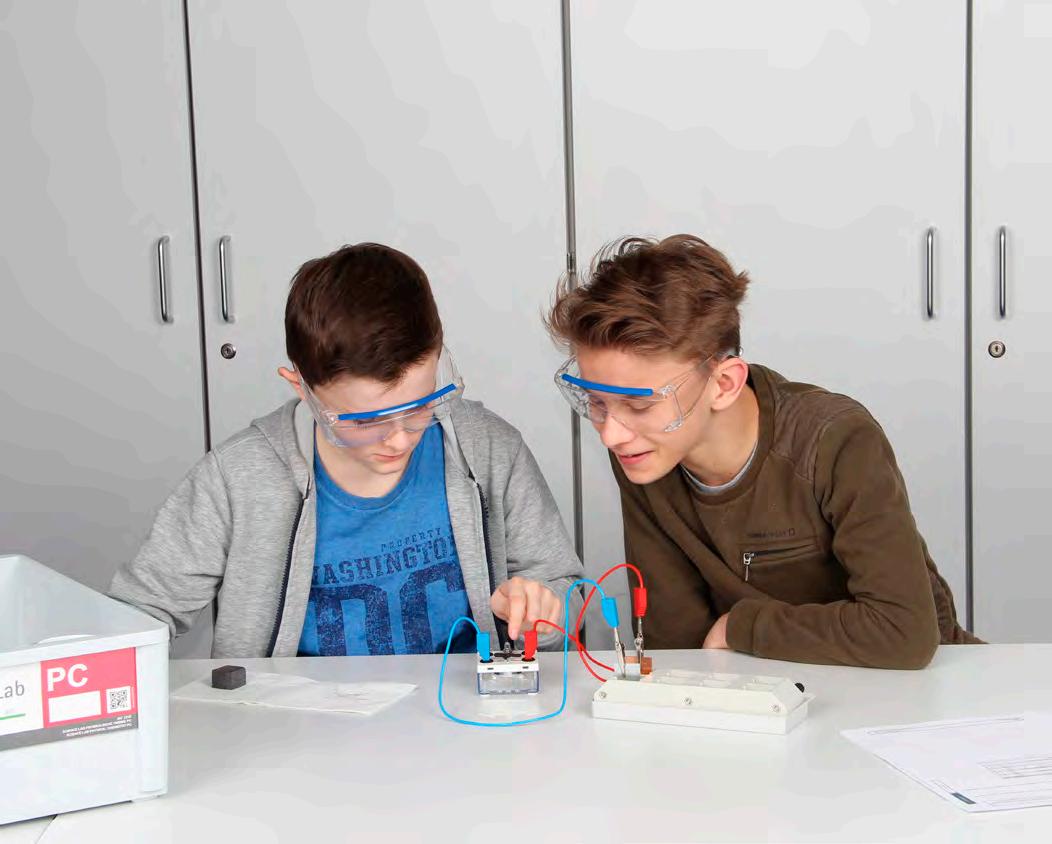







Student experiment set of the student experiment system Science Lab in the field of chemistry. Set-up material for one working group in pre-formed tray. With the equipment set PC, together with the Science Lab Chemistry Basic CB (207 200S), 55 experiments at school, college and university level for worldwide curriculums can be performed. The students deal with the topics physical chemistry and electrochemistry. While working out the curriculum required topics, they are also trained in communication and assessment skills. In combination with the Mobile-CASSY 2 WiFi (524 005W2), there are additional evaluation options which enable the students digital learning.
Scope of delivery:
Count Name
2 Connecting lead 19 A, 50 cm, red/blue, pair
6 Crocodile clip, polished
4 Beaker Boro 3.3, 100 ml, squat
1 Syringe 50 ml
1 Luer Combi Stopper red
4 Plastic cup
1 Tray, high
5 Test tube Fiolax 16 mm x 160 mm
2 Beaker Boro 3.3, 400 ml, squat
2 Petri dish, 100 x 20 mm, glass
1 Plastic plate for magnesium electrode
4 Plate electrode copper 43 x 28 mm
2 Plate electrode zinc 43 x 28 mm Count Name
Plate electrode iron 43 x 28 mm 3 Plate electrode carbon 43 x 28 mm
Plate electrode silver 43 x 28 mm
Mesh electrode platinum 43 x 28 mm
Grindstone 1 Spare Diaphragms, 100 sheets 1 Angled tube 90°, 250/50 mm, 8 mm Ø
Electrical loads Electrochemistry
Cell batteries, pair
Stopwatch, digital


n Electrochemistry with the reliable cell battery: low amounts of chemicals needed and simultaneous measurements in the separate compartments possible
n Digital measurements (temperature, voltage, current, conductivity)
n Experiments with the multifunctional electrochemistry box M, no separate power supply required
n Quantitative experiments for advanced chemistry lessons/classes
n Includes enough chemicals for at least 10 repetitions of all experiments
Additionally required per student
Count Cat.-No. Name
1 610 010 Laboratory safety goggles, Focomax
Additionally required per working group
Description
Count Cat.-No. Name Description
1 207 200S Science Lab Chemistry Basic CB (Set)
1 661 243 Wash bottle PE 500 ml
1 656 017 Teclu burner, universal
1 607 020 Safety gas hose with clamp 0.5 m
1 524 005W2 Mobile-CASSY 2 WiFi for digital experiments
1 529 670 Conductivity sensor
1 524 0671 Conductivity adapter S
1 529 672 pH sensor, BNC
1 524 0672 pH adapter S
1 524 450 Electrochemistry box M
1 666 194 Protective sleeves for temperature probe, set of 5
1 ADACB501 Compact scale 500 g : 0.1 g
1 667 609 Safety gloves, nitrile rubber, size 8
1 607 105 Magnetic stirrer mini
1 666 839 Magnetic stirrer with hot plate Le Chatelier‘s principle experiment (LC3.5.2)
1 666 851 Stirring magnet 25 mm x 6 mm Ø, circular
Additionally required per class
Count Cat.-No. Name
1 520 72 LIT-digital: LC Science Lab Chemistry
1 679 230 Chemicals Science Lab Physical Chemistry
1 675 3410 Water, pure, 5 l
1 ADAHCB123 Compact Balance 120 g : 0.001 g
1 674 4640 Buffer solution pH 4.00, 250 ml Le Chatelier‘s principle experiment (LC3.5.2)
1 674 4670 Buffer solution pH 7.00, 250 ml Le Chatelier‘s principle experiment (LC3.5.2)


DIGITAL CLASS / EDUCATION
The universal student measuring device with WiFi for all measuring tasks in physics, chemistry and biology.
524 005W2 Mobile-CASSY 2 WiFi
Detailed information on the Mobile-CASSY 2 WiFi can be found on the Internet at www.leybold-shop.com/524005W2
Temperature probe NiCr-Ni, type K
Included with the purchase of the Mobile-CASSY 2 WiFi (524 005W2).




INCLUDED IN SCOPE OF DELIVERY
Conductivity sensor using four-wire technology with integrated Pt temperature sensor for use with chemistry box (524 067), conductivity adapter S (524 0671) and CASSY (524 013, 524 006, 524 005W2, 524 018) or the universal chemistry measuring instrument (531 836). Open design for rapid response to changes in conductivity. When conducting measurements a minimum distance of 1 cm from the side of the, as well as a minimum immersion depth of 2 cm are to be maintained.
529 670 Conductivity sensor
Used in conjunction with the conductivity sensor (529 670), this adapter enables conductivity and temperature to be measured with CASSY (524 013, 524 006, 524 005W2, 524 018) or the universal chemistry measuring instrument (531 836).
524 0671 Conductivity adapter S
pH glass electrode in plastic shaft and BNC plug for use with the chemistry box (524 067), pH adapter S (524 0672) and CASSY (524 013, 524 006, 524 005W2, 524 018) or the universal chemistry measuring instrument (531 836). Low-maintenance pH electrode with solid electrolyte made of a conductive gel-like polymer.
529 672 pH sensor, BNC
For storage 3 M Potassium chloride sol. is recommended (672 5250).
Enables a pH electrode to be connected to CASSY (524 013, 524 006, 524 005W2, 524 018) or the universal chemistry measuring instrument (531 836). Moreover, the voltage at the BNC socket can be measured at a very high resistance, e.g. for measuring electrochemical potentials.
524 0672 pH adapter S
Detailed information on these and other sensors can be found on the Internet at www.leybold-shop.com


Mobile power supply for experiments as well as voltage and current measuring device in conjunction with Mobile-CASSY 2 WiFi (524 005W2). For power supply up to 300 mA as well as the intuitive, parallel measurement of voltage up to ±20 V and current up to ±2 A.
524 450 Electrochemistry box M
Detailed information on this and other sensors can be found on the Internet at www.leybold-shop.com
Chemicals for carrying out student experiments in Science Lab topic Physical Chemistry and Electrochemistry. The chemical set contains 57 different chemicals which can be used to perform every experiment at least 10 times.
679 230 Chemicals Science Lab Physical Chemistry
The individual chemicals from this set can be found on the Internet at www.leybold-shop.com. There you will also learn more about the corresponding hazard symbols and classes, the safe handling of chemicals and the hazard and safety instructions.
Here you will find an overview of our literature packages. You can find detailed information on our literature on the internet at www.leybold-shop.com.


Detailed experiment instructions relating to Science Lab Set PC (207 231S) and Science Lab Set Chemistry Basic CB (207 200S). Describes 55 experiments from the field of physical chemistry.
Topics:
Electrochemistry; Physical processes; Energy in chemical reactions; Rate of reaction; Chemical equilibrium
520 7231EN LIT-print: LC3 Physical chemistry
Comprehensive chemistry experiment instructions for the Science Lab. Contains more than 270 experiments in the fields of inorganic chemistry, organic chemistry, physical chemistry, technical chemistry and biochemistry and fuel cell. Includes all interactive experiment instructions (Lab Docs) as html file.
520 72 LIT-digital: LC Science Lab Chemistry
Technical data of the digital version:
• Product key for literature (activation & selection of one literature language in LeyLab)
• Can then be used in LeyLab and Document Center (school/institute licence)
• System requirements:
Document Center:
- PC with Windows 7 or higher; internet access during installation; local network for distribution to students LeyLab:
- PC, tablet or smartphone with a current browser; internet access





With the experiments from the Science Lab Set Technical Chemistry, your students can apply their basic knowledge to their everyday lives. For example, they can apply the principles of chemical equilibrium to the topic of lime and gypsum, or they can use the fundamentals of organic chemistry when it comes to dyes. The topics of metals, plastics and soaps also have relevance to everyday life.
Biochemistry, as an interdisciplinary subject between chemistry and biology, is a captivating topic for many students. With the Science Lab Set Technical Chemistry and Biochemistry, you will look at fats, carbohydrates and proteins as well as their properties and applicable chemical detection reactions. Additionally, you can perform experiments on the chemistry of food and therefore practice applying chemical knowledge to everyday topics.
The Technical Chemistry and Biochemistry Set contains experiments in T echnical Chemistry and Biochemistry that can be individually selected.
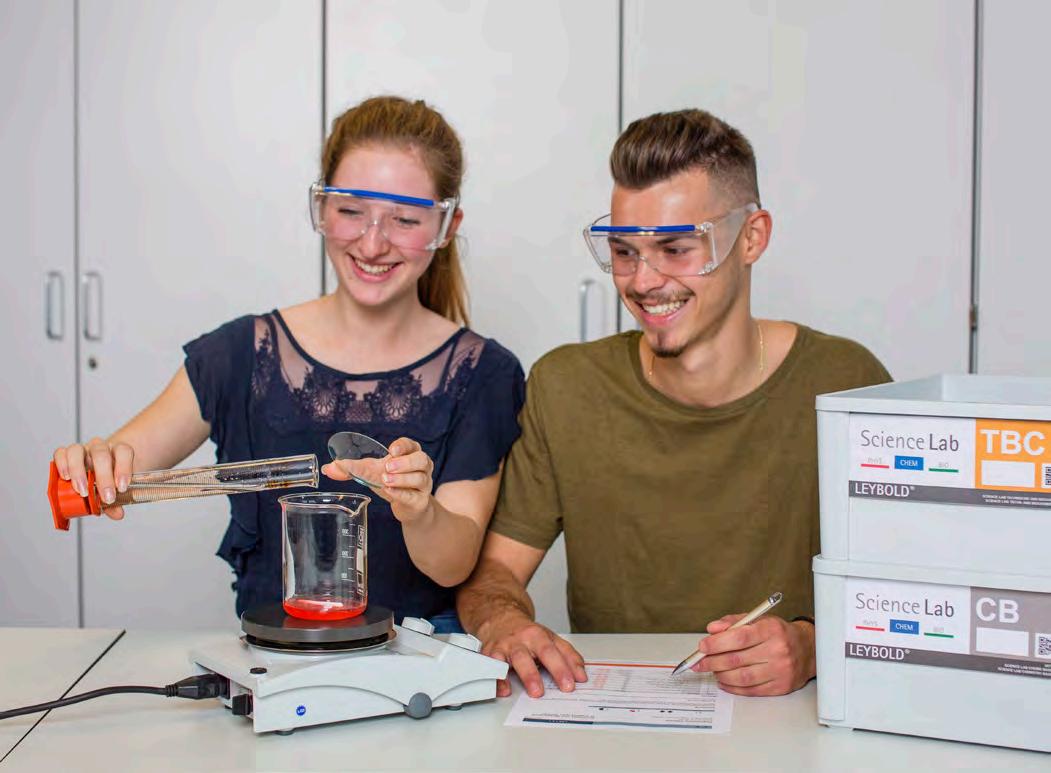
Plasticisers can change the properties of a plastic. In this experiment, two sheets of starch are prepared, one with added glycerine as plasticiser. Both sheets are compared with each other. For this experiment you will need the sets Science Lab Chemistry Basic CB (207 200S) and Science Lab Technical Chemistry and Biochemistry TBC (207 241S)
EXPERIMENT TOPICS
LC4.1 BUILDING MATERIALS
LC4.2 GLASS
LC4.3 METALS
LC4.4 CHEMICAL APPLICATIONS
LC4.5 PRODUCTS OF THE ORGANIC INDUSTRY
EXPERIMENT TOPICS BIOCHEMISTRY
LC5.1 FATS
LC5.2 CARBOHYDRATES
LC5.3 AMINO ACIDS AND PROTEINS
LC5.4 FOOD



Fats are always mixtures of several triglycerides. The melting point or melting range gives information about the composition of a fat. For this experiment you will need the sets Science Lab Chemistry Basic CB (207 200S) and Science Lab Technical Chemistry and Biochemistry TBC (207 241S)
Further information about our curriculum-compliant topics and student experiments as well as the corresponding sets can be found on the following pages.
LC4.1 BUILDING MATERIAL
LC4.1.1 Limestone and gypsum
LC4.1.1.1
LC4.1.1.2
LC4.1.1.3
LC4.1.1.4
LC4.1.1.4C
Calcination of limestone Slaking of limestone Setting of limestone Setting of gypsum Setting of gypsum (with Mobile-CASSY 2 WiFi)
LC4.2 GLASS
LC4.2.1 Glass
LC4.2.1.1 Production of soda-lime glass
LC4.3 METALS
LC4.3.1 Extraction of metals
LC4.3.1.1 The smelting of oxidic ores
LC4.3.2 Alloys
LC4.3.2.1
LC4.3.2.2 Production of bronze Production of brass
LC4.4 CHEMICAL APPLICATIONS
LC4.4.1 Fertilisers
LC4.4.1.1 Production of ammonium sulphate
LC4.4.2 Photography
LC4.4.2.1 The photochemical reaction
LC4.5
LC4.5.1 Pigments and dyestuffs
LC4.5.1.1
LC4.5.1.2
LC4.5.1.3
LC4.5.1.4
LC4.5.1.5
Molecular structure and colour Synthesis of orange II Extraction of food colourings Synthesis of indigo and vat dyeing The phenomenon of fluorescence
LC4.5.2 Plastics
LC4.5.2.1
LC4.5.2.2
LC4.5.2.3
LC4.5.2.4
LC4.5.2.5
The characteristics of different plastics Polycondensation in the production of plastics Influencing the properties of plastics Recycling via pyrolysis Silicons and carbon fibres as modern materials
LC4.5.3 Soaps
LC4.5.3.1
LC4.5.3.2
LC4.5.3.3
Production via alkaline saponification Production using the carbonate process Soap as an emulsifier
For experiments marked with „C“, the measurements are carried out digitally with the Mobile-CASSY 2 WiFi.
LC5.1.1 Properties of fats
LC5.1.1.1
LC5.1.1.2
LC5.1.1.2C
LC5.1.1.3
LC5.1.1.3C
Solubility
Melting and solidification point
Melting and solidification point (with Mobile-CASSY 2 WiFi)
Boiling point
Boiling point (with Mobile-CASSY 2 WiFi)
LC5.1.2 Fatty foods
LC5.1.2.1
LC5.1.2.2
LC5.1.2.2C
CHEMISTRY BIOCHEMISTRY 24 EXPERIMENTS 32 EXPERIMENTS
Rendering animal fats
Extracting vegetable fats
Extracting vegetable fats (with Mobile-CASSY 2 WiFi)
LC5.1.3 Analysing fats
LC5.1.3.1
LC5.1.3.2
LC5.1.3.2C
LC5.2
Detection of fats
Detection of unsaturated fatty acids
Detection of unsaturated fatty acids (with Mobile-CASSY 2 WiFi)
LC5.2.1 Properties of carbohydrates
LC5.2.1.1
LC5.2.1.2
LC5.2.1.2C
Components of carbohydrates
Solubility of carbohydrates
Solubility of carbohydrates (with Mobile-CASSY 2 WiFi)
LC5.2.2 Extraction of sugars
LC5.2.2.1 Isolation and detection of lactose
LC5.2.3 Detection of sugars
LC5.2.3.1
LC5.2.3.3
LC5.2.3.4
LC5.2.3.5
Detection of glucose and fructose Seliwanoff’s test Blue bottle experiment
Components of sucrose
LC5.2.4 Starch and cellulose
LC5.2.4.1
LC5.2.4.2
LC5.2.4.3 Components of starch Starch test Cellulose test
LC5.3 AMINO ACIDS AND PROTEINS
LC5.3.1 Properties of proteins
LC5.3.1.1
LC5.3.1.2
LC5.3.1.3
LC5.3.1.5
Preparing an egg white solution
Properties of proteins The composition of proteins The isoelectric point of amino acids
LC5.3.2 Detection of proteins
LC5.3.2.1
LC5.3.2.2 The Biuret test Detection with test sticks
LC5.4 FOOD
LC5.4.1 Preservatives
LC5.4.1.1
LC5.4.1.2
Detection of vitamin C Preservation with benzoic acid and sorbic acid
LC5.4.2 Additives
LC5.4.2.1
LC5.4.2.2
Extraction of food colourings Composition of baking powder
For experiments marked with „C“, the measurements are carried out digitally with the Mobile-CASSY 2 WiFi.

OVERVIEW







Student experiment set of the student experiment system Science Lab in the field of chemistry. Set-up material for one working group in pre-formed tray. With the equipment set TBC, together with the Science Lab Chemistry Basic CB (207 200S), 56 experiments at school, college and university level for worldwide curriculums can be performed. The students deal with the topics technical chemistry and/or biochemistry. While working out the curriculum required topics, they are also trained in communication and assessment skills. In combination with the Mobile-CASSY 2 WiFi (524 005W2), there are additional evaluation options which enable the students digital learning.
Scope of delivery:
Count Name
3 Beaker Boro 3.3, 100 ml, squat
4 Plastic cup
1 Tray, high
1 Crucible porcelain 20 ml
6 Test tube Fiolax 16 mm x 160 mm
1 Test tube Supremax 20 mm x 180 mm
2 Beaker Boro 3.3, 400 ml, squat
2 Petri dish, 100 x 20 mm, glass
1 Erlenmeyer flask 250 ml, narrow neck, SB 29
1 Grindstone
2 Evaporating dish 60 mm Ø
Count Name
1 Funnel PP 75 mm Ø
1 Angled tube 90°, 300/50 mm, 8 mm Ø
1 Stand ring with stem 100 mm Ø 1 Wire gauze 160 mm x 160 mm 1 Pestle 88 mm 1 Mortar porcelain 70 mm Ø 4 Rubber stopper solid, 14...18 mm Ø 1 Rubber stopper solid, 25...31 mm Ø 1 Silicone stopper, one 7-mm hole, 16...21 mm Ø



n 1 experiment set plus Basic Set provides 24 experiments in technical chemistry and 32 experiments in biochemistry
n Everyday topics also suitable for project work and elective courses
n Includes enough chemicals for at least 10 repetitions of all experiments
Additionally required per student
Count Cat.-No.
1 610 010 Laboratory safety goggles, Focomax
Additionally required per working group
Count Cat.-No.
1 207 200S Science Lab Chemistry Basic CB (Set)
1 656 017 Teclu burner, universal
1 607 020 Safety gas hose with clamp 0.5 m
524
1 666 194 Protective sleeves for temperature probe, set of 5
1 ADACB501 Compact scale 500 g : 0.1 g
1 667 609 Safety gloves, nitrile rubber, size 8
1 666 839 Magnetic stirrer with
1 666 851 Stirring magnet 25 mm x 6 mm Ø, circular
Additionally required per class
Count Cat.-No.
1 520 72 LIT-digital: LC Science Lab Chemistry
1 679 240 Chemicals Science Lab Technical Chemistry
1 679 250 Chemicals Science Lab Biochemistry
1 675 3410 Water, pure, 5 l
1 661 080 Cobalt chloride test paper 2 x 7 cm, 100 strips
1 670 2230 Albustix test sticks, 50 pcs
1 670 9430 Lead(II) acetate paper, 1 package
1 672 1150 Glucose-test stripes, 50 pcs
1 MA91314 Test sticks Ascorbic acid
1 665 6351 Analysis lamp (UV)


Mobile-CASSY 2 WiFi
The universal student measuring device with WiFi for all measuring tasks in physics, chemistry and biology.
524 005W2 Mobile-CASSY 2 WiFi
Detailed information on the Mobile-CASSY 2 WiFi can be found on the Internet at www.leybold-shop.com/524005W2
Temperature probe NiCr-Ni, type K
Included with the purchase of the Mobile-CASSY 2 WiFi (524 005W2).


INCLUDED IN SCOPE OF DELIVERY
With the Mobile-CASSY 2 WiFi, voltage (U), current (I), power (P) and energy (E) can be measured via 4 mm safety sockets.
Chemicals for carrying out student experiments in Science Lab topic Technical Chemistry. The chemical set contains 40 different chemicals which can be used to perform every experiment at least 10 times.
679 240 Chemicals Science Lab Technical Chemistry
Chemicals for carrying out student experiments in Science Lab topic Biochemistry. The chemical set contains 37 different chemicals which can be used to perform every experiment at least 10 times.
679 250 Chemicals Science Lab Biochemistry
The individual chemicals from this set can be found on the Internet at www.leybold-shop.com. There you will also learn more about the corresponding hazard symbols and classes, the safe handling of chemicals and the hazard and safety instructions.
Here you will find an overview of our literature packages. You can find detailed information on our literature on the internet at www.leybold-shop.com.
TOPIC
SUBJECT AREA

Detailed experiment instructions relating to Science Lab Set TBC (207 241S) and Science Lab Set Chemistry Basic CB (207 200S). Describes 24 experiments from the field of technical chemistry.
Topics:
Building material; Glass; Metals; Chemical applications; Products of the organic industry
520 7241EN LIT-print: LC4 Technical Chemistry
Detailed experiment instructions relating to Science Lab Set TBC (207 241S) and Science Lab Set Chemistry Basic CB (207 200S). Describes 32 experiments from the field of biochemistry.
Topics:
Fats; Carbohydrates; Amino acids and proteins; Food
520 7251EN LIT-print: LC5 Biochemistry
SUBJECT

Comprehensive chemistry experiment instructions for the Science Lab. Contains more than 270 experiments in the fields of inorganic chemistry, organic chemistry, physical chemistry, technical chemistry and biochemistry and fuel cell.
Includes all interactive experiment instructions (Lab Docs) as html file.
520 72 LIT-digital: LC Science Lab Chemistry
Technical data of the digital version:
• Product key for literature (activation & selection of one literature language in LeyLab)
• Can then be used in LeyLab and Document Center (school/institute licence)
• System requirements:
Document Center:
-PC with Windows 7 or higher; internet access during installation; local network for distribution to students LeyLab:
-PC, tablet or smartphone with a current browser; internet access





The topic of renewable energies is more topical than ever before. With our set Science Lab Fuel Cell, the students deal with the function and use of the fuel cell. They also deal with the electrolytic production of hydrogen and the associated use of solar energy. By using the consumer, they experience the effect of the generated electricity in a qualitative and very vivid way. Together with the Mobile-CASSY 2 WiFi and the Electrochemistry Box M, the experiments can also be evaluated quantitatively, for example to calculate efficiency. With the set Science Lab Fuel Cell, your students will be able to follow the current discourse on fuel cell technology and discuss advantages and disadvantages.

In this experiment, the students investigate the basic functioning of a reversible fuel cell. This is first operated as an electrolyser and the hydrogen produced is then used as fuel for the fuel cell to operate a propeller motor. The voltage is measured and the hydrogen consumption is examined. For this experiment you will need the set Science Lab Chemistry Fuel Cell BZ (207 261S)
LC6.1.1 THE REVERSIBLE FUEL CELL 13 PAGE 186
LC6.1.2 THE ELECTROLYSER
LC6.1.3 THE FUEL CELL
LC6.1.4 THE SOLAR MODULE


LC6.1.2.2C Faraday‘s first law of electrolysis on the electrolyser
In this experiment, the students use a reversible PEM fuel cell to investigate the relationship between the quantity of hydrogen deposited, the electrolysis time and the current intensity. From this, the first Faraday law is derived. For this experiment you will need the set Science Lab Chemistry Fuel Cell BZ (207 261S)
For more information on our curriculum-compliant topics and student experiments, as well as the corresponding sets, please see the following pages.
Sensors
LC6.1 FUEL CELL
LC6.1.1 The reversible fuel cell
LB6.1.1.1C Handling of a reversible fuel cell (with Mobile-CASSY 2 WiFi)
LC6.1.2 The electrolyser
LB6.1.2.1C
LB6.1.2.2C
LB6.1.2.3C
LB6.1.2.4C
LB6.1.2.5C
Operating an electrolyser (with Mobile-CASSY 2 WiFi)
Faraday‘s first law of electrolysis on the electrolyser (with Mobile-CASSY 2 WiFi)
Faraday‘s second law of electrolysis on the electrolyser (with Mobile-CASSY 2 WiFi)
Determining the Faraday efficiency of the electrolyser (with Mobile-CASSY 2 WiFi)
Determining the energy efficiency of the electrolyser (with Mobile-CASSY 2 WiFi)
LC6.1.3 The fuel cell
LB6.1.3.1C
LB6.1.3.2C
LB6.1.3.3C
Operating the fuel cell (with Mobile-CASSY 2 WiFi)
The efficiency of a fuel cell (with Mobile-CASSY 2 WiFi)
Series and parallel connection of two fuel cells (with Mobile-CASSY 2 WiFi)
LC6.1.4 The solar module
LB6.1.4.1C
LB6.1.4.2C
LB6.1.4.3C
LB6.1.4.4C
Characteristics of the solar module (with Mobile-CASSY 2 WiFi)
The solar module at different luminous intensities (with Mobile-CASSY 2 WiFi)
The solar module at different angles of incidence (with Mobile-CASSY 2 WiFi)
The solar module as a diode (with Mobile-CASSY 2 WiFi)
Electrochemistry box M

LC6.1.4.2C The solar module at different luminous intensities
In this experiment, the students investigate the connection between the short-circuit current and the illuminance on a solar module. For this experiment you will need the set Science Lab Chemistry Fuel Cell BZ (207 261S)




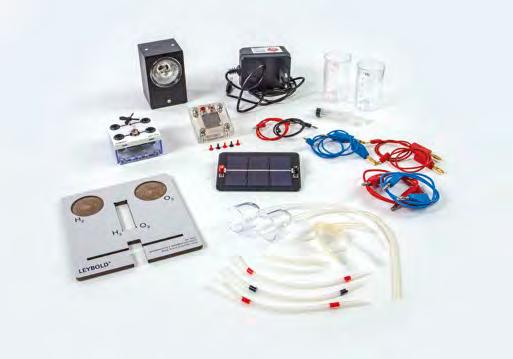
Student experiment set of the student experiment system Science Lab in the field of chemistry. Set-up material for one working group in device-shaped storage. With the BZ equipment set, students can carry out experiments in the field of solar energy and fuel cell technology in S II.
The students deal with the use of solar energy to generate electricity, with the storage of energy in the form of hydrogen gas and with its use by a fuel cell. While working on the curriculum-required topics, they are also taught the competences of communication and assessment. In combination with the Mobile-CASSY 2 WiFi (524 005W2), there are additional evaluation options that enable digital learning.
Scope of delivery: Count Cat.-No.
1
1
1 457 330 Solar module 1.5 V/420 mA
1 500 421 Connecting lead 19 A, 50 cm, red
1 500 422 Connecting lead 19 A, 50 cm, blue
1 out of 505 08 Bulbs, 12 V/3 W, E10, set of 10
1 562 791 Power supply unit (mains adaptor), 12 V AC
1 571 247 Signal cable with 2-mm plugs, 30 cm
1 571 248 Signal cable with 2-mm plugs, 30 cm
Additionally
Additionally required per working group
1 311 78 Tape measure 2 m / 1 mm
1 500 422 Connecting lead 19 A, 50 cm, blue
1

n Equipment tray for 13 experiments
n With the Electrochemistry box M no separate current and voltage source is necessary
n The reversible fuel cell can be used as a fuel cell and electrolyser
n The electrolyser produces the required hydrogen; no separate hydrogen source necessary

SENSORS

SENSORS

The universal student measuring device with WiFi for all measuring tasks in physics, chemistry and biology.
524 005W2 Mobile-CASSY 2 WiFi
You can find detailed information on the Mobile-CASSY 2 WiFi on the Internet at www.leybold-shop.com/524005W2.
Temperature probe NiCr-Ni, type K
Included with the purchase of the Mobile-CASSY 2 WiFi (524 005W2).
Electrochemistry box M
Mobile power supply for experiments as well as voltage and current measuring device in conjunction with Mobile-CASSY 2 WiFi (524 005W2). For power supply up to 300 mA as well as the intuitive, parallel measurement of voltage up to ±20 V and current up to ±2 A.
524 450 Electrochemistry box M
Detailed information on this and other sensors can be found on the Internet at www.leybold-shop.com.
Here you will find an overview of our literature packages. You can find detailed information on our literature on the internet at www.leybold-shop.com.


Detailed experiment instructions relating to Science Lab set Fuel Cell BZ (207 261S). Describes 13 experiments from the field of fuel cell, electrolysis, and solar cells.
Topics:
The reversible fuel cell; the electrolyser; the fuel cell; the solar module
520 7261EN LIT-print: LC6.1 Fuel cell
Comprehensive chemistry experiment instructions for the Science Lab. Contains more than 270 experiments in the fields of anorganic chemistry, organic chemistry, physical chemistry, technical chemistry and biochemistry and fuel cell.
Includes all interactive experiment instructions (Lab Docs) as html file.
520 72 LIT:-digital: LB Science Lab Chemistry
Technical data of the digital version:
• Product key for German or English literature (activation and selection of the literature language via https://register.leylab.de necessary)
• System requirements: Document Center:
- PC with Windows 7 or higher
- Internet access during installation
- Local network for distribution to students Leylab:
- PC, tablet or smartphone with a curent browser
- Internet access






A Fuel cell is a device that converts the chemical energy of a fuel into Electric load. The term „fuel cell“ often refers to the hydrogen-oxygen fuel cell, in which hydrogen reacts with oxygen to form water and the reaction energy released is made usable.
The fuel must be continuously supplied to the Fuel cell, so that it is not an energy source.

Understanding these aspects of fuel cells is more important than ever before in order to understand the opportunities and limitations of fuel cell technology in the energy mix of the present and future. Fuel cells are used today, for example, in domestic energy supply, in low-emission industrial trucks or in cars and buses.

The fuel cell also plays a role in the current discussion on renewable energies because hydrogen can be obtained from Pulley by electrolysis using solar energy as the energy supplier for the process. Moreover, the reaction produces only water as a reaction product and no environmentally hazardous waste products, as is the case, for example, with the combustion of fossil fuels.
A special feature of fuel cells is the reversible fuel cell. It is able to reverse the process of electricity generation and produce the water and oxygen needed for the combustion process by electrolysis of water.

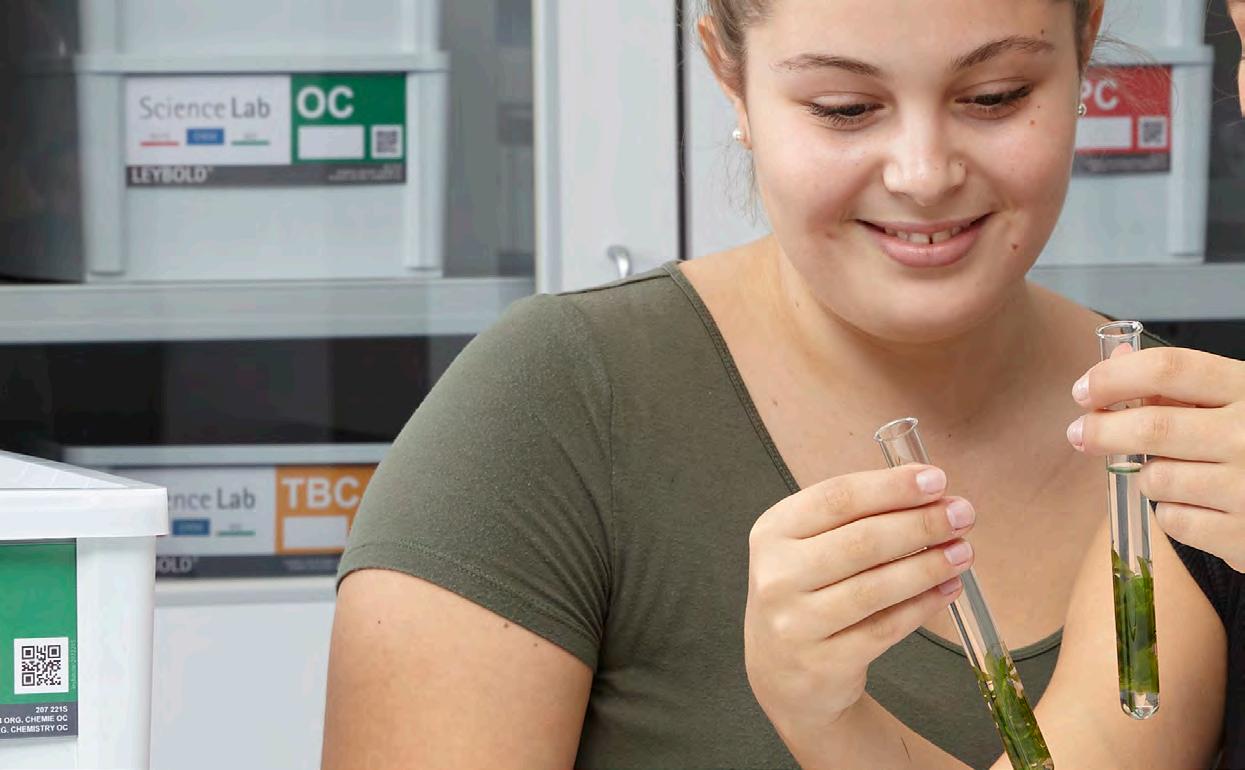
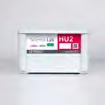







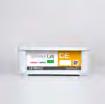
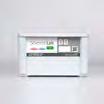
LB4.1 STRUCTURE OF THE CELL
organisms; Multi-cell organisms
LB4.2 PROCESSES IN THE CELL The cell membrane; Cell cycle; Enzymes; Transport processes

EXPERIMENT
LB5.1 DNA EXAMINATIONS
Electrophoresis of DNA; Experimental kits

EXPERIMENT
LB6.1 HYGIENE Introduction
n This Basic Set contains the basic devices which are regularly needed for student experiments in Biology.
n Each device has its own specified space in the pre-formed storage tray.
n With the different thematic sets more than 135 student experiments can be performed in Biology.
n One Basic Set for all fields of biology and a maximum of two trays on the student workstation.
n The Basic Set contains the material required for one working groupconsisting of 2-3 students.
n Experiments from the Science Lab Biology can then be carried out with only one additional set, depending on the topic.
n Same devices = always the same handling: no need to re-learn devices for every topic.







Student experiment set of the student experiment system Science Lab in the field of biology. Basic equipment for experiments in human biology, botanics, ecology and cellular biology. Set-up material for one working group in pre-formed tray. The individual trays are stackable and can optionally be closed with a lid (647 003).
The equipment set Science Lab Biology Basic BB, in combination with at least one of the following biology sets, enables the performance of experiments at school, college and university level for worldwide curriculums:
• Equipment set Science Lab Human Biology HU2 (207 312S)
• Equipment set Science Lab Botanics BO (207 321S)
• Equipment set Science Lab Ecology ECO (207 331S)
• Equipment set Science Lab Cellular Biology CE (207 341S)
Scope of delivery:
Count Name
4 Bosshead S
2 Stand base MF
3 Stand rod 40 cm, 10 mm Ø
1 Universal pencil
1 Stirring thermometer -10...+110 °C
1 Powder spatula, steel, 185 mm
1 Tray, high
1 Round filter, Type 595, 125 mm Ø, Set of 100
1 Blades, 5 pieces
1 Cover slips
1 Microscope slides 76 mm x 26 mm x 1 mm, set of 50
3 Watch glass dish 80 mm Ø
3 Petri dish, 100 x 15 mm, glass
1 Glass stirring rod 200 x 8 mm Ø
1 Measuring cylinder 100 ml, with plastic base
4 Dropping pipette 150 mm x 7 mm Ø
4 Rubber bulb
1 Universal clamp 0...80 mm
1 Spoon-ended spatula, PP, 180 mm
1 Scissors 125 mm, round-ended
1 Laboratory knife
1 Crucible tongs 200 mm
1 Test tube rack metal 20 mm Ø
1 Microscopic set, 6 parts in a box
207 300S Science Lab Biology Basic BB (Set)
Additionally required:
Count Cat.-No. Name
1 207 312S Science Lab Human Biology HU2 (Set)
1 207 321S* Science Lab Botanics BO (Set)
1 207 331S* Science Lab Ecology ECO (Set)
1 207 341S* Science Lab Cellular Biology CE (Set)
* alternative
Additionally recommended:
Count Cat.-No. Name
1 647 003 Lid for tray


Human biology is a key topic in biology lessons and, in addition to improving biology skills, also serves as a tool for health education.
The senses can be taught very well using experiments, where students can be the test subjects themselves
This is the idea the Science Lab Set Human Biology 1 (HU1) is based on. Smell, sight, touch or hearing: the students can perform most of the experiments directy on themselves. The selection of experiments is complemented by anatomical experiments, e.g. the dissection of a porcine’s eye.
The Science Lab Set Human Biology 2 (HU2) deals with the human body and health in general. The students will study the cardiovascular and digestive systems in classic experiments. A particular focus is placed on experiments concerning the nervous system. From reaction tests to memorisation tasks, the students can performed many experiments on their own body. The topic of health focuses on experiments on digestion as well as hygiene, with applicable microbiological experiments.

In this experiment, an image is observed with 3D glasses. Although the surface is flat, the image appears to be three-dimensional. For this experiment you will need the set Science Lab Human Biology HU1 (207 311S)
Further information about our curriculum-compliant topics and student experiments as well as the corresponding sets can be found on the following pages.



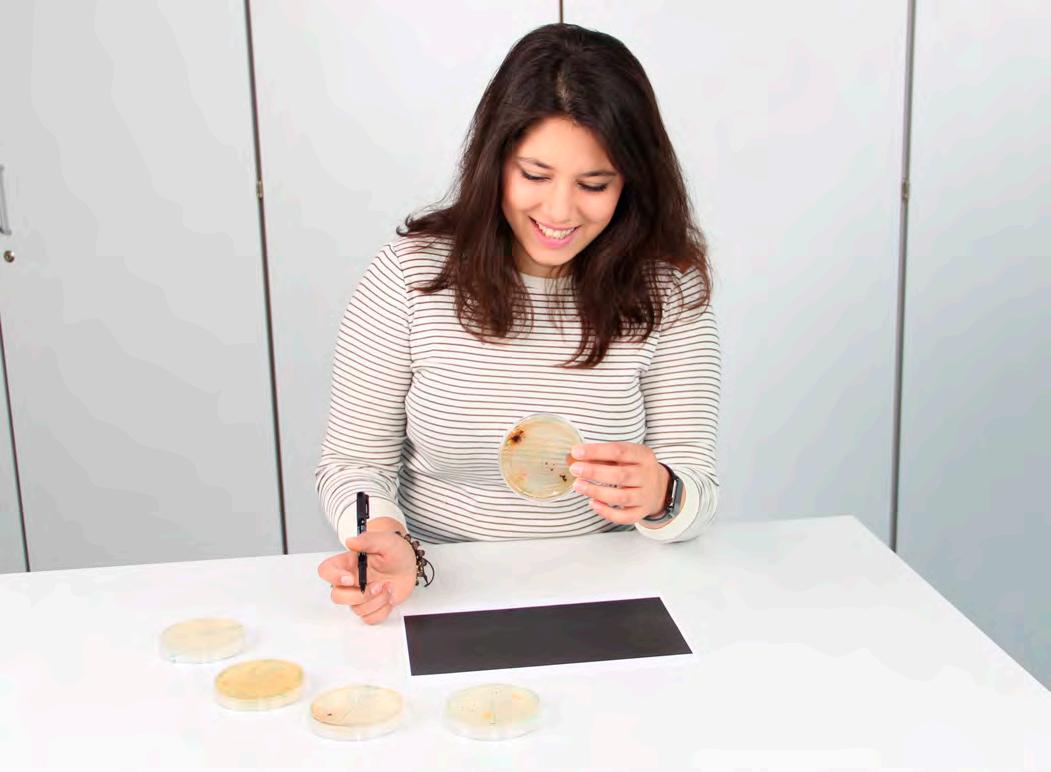
In this experiment, uncovered culture media are placed at different locations. After incubating the culture media, the germ count can be determined by counting the colonies. For this experiment you will need the sets
OVERVIEW
LB1.1.1 Tactile sense
LB1.1.1.1
LB1.1.1.2
LB1.1.1.3
LB1.1.1.4
LB1.1.1.5C
Touch
Distribution of contact points
Cold points
Distance perception on the skin
Heat discharge from the body (with Mobile-CASSY 2 WiFi)
LB1.1.2 Hearing
LB1.1.2.1
LB1.1.2.2
LB1.1.2.3
LB1.1.2.4
Hearing the body’s own sounds
Directional hearing
Bone-conducted sounds and the perception of vibrations
Sound radiation through the eardrum
LB1.1.3 Sight
LB1.1.3.1
LB1.1.3.2
LB1.1.3.3
LB1.1.3.4
LB1.1.3.5
LB1.1.3.6
LB1.1.3.7
LB1.1.3.8
Blind spot
Optical illusions due to convergence
Three-dimensional vision requires two eyes
Apparent depth
Stimulus rivalry and chromatic adaptation
Coloured after-images
Colour contrast
Visual acuity
LB1.1.4 Smell
LB1.1.4.1
LB1.1.4.2
LB1.1.4.3
Perception of different smells
Breathing and smell perception
Adaptation of olfactory cells


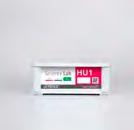


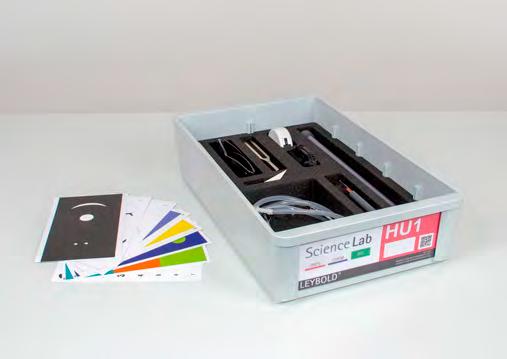
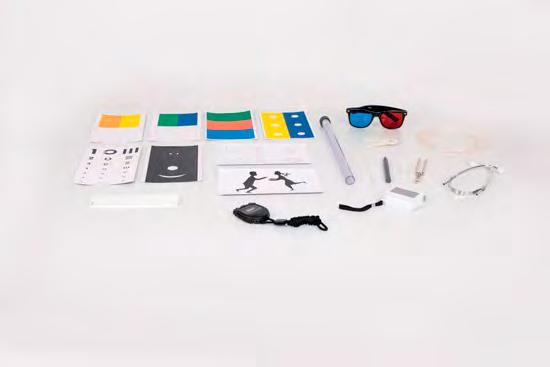
Student experiment set of the student experiment system Science Lab in the field of biology. Set-up material for one working group in pre-formed tray. With the equipment set HU1, 20 experiments at school, college and university level for worldwide curriculums can be performed. The students deal with the topic senses. While working out the curriculum required topics, they are also trained in communication and assessment skills. In combination with the Mobile-CASSY 2 WiFi (524 005W2), there are additional evaluation options which enable the students digital learning.
Scope of delivery:
Count Name
1 Tape measure 2 m / 1 mm
1 Red-cyan glasses (3D)
1 Tray, low
1 Booklet of fragrance strips
1 Set of image optical phenomena
1 Cold-feeler
1 Tactile bristle
1
1


n Students examine their own body functions
n Little preparation time for teachers
n Tactile bristle, cold probe, directional hearing device: extra developed for such experiments
STUDENT MEASURING DEVICE DIGITAL CLASS / EDUCATION

SENSORS

The universal student measuring device with WiFi for all measuring tasks in physics, chemistry and biology.
524 005W2 Mobile-CASSY 2 WiFi
Detailed information on the Mobile-CASSY 2 WiFi can be found on the Internet at www.leybold-shop.com/524005W2 INCLUDED IN SCOPE OF DELIVERY
Temperature probe NiCr-Ni, type K
Included with the purchase of the Mobile-CASSY 2 WiFi (524 005W2). MOBILE-CASSY 2

With the Mobile-CASSY 2 WiFi, voltage (U), current (I), power (P) and energy (E) can be measured via 4 mm safety sockets.
Here you will find an overview of our literature packages. You can find detailed information on our literature on the internet at www.leybold-shop.com.


Detailed experiment instructions for Science Lab Set HU1 (207 311S). Describes 20 experiments from the field of human biology - senses. Topics: Tactile sense; Hearing; Sight; Smell
520 7311EN LIT-print: LB1.1 Human Biology 1 - Senses
Comprehensive biology experiment instructions for the Science Lab. Contains more than 170 experiments in the fields of human biology, botany, ecology, cell biology, genetics and hygiene.
Includes all interactive experiment instructions (Lab Docs) as html file.
520 73 LIT-digital: LB Science Lab Biology
Technical data of the digital version:
• Product key for literature (activation & selection of one literature language in LeyLab)
• Can then be used in LeyLab and Document Center (school/institute licence)
• System requirements: Document Center:
- PC with Windows 7 or higher; internet access during installation; local network for distribution to students LeyLab:
- PC, tablet or smartphone with a current browser; internet access








Details on the following pages
Sensors
LB1.2.1 The cardiovascular system
LB1.2.1.1C
LB1.2.1.2
LB1.2.1.3C
LB1.2.1.4C
Respiratory volume and breathing rate (with Mobile-CASSY 2 WiFi)
Detection of CO2 in exhaled air
Heart rate and pulse (with Mobile-CASSY 2 WiFi)
Blood pressure (with Mobile-CASSY 2 WiFi)
LB1.2.2 The nervous system
LB1.2.2.1C
LB1.2.2.2
LB1.2.2.3C
LB1.2.2.4C
LB1.2.2.5C
LB1.2.2.6C
LB1.2.2.7
LB1.2.2.8
LB1.2.2.9
Model experiment: measuring the resting potential (with Mobile-CASSY 2 WiFi)
The Ostwald-Lillie iron wire model
Reaction time test: visual stimulus (with Mobile-CASSY 2 WiFi)
Reaction time test: acoustic stimulus (with Mobile-CASSY 2 WiFi)
Reaction time test: distraction (with Mobile-CASSY 2 WiFi)
Reaction time test: determining the nerve conduction velocity (with Mobile-CASSY 2 WiFi)
Finger labyrinth - memorisation with eyes closed
Finger labyrinth - memorisation progress
Finger labyrinth - memorisation with eyes opened
LB1.2.3 Digestion
LB1.2.3.1
LB1.2.3.2
LB1.2.3.3
LB1.2.3.4C
LB1.2.3.5
Digestion in the mouth
Pepsin-regulated digestion of proteins in the stomach
Pepsin-regulated digestion of proteins in the stomach - temperature dependence
Fat digestion with pancreatin (with Mobile-CASSY 2 WiFi)
Starch digestion with pancreatin
LB1.2.4 Sensory organs
LB1.2.4.1 Preparation of a porcine eye
LB1.3.1 Nutrition
LB1.3.1.1
LB1.3.1.2
LB1.3.1.3
LB1.3.1.4
LB1.3.1.5
Testing foods for glucose
Testing foods for starch
Testing foods for fats
Testing foods for proteins
Testing foods for vitamin C
LB1.3.2 Hygiene
LB1.3.2.1
LB1.3.2.2
LB1.3.2.3
LB1.3.2.4
LB1.3.2.5
LB1.3.2.6
LB1.3.2.7 Preparation and sterilisation of culture mediums
Colony counting in the air
Determination of the germ content of banknotes and coins
Comparing the germ content of washed and unwashed hands
Simulation of an infection chain with baking yeast
Bacteriostatic effect of different substances
Sterilisation, cleansing or destruction of equipment and breeding grounds
LB1.3.3 Food technology
LB1.3.3.1
LB1.3.3.2 Detecting fermentation products of yeasts
Temperature-dependence of the fermentation process
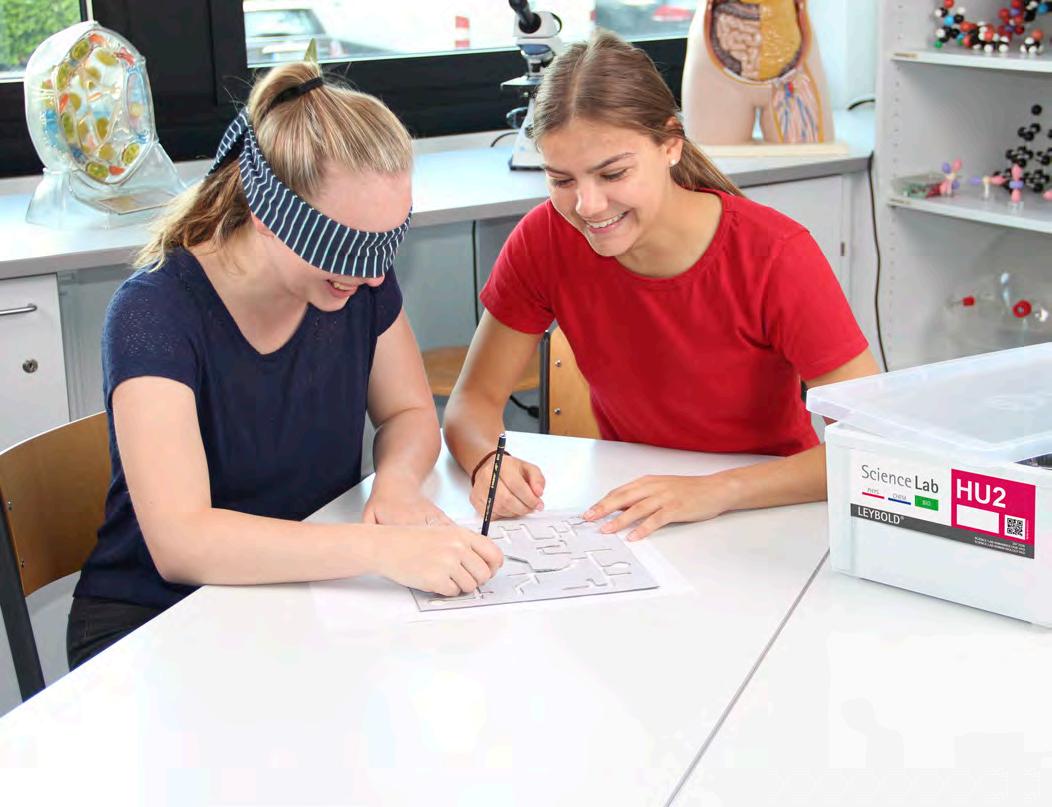
OVERVIEW





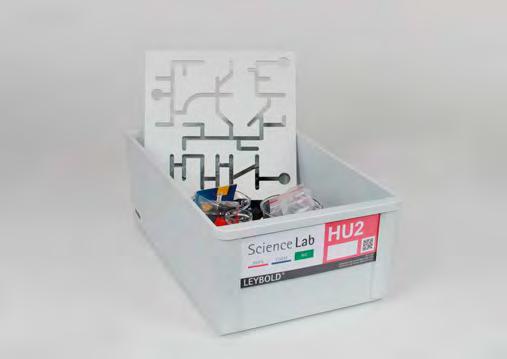

Student experiment set of the student experiment system Science Lab in the field of biology. Set-up material for one working group in pre-formed tray. With the equipment set HU2, together with the Science Lab Biology Basic BB (207 300S), 33 experiments at school, college and university level for worldwide curriculums can be performed.
The students deal with the topics body and health. While working out the curriculum required topics, they are also trained in communication and assessment skills. In combination with the Mobile-CASSY 2 WiFi (524 005W2), there are additional evaluation options which enable the students digital learning.
Scope of delivery:
Count Name
2 Connecting lead 19 A, 50 cm, red/blue, pair
4 Crocodile clip, polished
4 Beaker Boro 3.3, 100 ml, squat
1 Tray, high
1 Drigalski spatula, glass
1 Iron nail, set 2
1 Maze for finger
8 Test tube Fiolax 16 mm x 160 mm
2 Beaker Boro 3.3, 400 ml, squat
1 Erlenmeyer flask 250 ml, narrow neck, SB 29
1 Plate electrode zinc 43 x 28 mm
Count Name 4 Plate electrode carbon 43 x 28 mm 1 Grindstone 1 Fermentation tube 200 mm x 8 mm Ø 3 Graduated pipette 10 ml 1 Pipetting aid 1 Sieve, plastic, 70 mm Ø 1 Rubber balloons, set of 10 3 Rubber stopper solid, 14...18 mm Ø 1 Rubber stopper, one 7-mm hole, 25...31 mm Ø
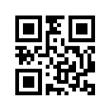

n Including the important topics on hygiene and nutrition
n Modern model experiments on resting potential and nerve transmission
Additionally
1
Additionally
1
1
1
1
1
1
1
1
1
1
1
student





The universal student measuring device with WiFi for all measuring tasks in physics, chemistry and biology.
524 005W2 Mobile-CASSY 2 WiFi
Detailed information on the Mobile-CASSY 2 WiFi can be found on the Internet at www.leybold-shop.com/524005W2
For measuring reaction times, controlled by a hand or foot button, and for determining nerve conductor speed. Signalling accomplished as selected, either via three-colour LEDs (hand key) or acoustic sign (foot button) or software with CASSY (524 013, 524 006, 524 005W2, 524 018).
524 0461 Reaction test adapter S
For measurement of the pulse frequency with the aid of an infrared sensor which is attached to the ear lobe or finger tip, whereby the sensibility is adjusted automatically. The individual pulse beats are indicated by a LED. The pulse sensor is electrically isolated from CASSY (524 013, 524 006, 524 005W2, 524 018).
524 0471 Pulse sensor S
For blood pressure measurements using the oscillometric method with Sensor-CASSY 2 (524 013) or Pocket-CASSY (524 006, 524 018) without stethoscope and microphone. The pressure variations which are caused by the pulse waves are transmitted by the arm collar and measured together with the falling pressure in the arm collar. Alternative for use with the Mobile-CASSY (524 005W2) after the auscultatoric method (designed by Korotkov). The characteristic noise phenomena are listened to with a stethoscope (additionally required).
The universal biology measuring instrument (531 837) gives an audible sound for the pressure variations.
524 0501 Blood pressure sensor S
For pneumotachographic measurement of various pulmonary volumes, the flow-volume curve and the forced expiratory volume per second with CASSY (524 013, 524 006, 524 005W2, 524 018).
524 056 Spirometer box

Chemicals Science Lab Human Biology
Chemicals for carrying out student experiments in Science Lab Human Biology HU2. The chemical set contains 20 different chemicals which can be used to perform every experiment at least 10 times.
679 312 Chemicals Science Lab Human Biology
The individual chemicals from this set can be found on the Internet at www.leybold-shop.com. There you will also learn more about the corresponding hazard symbols and classes, the safe handling of chemicals and the hazard and safety instructions.
Here you will find an overview of our literature packages. You can find detailed information on our literature on the internet at www.leybold-shop.com.

SUBJECT

520 73 LIT-digital: LB Science Lab Biology TOPIC
LIT-print: LB1.2+LB1.3 Human Biology 2 - Body and Health
Detailed experiment instructions for Science Lab Set HU2 (207 312S). Describes 33 experiments from the field of human biology - body and health.
Topics:
Cardiovascular system; Nervous system; Digestion; Sensory organs; Nutrition; Hygiene; Food technology
520 7312EN LIT-print: LB1.2+LB1.3 Human Biology 2 - Body and health
LIT-digital: LB Science Lab Biology
Comprehensive biology experiment instructions for the Science Lab. Contains more than 170 experiments in the fields of human biology, botany, ecology, cell biology, genetics and hygiene.
Includes all interactive experiment instructions (Lab Docs) as html file.
Technical data of the digital version:
• Product key for literature (activation & selection of one literature language in LeyLab)
• Can then be used in LeyLab and Document Center (school/institute licence)
• System requirements: Document Center:
- PC with Windows 7 or higher; internet access during installation; local network for distribution to students LeyLab:
- PC, tablet or smartphone with a current browser; internet access





The investigation of the shape and function of plants is easily accessible in forms of experiments. The Science Lab Set Botany (BO) can, for example, be used to examine leaves and flowers. A focus is placed on experiments for studying plant mechanisms, e.g. the water balance or photosynthesis. A special emphasis lies on experiments that can easily be performed in one class/lecture and demonstrate the effects in a particularly impressive way.
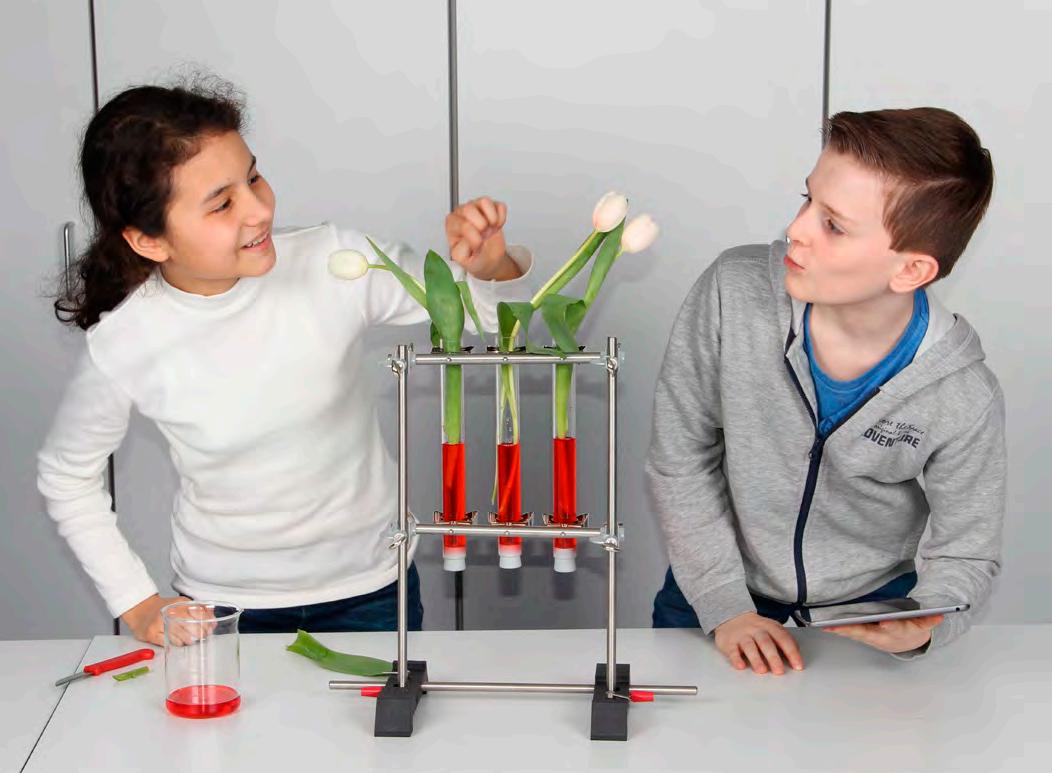
In this experiment, the path of the water in the shoot of a plant is visualised. To do this, a freshly cut shoot of a white-flowered plant is placed in dyed water. For this experiment you will need the sets Science Lab Biology Basic BB (207 300S) and Science Lab Botany BO (207 321S)
LB2.1 THE SHAPE OF PLANTS
LB2.2 FUNCTION OF PLANTS



LB2.2.3.1 Light-dependency during photosynthesis
In this experiment, rising air bubbles on the shoot of an aquatic plant are counted. To do this, one plant is exposed to light beforehand and one is kept in darkness. For this experiment you will need the sets Science Lab Biology Basic BB (207 300S) and Science Lab Botany BO (207 321S)
Further information about our curriculum-compliant topics and student experiments as well as the corresponding sets can be found on the following pages.
LB2.0 INTRODUCTION TO METHODS
LB2.0.0 Microscopy
LB2.0.0.1
LB2.0.0.2
LB2.1
Structure and functionality of an optical microscope Making preparations
LB2.1.1 Leaf
LB2.1.1.1
LB2.1.1.2
LB2.1.1.3
LB2.1.1.4
LB2.1.1.5
LB2.1.1.6
LB2.1.1.7
Examination of a leaf
Leaf structure of a moss leaf
Leaf cross-section with upper and lower epidermis
Surface cut: Stomata under the microscope
Plant cell: Structure of an onion cell
Organs for water evaporation
Many parts of a plant have evaporation protection
LB2.1.2 Flower
LB2.1.2.1
LB2.1.2.2
Examination of a flower Pollen and pollen tube
LB2.1.3 Plant stem
LB2.1.3.1 Cross-section through a plant stem
LB2.1.4 Roots
LB2.1.4.1
LB2.1.4.2 Organs for water uptake Root hair development
LB2.2
LB2.2.1 Germination and growth
LB2.2.1.1
LB2.2.1.2
LB2.2.1.3
LB2.2.1.4
LB2.2.1.5
LB2.2.1.6
Swelling
Swelling pressure
Dependence of germination on various factors
Light influences the germination of plants
Cellular respiration during germination
Selection capability of roots
LB2.2.2 Water balance
LB2.2.2.1
LB2.2.2.2
LB2.2.2.3
LB2.2.2.4
LB2.2.2.5
LB2.2.2.6
LB2.2.2.7
Plants cannot live without water
Water transport in a shoot
Water rises in capillaries
Importance of the stomata
Dependence of the water requirement on number and size of leaves
Water consumption of plants living in moist and dry habitats
Measurement of transpiration
LB2.2.3 Photosynthesis
LB2.2.3.1
LB2.2.3.2
LB2.2.3.3
LB2.2.3.4
LB2.2.3.5
Light-dependency during photosynthesis
Testing for oxygen during photosynthesis
Carbon dioxide and photosynthesis
Testing for starch during photosynthesis
Separation of leaf pigments via paper chromatography
32 EXPERIMENTS









Student experiment set of the student experiment system Science Lab in the field of biology. Set-up material for one working group in pre-formed tray. With the equipment set BO, together with the Science Lab Biology Basic BB (207 300S), 32 experiments at school, college and university level for worldwide curriculums can be performed.
The students deal with the shape and function of plants. While working out the curriculum required topics, they are also trained in communication and assessment skills.
Scope of delivery:
Count Name
2 Stand rod 25 cm, with holes
1 Capillary apparatus
1 Lamp socket, E27, Euro plug
6 Clip plug, large
2 Beaker Boro 3.3, 100 ml, squat
1 Tray, high
1 LED Plant lamp
3 Test tube Fiolax 16 mm x 160 mm
1 Beaker Boro 3.3, 400 ml, squat
1 Erlenmeyer flask 250 ml, narrow neck, SB 29
Count Name 1 Funnel PP 75 mm Ø 3 Plastic tube 240 x 25 mm Ø
Fermentation tube 200 mm x 8 mm Ø
Pestle 88 mm
Mortar porcelain 70 mm Ø
Magnifier 8x 1 Rubber stopper solid, 14...18 mm Ø 3 Rubber stopper solid, 19...24 mm Ø 1 Rubber stopper, one 7-mm hole, 25...31 mm Ø
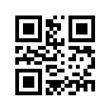

n Student experiments for parallel display and comparison of several samples (set-up with stand rod with holes)
n Includes microscopy experiments and basics of microscopy
n Impressive experiments, e.g. swelling pressure during germination, measurement of transpiration or oxygen detection during photosynthesis
Additionally required per student
Count Cat.-No.
1 610 010 Laboratory safety goggles, Focomax
Additionally required per working group
Count Cat.-No.
1 207 300S Science Lab Biology Basic BB (Set)
1 656 017 Teclu burner, universal
1 607 020 Safety gas hose with clamp 0.5 m
1 MIK5738860 Microscop EduLed FLQ
1 661 243 Wash bottle PE, 500 ml
1 ADACB501 Compact scale 500 g : 0.1 g
1 666 8471 Magnetic stirrer with hot plate
Additionally required per class
Count
1 520 73 LIT-digital: LB Science Lab Biology
1 679 320 Chemicals Science Lab Botany BO
1 675 3410 Water, pure, 5 l
1 610 290 Parafilm, 100 mm-w.
1 661 055 Chromatography paper, 580 x 600 mm, 25 sheets
1 661 080 Cobalt chloride test paper 2 x 7 cm, 100 stripes
1 661 091 Boiling stones 100 g
1 665 568 Microcapillaries
Detailed information on Mobile-CASSY 2 WiFi, sensors, literature packages and chemical sets are available on the following pages.


MOBILE-CASSY 2 WIFI
Mobile-CASSY 2 WiFi
The universal student measuring device with WiFi for all measuring tasks in physics, chemistry and biology. 524 005W2 Mobile-CASSY 2 WiFi
Detailed information on the Mobile-CASSY 2 WiFi can be found on the Internet at www.leybold-shop.com/524005W2
Temperature probe NiCr-Ni, type K
Included with the purchase of the Mobile-CASSY 2 WiFi (524 005W2).

With the Mobile-CASSY 2 WiFi, voltage (U), current (I), power (P) and energy (E) can be measured via 4 mm safety sockets.


Chemicals for carrying out student experiments in Science Lab Botany BO. The chemical set contains 15 different chemicals which can be used to perform every experiment at least 10 times.
679 320 Chemicals Science Lab Botany
The individual chemicals from this set can be found on the Internet at www.leybold-shop.com. There you will also learn more about the corresponding hazard symbols and classes, the safe handling of chemicals and the hazard and safety instructions.
Here you will find an overview of our literature packages. You can find detailed information on our literature on the internet at www.leybold-shop.com.


Detailed experiment instructions for Science Lab Set Botany BO (207 321S). Describes 32 experiments from the field of botany.
Topics:
Microscopy; Leaf; Flower; Plant stem; Roots; Germination and growth; Water balance; Photosynthesis
520 7321EN LIT-print: LB2 Botany
Comprehensive biology experiment instructions for the Science Lab. Contains more than 170 experiments in the fields of human biology, botany, ecology, cell biology, genetics and hygiene.
Includes all interactive experiment instructions (Lab Docs) as html file.
520 73 LIT-digital: LB Science Lab Biology
Technical data of the digital version:
• Product key for literature (activation & selection of one literature language in LeyLab)
• Can then be used in LeyLab and Document Center (school/institute licence)
• System requirements: Document Center:
- PC with Windows 7 or higher; internet access during installation; local network for distribution to students LeyLab:
- PC, tablet or smartphone with a current browser; internet access





Ecology means more than the common use of the word “eco” would suggest. One of the aims of the Science Lab Set Ecology (ECO) is to observe and describe an ecosystem from as many perspectives as possible.
Students can measure the temperature and illuminance or compare soils from a forest and from the side of a road. Another area of experimental investigation will be biodiversity.

LB3.1.3.4 Observation of living organism in an infusion of hay
In this experiment, eukaryotic and prokaryotic single-cell and multi-cell organisms can be observed. In an infusion of hay, for example, bacteria, flagellated single-celled organisms, ciliates or rotifers can develop.
For this experiment you will need the sets Science Lab Biology Basic BB (207 300S) and Science Lab Ecology ECO (207 331S)
LB3.1 ECOSYSTEMS
LB3.2 ANALYSIS OF ECOSYSTEMS
LB3.3 HUMANS AND THE ENVIRONMENT
LB3.4 EVOLUTION



LB3.2.2.3C pH value of soil samples
In this experiment, water flows through various soil samples. The pH values of the filtrates are determined using the Mobile-CASSY 2 WiFi. The students will find out that plants prefer specific soil properties and therefore can serve as a pH indicator. For this experiment you will need the sets Science Lab Biology Basic BB (207
and
Further information about our curriculum-compliant topics and student experiments as well as the corresponding sets can be found on the following pages.
LB3.0 INTRODUCTION TO METHODS
LB3.0.0 Microscopy
LB3.0.0.1
LB3.0.0.2
Structure and functionality of an optical microscope
Making micro-preparations
LB3.1 ECOSYSTEMS
LB3.1.1 Abiotic factors
LB3.1.1.1
LB3.1.1.2C
LB3.1.1.3C
LB3.1.1.4C
LB3.1.1.5
LB3.1.1.5C
LB3.1.1.6
Temperature-dependence of life processes
Bergmann’s rule (factor temperature) (with Mobile-CASSY 2 WiFi)
Allen’s rule (factor temperature) (with Mobile-CASSY 2 WiFi)
Grouping as protection from cold (with Mobile-CASSY 2 WiFi)
Insulating effect of body protection
Insulating effect of body protection (with Mobile-CASSY 2 WiFi)
Comparison of leaf cross-sections: Sun leaf and shade leaf
LB3.1.2 Biotic factors
LB3.1.2.1
LB3.1.2.3
Interspecific competition in plants
Symbiosis
LB3.1.3 Biodiversity
LB3.1.3.2
LB3.1.3.4
Analysis of ground fauna using sieves (Berlese funnels)
Observation of living organisms in an infusion of hay
LB3.1.4 Population ecology
LB3.1.4.3 Food chain: Decomposers
LB3.2.1 Analysis of waterbodies on site
LB3.2.1.2C
LB3.2.1.3C
LB3.2.1.4
LB3.2.1.5C
LB3.2.1.6C
pH value of waterbodies (with Mobile-CASSY 2 WiFi)
Salt content of waterbodies (with Mobile-CASSY 2 WiFi)
Chemical water parameters
Water protocol (with Mobile-CASSY 2 WiFi)
Temperature measurement in waterbodies (with Mobile-CASSY 2 WiFi)
LB3.2.2 Forest and soil analysis
LB3.2.2.1
LB3.2.2.2
LB3.2.2.3C
LB3.2.2.4C
LB3.2.2.5C
LB3.2.2.6C
LB3.2.2.7C
LB3.2.2.8C
Sedimentation of soil particles
Soil and water
pH value of soil samples (with Mobile-CASSY 2 WiFi)
Humus formation and humus types (with Mobile-CASSY 2 WiFi)
Salt content of the soil (with Mobile-CASSY 2 WiFi)
Abiotic factor: light intensity (with Mobile-CASSY 2 WiFi)
Temperature depending on location (with Mobile-CASSY 2 WiFi)
Diurnal variation measurements (with Mobile-CASSY 2 WiFi)
LB3.3 HUMANS AND THE ENVIRONMENT
LB3.3.1 Water pollution
LB3.3.1.1
LB3.3.1.2
LB3.3.1.4
Foam - a substantial burden on the environment
Eutrophication of waterbodies by phosphates
Efficacy of gravel filters and activated charcoal filters
LB3.3.2 Soil pollution
LB3.3.2.1
LB3.3.2.2
Toxicity measurement of petrol with cress seeds
Soil contamination with non-biological substances
LB3.3.3 Air pollution
LB3.3.3.1 Determination of emissions using the example of engine exhaust emissions
LB3.4 EVOLUTION
LB3.4.1 Adaptation to the environment
LB3.4.1.1
LB3.4.1.2 Wing feathers of birds
Examination of fish scales
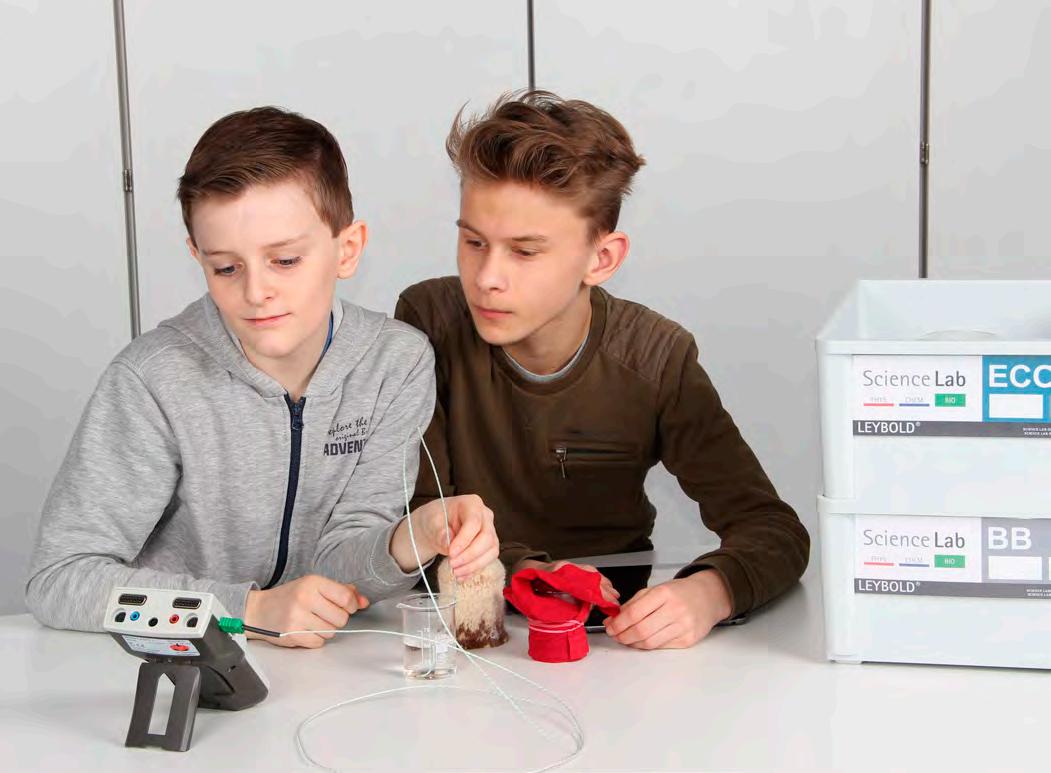
LB3.1.1.5C Insulating effect of body protection
LB3.0 TO LB3.4 ECOLOGY






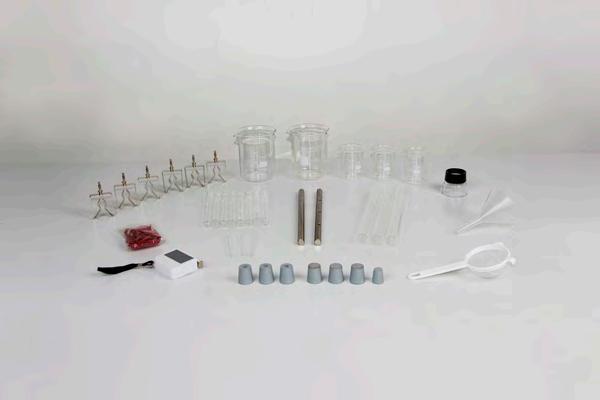
Student experiment set of the student experiment system Science Lab in the field of biology. Set-up material for one working group in pre-formed tray. With the equipment set ECO, together with the Science Lab Biology Basic BB (207 300S), 35 experiments at school, college and university level for worldwide curriculums can be performed.
The students deal with the topics of ecosystems, exploring ecosystems, humans and the environment and evolution. While working out the curriculum required topics, they are also trained in communication and assessment skills. In combination with the Mobile-CASSY 2 WiFi (524 005W2), there are additional evaluation options which enable the students digital learning.
Scope of delivery:
Count Name
2 Stand rod 25 cm, with holes
1 Tape measure 2 m / 1 mm
1 Rubber rings, set of 8
6 Clip plug, large
3 Beaker Boro 3.3, 100 ml, squat
1 Tray, high
8 Test tube Fiolax 16 mm x 160 mm
2 Beaker Boro 3.3, 400 ml, squat
1 Funnel PP 75 mm Ø
Name
Glass tube 80 x 8 mm Ø
Plastic tube 240 x 25 mm Ø
Sieve, plastic, 70 mm Ø
Magnifier 8x
Rubber stopper solid, 14...18 mm Ø
Rubber stopper solid, 19...24 mm Ø
Rubber stopper, one 7-mm hole, 19...24 mm Ø


n Contains microscopy experiments and basics for microscopy
n Student experiments for parallel display and comparison of several samples (set-up with stand rod with holes)
n Easy introduction to digital measurements and evaluation
Additionally required per student
Count Cat.-No. Name
1 610 010 Laboratory safety goggles, Focomax
Additionally required per working group
Count Cat.-No. Name
1 207 300S Science Lab Biology Basic BB (Set)
1 656 017 Teclu burner, universal
1 607 020 Safety gas hose with clamp 0.5 m
1 MIK573886 Microscop EduLed FLQ
Description
Description
1 524 005W2 Mobile-CASSY 2 WiFi for digital experiments
1 529 670 Conductivity sensor
1 524 0671 Conductivity adapter S
1 529 672 pH sensor, BNC
1 524 0672 pH adapter S
1 524 0673 NiCr-Ni adapter S, type K
1 524 444 Lux sensor M
2 666 1261 Temperature probe, Ni-Cr-Ni, fast, type K Ecosystems (abiotic factors) experiments (LB3.1.1)
1 ADACB501 Compact scale 500 g : 0.1 g
Additionally required per class
Count Cat.-No. Name
1 520 73 LIT-digital: LB Science Lab Biology
1 679 330 Chemicals Science Lab Ecology ECO
1 MA90204 Universal indicator paper pH 1...14, roll
1 MA91201 Test sticks total water hardness
2 MA91313 Test sticks Nitrate/Nitrite
1 MA91315 Test sticks Ammonium
1 MA91320 Test sticks Phosphate
1 674 4640 Buffer solution pH 4.00, 250 ml
1 674 4670 Buffer solution pH 7.00, 250 ml
1 666 8036 Drying oven UNB, 30 l
Description
Analysis of ecosystems experiments (LB3.2.1, LB3.2.2)
Analysis of ecosystems experiments (LB3.2.1, LB3.2.2)
Analysis of ecosystems experiments (LB3.2.2)
Detailed information on Mobile-CASSY 2 WiFi, sensors, literature packages and chemical sets are available on the following pages.


The universal student measuring device with WiFi for all measuring tasks in physics, chemistry and biology.
Temperature probe NiCr-Ni, type K
Included with the purchase of the Mobile-CASSY 2 WiFi (524 005W2).



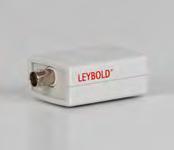

Conductivity sensor using four-wire technology with integrated Pt temperature sensor for use with chemistry box (524 067), conductivity adapter S (524 0671) and CASSY (524 013, 524 006, 524 005W2, 524 018) or the universal chemistry measuring instrument (531 836). Open design for rapid response to changes in conductivity. When conducting measurements a minimum distance of 1 cm from the side of the, as well as a minimum immersion depth of 2 cm are to be maintained.
529 670 Conductivity sensor
Conductivity adapter S
Used in conjunction with the conductivity sensor (529 670), this adapter enables conductivity and temperature to be measured with CASSY (524 013, 524 006, 524 005W2, 524 018) or the universal chemistry measuring instrument (531 836).
524 0671 Conductivity adapter S
pH glass electrode in plastic shaft and BNC plug for use with the chemistry box (524 067), pH adapter S (524 0672) and CASSY (524 013, 524 006, 524 005W2, 524 018) or the universal chemistry measuring instrument (531 836). Low-maintenance pH electrode with solid electrolyte made of a conductive gel-like polymer.
529 672 pH sensor, BNC For storage 3 M Potassium chloride sol. is recommended (672 5250).
Enables a pH electrode to be connected to CASSY (524 013, 524 006, 524 005W2, 524 018) or the universal chemistry measuring instrument (531 836). Moreover, the voltage at the BNC socket can be measured at a very high resistance, e.g. for measuring electrochemical potentials.
524 0672 pH adapter S
Enables connection of two NiCr-Ni (type K miniature flat connector) thermocouples for temperature and differential tempature measurements with CASSY (524 013, 524 006, 524 005W2, 524 018) or the universal measuring instruments (531 835, 531 836, 531 837).
524 0673 NiCr-Ni adapter S, type K


LITERATURE PACKAGES
Lux sensor M
For measuring the illuminance of visible light with Mobile-CASSY 2 WiFi (524 005W2). The lux sensor has a flat design so that it can, for example, be inserted directly into the holder for diaphragms and slides (459 33). With the lux sensor, measurements can be performed along and orthogonal to the optical axis. A printed millimetre scale is used to position the sensor on the optical axis and also enables the recording of intensity distributions of different diffraction objects (e.g. 469 731) without additional equipment.
524 444 Lux sensor M
Chemicals for carrying out student experiments in Science Lab Ecology. The chemical set contains 11 different chemicals which can be used to perform every experiment at least 10 times.
The individual chemicals from this set can be found on the Internet at www.leybold-shop.com. There you will also learn more about the corresponding hazard symbols and classes, the safe handling of chemicals and the hazard and safety instructions.
Here you will find an overview of our literature packages. You can find detailed information on our literature on the internet at www.leybold-shop.com.
Detaile experiment instructions for Science Lab Set ECO (207 331S). Describes 35 experiments from the field of ecology.


Topics:
Microscopy; Abiotic factors; Biotic factors; Biodiversity; Population ecoloy; Analysis of waterbodies on site; Forest and soil analysis; Water pollution; Soil pollution; Air pollution; Adaptation to the environment
520 7331EN LIT-print: LB3 Ecology
Comprehensive biology experiment instructions for the Science Lab. Contains more than 170 experiments in the fields of human biology, botany, ecology, cell biology, genetics and hygiene. Includes all interactive experiment instructions (Lab Docs) as html file.
520 73 LIT-digital: LB Science Lab Biology
Technical data of the digital version:
• Product key for literature (activation & selection of one literature language in LeyLab)
• Can then be used in LeyLab and Document Center (school/institute licence)
• System requirements:
Document Center:
- PC with Windows 7 or higher; internet access during installation; local network for distribution to students LeyLab:
- PC, tablet or smartphone with a current browser; internet access





All living beings are made up of cells. The experiments from the Science Lab set Cell Biology (CE) therefore begins with the structure of single-cell and multi-cell organisms.
Furthermore, the inner life of the cell is of relevance in the classroom. Students can examine the functions of the cell membrane and enzymes as well.
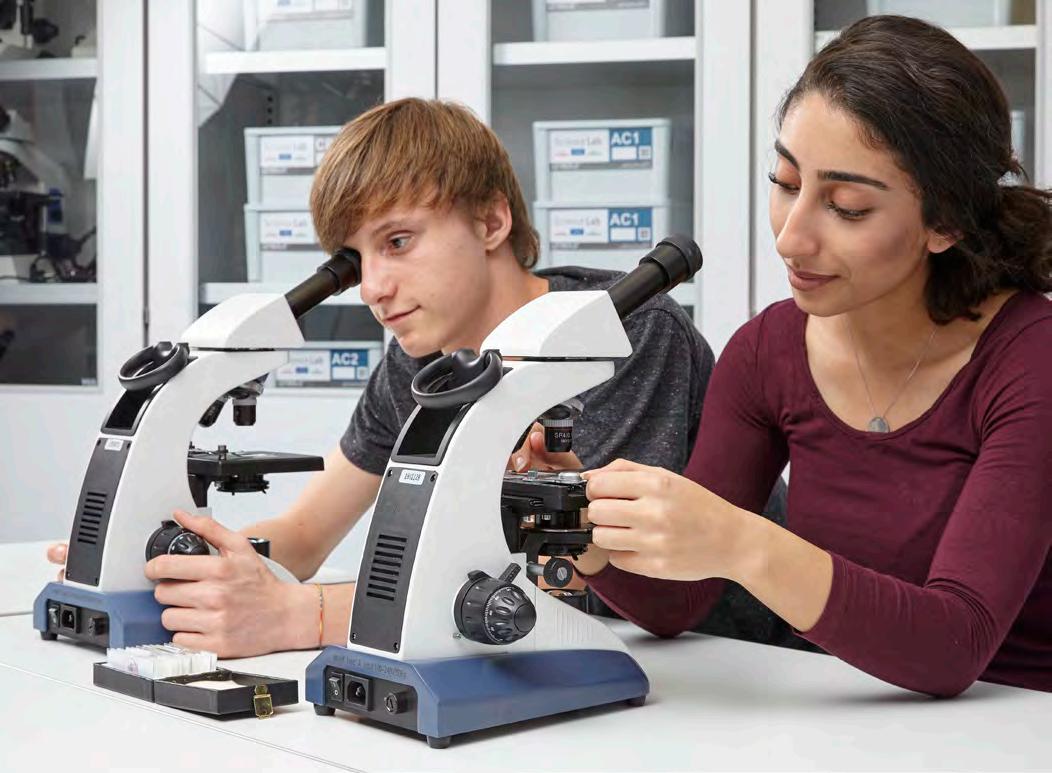
Using high-quality micropreparations, the differences and similarities of animal and plant cells can be examined. For this experiment you will need the sets Science Lab Biology Basic BB (207 300S) and Science Lab Cell Biology CE (207 341S)
Further information about our curriculum-compliant topics and student experiments as well as the corresponding sets can be found on the following pages.
LB4.1 STRUCTURE OF THE CELL
LB4.2 PROCESSES IN THE CELL



LB4.2.3.3 Temperature-dependent enzyme effect using the example of catalase
In this experiment, the temperature dependence of the catalase enzyme is examined. To do this, the splitting of hydrogen peroxide using catalase is carried out at different temperatures. A temperature-dependent development of gas can be observed. For this experiment you will need the sets Science Lab Biology Basic BB (207 300S) and Science Lab Cell Biology CE (207 341S)
Sensors
LB4.0
LB4.0.0 Microscopy
LB4.0.0.1
LB4.0.0.2
LB4.1
Structure and functionality of an optical microscope
Making micro-preparations
LB4.1.1 Single-cell organisms
LB4.1.1.1
LB4.1.1.2
LB4.1.1.3
Microscopy of yeast cells
Microscopy of mould
Live/dead staining of yeast cells
LB4.1.2 Multi-cell organisms
LB4.1.2.1
LB4.1.2.2
LB4.1.2.3
LB4.1.2.4
LB4.2
Plant cell: Structure of an onion cell
Animal cell: Cells of the oral mucosa, uncoloured
Comparison between an animal and a plant cell
Colouration of an onion skin
LB4.2.1 The cell membrane
LB4.2.1.1
LB4.2.1.2
Plasmolysis and deplasmolysis
Diffusion and osmosis
LB4.2.2 Cell cycle
LB4.2.2.1 Prepare mitosis stages of an onion root
LB4.2.3 Enzymes
LB4.2.3.1
LB4.2.3.2C
LB4.2.3.3
LB4.2.3.3C
LB4.2.3.4C
LB4.2.3.5
Effect of the enzyme catalase on yeast
Urea splitting by urease and inhibition (with Mobile-CASSY 2 WiFi)
Temperature-dependent enzyme effect using the example of catalase
Enzyme effect and temperature using the example of catalase (with Mobile-CASSY 2 WiFi)
Temperature-dependent urea splitting by urease (with Mobile-CASSY 2 WiFi)
Enzyme activity dependent on pH value
LB4.2.4 Transport processes
LB4.2.4.1 Cytoplasmic streaming in waterweed


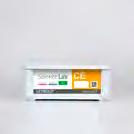





Student experiment set of the student experiment system Science Lab in the field of biology. Set-up material for one working group in pre-formed tray. With the equipment set CE, together with the Science Lab Biology Basic BB (207 300S), 19 experiments at school, college and university level for worldwide curriculums can be performed.
The students deal with the topics cell structure and cell processes. While working out the curriculum required topics, they are also trained in communication and assessment skills. In combination with the Mobile-CASSY 2 WiFi (524 005W2), there are additional evaluation options which enable the students digital learning.
Scope of delivery:
3 Beaker Boro 3.3, 100 ml, squat
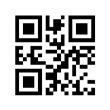

n Focus on enzymatic experiments
n First steps in digital measurements and evaluation
STUDENT MEASURING DEVICE

DIGITAL CLASS / EDUCATION
The universal student measuring device with WiFi for all measuring tasks in physics, chemistry and biology. 524 005W2 Mobile-CASSY 2 WiFi
Detailed information on the Mobile-CASSY 2 WiFi can be found on the Internet at www.leybold-shop.com/524005W2
Additionally required per student
Count Cat.-No. Name Description
1 610 010 Laboratory safety goggles, Focomax
Additionally required per working group
Count Cat.-No. Name
1 207 300S Science Lab Biology Basic BB (Set)
1 MIK573886 Microscope EduLed FLQ
1 656 017 Teclu burner, universal
1 607 020 Safety gas hose with clamp 0.5 m
1 524 005W2 Mobile-CASSY 2 WiFi for digital experiments
1 529 670 Conductivity sensor
1 524 0671 Conductivity adapter S
1 668 8471 Magnetic stirrer with hot plate
1 666 851 Stirring magnet 25 mm x 6 mm Ø, circular Enzymes experiments (LB4.2.3)
Additionally required per class
Count Cat.-No. Name
1 520 73 LIT-digital: LB Science Lab Biology
1 679 360 Chemicals Science Lab Cell Biology
1 675 3410 Water, pure, 5 l
1 MA90204 Universal indicator paper pH 1...14, roll
Detailed information on Mobile-CASSY 2 WiFi, sensors, literature packages and chemical sets are available on the following pages.

Temperature probe NiCr-Ni, type K
Included with the purchase of the Mobile-CASSY 2 WiFi (524 005W2).

Conductivity sensor using four-wire technology with integrated Pt temperature sensor for use with chemistry box (524 067), conductivity adapter S (524 0671) and CASSY (524 013, 524 006, 524 005W2, 524 018) or the universal chemistry measuring instrument (531 836). Open design for rapid response to changes in conductivity. When conducting measurements a minimum distance of 1 cm from the side of the, as well as a minimum immersion depth of 2 cm are to be maintained.


Chemicals for carrying out student experiments in Science Lab Cell Biology CE. The chemical set contains 15 different chemicals which can be used to perform every experiment at least 10 times.
679
The individual chemicals from this set can be found on the Internet at www.leybold-shop.com. There you will also learn more about the corresponding hazard symbols and classes, the safe handling of chemicals and the hazard and safety instructions.
Here you will find an overview of our literature packages. You can find detailed information on our literature on the internet at www.leybold-shop.com.


Detailed experiment instructions for the Science Lab set Cell Biology CE (207 341S). Describes 19 experiments from the field of cell biology.
Topics:
Microscopy; Single-cell orgnisms; Multi-cell organisms; The cell membrane; Cell Cycle; Enzymes; Transport processes
520 7341EN LIT-print: LB4 Cell Biology
Comprehensive biology experiment instructions for the Science Lab. Contains more than 170 experiments in the fields of human biology, botany, ecology, cell biology, genetics and hygiene.
Includes all interactive experiment instructions (Lab Docs) as html file.
520 73 LIT-digital: LB Science Lab Biology
Technical data of the digital version:
• Product key for literature (activation & selection of one literature language in LeyLab)
• Can then be used in LeyLab and Document Center (school/institute licence)
• System requirements: Document Center:
- PC with Windows 7 or higher; internet access during installation; local network for distribution to students LeyLab:
- PC, tablet or smartphone with a current browser; internet access





Genetics and genetic engineering methods have been found in almost every biological laboratory since the 1970s. Therefore, the subject area is also of great importance for colleges and universities.
The experiments on the Science Lab set Genetics (GE) teach the basics of genetics and genetic engineering methods.
In addition to the methodology from preparing a DNA agarose gel to the experimental procedure of electrophoresis, the students can learn about different applications, e.g. genetic fingerprinting or paternity analysis.

In this experiment, an agarose gel is stained with Bromothymol blue. For this experiment you will need the set Science Lab Biology Genetics GE (207 351S)
LB5.1.1 GEL ELECTROPHORESIS OF DNA
LB5.1.2 EXPERIMENTAL KITS
Genetics GE


LB5.1.1.2 Electrophoresis of DNA samples
In this experiment, DNA samples are separated in an Agarose gel. For this experiment you will need the set Science Lab Biology Genetics GE (207 351S)
For more information on our curriculum-compliant topics and student experiments, as well as the corresponding sets, please see the following pages.
LB5.1.0 The experiment equipment
LB5.1.0.1
LB5.1.0.2
LB5.1.0.3
Electrophoresis chamber
The power supply The microlitre pipettes
LB5.1.1 Gel electrophoresis of DNA
LB5.1.1.1
LB5.1.1.2
LB5.1.1.3
Prepare an agarose gel for DNA analysis
Electrophoresis of DNA samples
Tinting and evaluation of the electrophoresis
LB5.1.2 Experimental kits
LB5.1.2.1
LB5.1.2.2
LB5.1.2.3
LB5.1.2.4
Analysis of bacterial plasmid DNA
Electrophoresis of lambda DNA
Genetic fingerprinting
The paternity analysis
With the Science Lab Genetics GE set, various DNA investigations can be carried out. The DNA examinations are described below:
BEDK-004:

11
EXPERIMENTS
Bacterial plasmid DNA is a ring-shaped DNA molecule found in bacterial cells. Plasmids are extrachromosomal genetic elements that can contain additional genetic information. In genetically modified bacteria, the genetic modification, e.g. an antiobitic resistance, is often introduced via plasmid DNA.
The examination of the bacterial plasmid DNA is necessary in the laboratory if it is to be checked whether the bacterial strain contains the correct plasmid DNA.
Restriction enzyme analysis is used for this purpose. Restriction enzymes are proteins that can cut DNA at specific recognition sequences. By adding the appropriate restriction enzyme, the plasmid can be cut into specific fragments. These fragments can then be separated and analysed by gel electrophoresis. Restriction enzyme analysis allows the size of the plasmid to be determined as well as the identification of specific DNA sequences.

Lambda DNA is the DNA of the bacteriophage lambda. Bacteriophages are viruses that can infect bacteria. The phage Lambda infects Escherichia coli bacteria.
The lambda DNA consists of a double-stranded linear molecule with a length of about 48,502 base pairs. It contains a number of genes that are required for the phage to replicate and interact with the host cell.
Due to the properties of lambda DNA and its interaction with the host bacterium, it has become an important model system for genetic research.
Lambda DNA is often used in laboratories to develop DNA manipulation techniques, to conduct genetic experiments, or study the regulation of genes.



Genetic fingerprinting makes it possible to identify and distinguish individuals by their genetic Equipment, especially their DNA. Every person has a unique DNA sequence, with the exception of identical twins. This uniqueness makes it possible to distinguish individuals on the basis of their genetic fingerprint.
Genetic fingerprinting is based on the analysis of specific DNA regions. The most commonly used method for creating a genetic fingerprint is the polymerase chain reaction (PCR), with which specific DNA sections can be amplified. By comparing the DNA patterns on these markers between different samples, for example a crime scene sample and a suspect sample, matches or differences can be detected. It is an extremely accurate method of identifying individuals and has achieved high reliability in forensic proceedings.

Paternity analysis is a procedure to determine the biological paternity of a child. The main objective of paternity analysis is to determine whether or not the man tested is the biological parent of the child. The DNA patterns of the child are compared with the DNA patterns of the mother and the presumed father. If the presumed father is indeed the biological father, certain DNA markers should be present in the child that come from both parents.
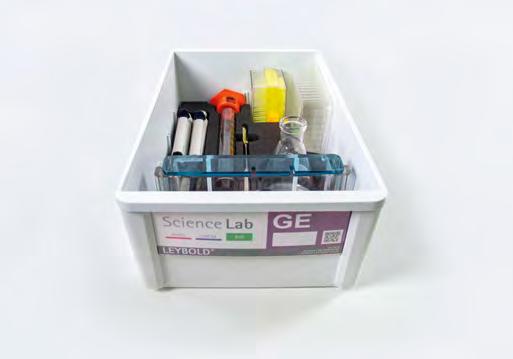

Student experiment set of the student experiment system Science Lab in the field of biology. Set-up material for one working group in device-shaped storage. With the GE equipment set, students can carry out experiments in the field of genetics from S II.
The students deal with the topics of genetics and analyses of forensic and medical diagnostics. While working on the curriculum-required topics, they are also taught the competences of communication and assessment.
The Science Lab Genetics GE equipment set serves as a basis. Together with additional DNA kits, the various topics can be addressed.
Scope of delivery:
Count Name
1 Powder spatula, steel, 185 mm
1 Tray, high
1 Erlenmeyer flask, Boro 3.3, 250 ml, narrow neck
1 Measuring cylinder 100 ml, with plastic base
1 Tint bowl, Polystyrene
1 Microlitre pipette 2-20 µl
Count Name
1 Microlitre pipette 20-200 µl
1 Pipette tips 2-200 µl, 96 each in rack
1 Electrophoresis chamber

Additionally required per student
Count Cat.-No. Name
1 610 010 Laboratory safety goggles
1 610 077 Nitrile examination gloves, size M
Additionally required per working group
Count Cat.-No. Name
1 ADACB501 Compact scale 500 g : 0.1 g
1 BEDK-004 DNA kit bacterial plasmid DNA
1 BEDK-005 DNA kit electrophoresis of lambda DNA
1 BEDK-006 DNA kit genetic fingerprint
1 BEDK-007 DNA kit paternity analysis
1 BEPS-002 300 V, 400 mA power supply
Additionally required per class
Count Cat.-No. Name
1 520 73 LIT-digital: LB Science Lab Biology
1 675 3410 Water, pure, 5 l
Description
Description
Description
n 1 tray for 11 experiments
n Carry out experiments in modern biology in the student experiment
n Methods & equipment knowledge: work with equipment that is also found in biological labs
n Application reference through the use of experiment compilation on paternity analysis and genetic fingerprinting
n Little preparation time needed by teacher/lecturer
Here you will find an overview of our literature packages. You can find detailed information on our literature on the internet at www.leybold-shop.com.


Experiment instructions for the Science Lab Genetics GE (207 351S). Describes in detail the working methods from the subject area of genetics - DNA investigations. DNA kits are used that come with their own experiment instructions.
Experiment topics:
Making an agarose gel; electrophoresis of DNA samples; tinting and evaluating DNA gels; working with DNA kits (instructions integrated with the kits)
520 7351EN LIT-print: LB5 Genetics
Comprehensive chemistry experiment instructions for the Science Lab. Contains more than 170 experiments in the fields of human biology, botany, ecology, cell biology, genetics and hygiene. Includes all interactive experiment instructions (Lab Docs) as html file.
520 73 LIT-digital: LB Science Lab Biology
Technical data of the digital version:
• Product key for German or English literature (activation and selection of the literature language via https://register.leylab.de necessary)
• System requirements:
Document Center:
- PC with Windows 7 or higher
- Internet access during installation
- Local network for distribution to students
Leylab:
- PC, tablet or smartphone with a curent browser
- Internet access





The experiments on the Science Lab set Hygiene (HY) deal with microbiological working methods as well as with experiments on the topics of spreading microorganisms and prevention.
Hygiene is important to prevent the spread of bacteria and other microorganisms. Our student experiments show how pathogens spread, how to detect contamination and spread, and how to prevent spread through disinfection and prevention.

LB6.1.3.1 Determination of bacterial count in
In this experiment, the students determine the number of germs in the air. To do this, they use sterile Agar plates and learn that the bacterial count depends on the place of examination. For this experiment you will need the set Science Lab Biology Hygiene HY (207 361S)
EXPERIMENT
LB6.1.1 INTRODUCTION TO MICROBIOLOGICAL METHODS
LB6.1.2 TRANSMISSION PATH OF PATHOGENS
LB6.1.3 DETERMINATION OF BACTERIAL COUNT
LB6.1.4 PREVENTION AND DISINFECTION
Hygiene HY


LB6.1.2.3 Simulation of an infection chain with baker‘s yeast
In this experiment, the students simulate the course of an infection chain as a prerequisite for the spread of any infectious disease. For this purpose, baker‘s yeast is used as a model organism. For this experiment you will need the set Science Lab Biology Hygiene HY (207 361S)
For more information on our curriculum-compliant topics and student experiments, as well as the corresponding sets, please see the following pages.
LB6.1.1 Introduction to microbiological methods
LB6.1.1.1
LB6.1.1.2
LB6.1.1.3
Preparation and sterilisation of culture medium
Sterilisation and cleaning of equipment and culture mediums
Determination of the bacterial count by preparation of a dilution series
LB6.1.2 Transmission path of pathogens
LB6.1.2.1
LB6.1.2.2
LB6.1.2.3
LB6.1.2.4
LB6.1.2.5
LB6.1.2.6
Determination of the germ content of banknotes and coins
Comparison of the germ content of washed and unwashed hands
Simulation of an infection chain with baker‘s yeast
Transmission path when shaking hands using UV light
Simulation of the spread of pathogens
Detection of micro-organisms on various objects
LB6.1.3 Determination of bacterial count
LB6.1.3.1
LB6.1.3.2
LB6.1.3.3
LB6.1.3.4
Determination of bacterial count in the air
Determination of the bacterial count in soil
Determination of bacterial count in the milk
Determination of the bacterial count in water
LB6.1.4 Prevention and disinfection
LB6.1.4.1
LB6.1.4.2
LB6.1.4.3
LB6.1.4.4
LB6.1.4.5
LB6.1.4.6
LB6.1.4.7
LB6.1.4.8
Bacteriostatic effects of various household remedies
Bacteriostatic effect of lysozyme
Demonstration of the effect of UV radiation
UV inactivation and photoreactivation for bacteria
Preparation of disinfectant
Simulation of proper hand hygiene using UV radiation
Dependence of the disinfection level on the ethanol concentration
Antibacterial soap or normal soap

The students produce different Disinfectants on a small scale. They learn about the typical composition of a Disinfectant and ways to make one with simple home remedies. For this experiment you will need the set Science Lab Biology Hygiene HY (207 361S)
OVERVIEW OF EQUIPMENT FOR PERFORMING ALL EXPERIMENTS
LB6.1 HYGIENE




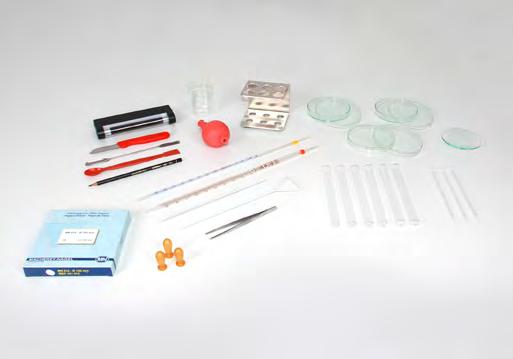
Student experiment set of the Science Lab student experiment system in the field of hygiene and microorganisms. Material for one working group in pre-formed tray With the equipment set HY more than 20 experiments at high school, college and basic university level for worldwide curriculums can be performed. The students deal with microbiological working methods as well as with experiments on the topics of the spread of microorganisms and prevention. While working on the context-oriented topics, they are also trained in communication and assessment skills.
Scope of delivery:
Count Name
1 Universal pencil
1 Beaker Boro 3.3, 100 ml, squat
1 Powder spatula, steel, 185 mm
1 Tray, high
1 Round filter, Type 595, 125 mm Ø, Set of 100
1 Drigalski spatula, glass
6 Test tube Fiolax 16 mm x 160 mm
1 Watch glass dish 80 mm Ø
3 Petri dish, 100 x 20 mm, glass
1 Glass stirring rod 200 x 8 mm Ø
1 Handlamp UV
Count Name 3 Dropping pipette 150 mm x 7 mm Ø 3 Rubber bulb 1 Graduated pipette 1 ml 1 Graduated pipette 10 ml
1 Pipetting ball (Peleus ball) 1 Spoon-ended spatula, PP, 180 mm 1 Laboratory knife
1 Tweezers, blunt, 130 mm
1 Test tube rack metal, 20 mm Ø
ADDITIONALLY REQUIRED TO PERFORM ALL EXPERIMENTS

n 1 tray for 21 experiments
n Chemical set for performing all experiments at least 10 times
n Also suitable for project or lessons/lab work to deepen the subject topic

Additionally required per student
Count Cat.-No. Name
1 610 010 Laboratory safety goggles
Additionally required per working group
Count Cat.-No. Name
1 607 020 Safety gas hose, 0.5 m
1 656 017 Teclu burner, universal
1 662 1131 Disinfectant spray
1 662 460 Essential Oils Set
4 685 44 Battery 1.5 V (AA)
1 ADACB501 Compact scale 500 g : 0.1 g
Additionally required per class
Count Cat.-No. Name
1 520 73 LIT-digital: LB Science Lab Biology
1 679 361 Chemicals Science Lab Hygiene

Chemicals for carrying out the student experiments in the Science Lab Hygiene. The Chemistry Set contains 16 different chemicals that can be used to carry out each experiment at least 10 times.
679 361 Chemicals Science Lab Hygiene
The individual chemicals from this set can be found on the Internet at www.leybold-shop.com. There you will also learn more about the corresponding hazard symbols and classes, the safe handling of chemicals and the hazard and safety instructions.
Here you will find an overview of our literature packages. You can find detailed information on our literature on the internet at www.leybold-shop.com.


Detailed experiment instructions for Science Lab Hygiene HY (207 361S). Describes about 20 experiments from the field of hygiene and micro-organisms.
Experiment topics:
Introduction to microbiological methods; Transmission path of pathogens; Determination of bacterial count; Prevention and disinfection
520 7361EN LIT-print: LB Science Lab Hygiene
Comprehensive chemistry experiment instructions for the Science Lab. Contains more than 170 experiments in the fields of human biology, botany, ecology, cell biology, genetics and hygiene. Includes all interactive experiment instructions (Lab Docs) as html file.
520 73 LIT-digital: LB Science Lab Biology
Technical data of the digital version:
• Product key for German or English literature (activation and selection of the literature language via https://register.leylab.de necessary)
• System requirements:
Document Center:
- PC with Windows 7 or higher
- Internet access during installation
- Local network for distribution to students
Leylab:
- PC, tablet or smartphone with a curent browser
- Internet access





How can we contain the spread of bacteria?



Hygiene is an important topic in everyday life, especially in schools. Bacteria and other micro-organisms can spread quickly and cause infections.
Therefore, students should be regularly informed about hygiene practices and also practice them at school.
A simple student experiment can show how quickly bacteria can spread on surfaces. To do this, open a Petri dish with nutrient medium and place it for a few seconds on a surface such as a door handle or a school satchel. After a few days, you can observe how bacteria have multiplied on the Petri dishes.

To prevent the spread of bacteria and other microorganisms, it is important to wash hands regularly and use Disinfectant if necessary. Cleaning surfaces and stands can also help to reduce the spread of bacteria.
Overall, the prevention of infections through hygienic practices is an important measure to effectively protect our health.
Banknotes and coins can be contaminated with bacteria and other micro-organisms as they are often touched by many different people. Studies have shown that a variety of bacteria, viruses and other micro-organisms can be found on banknotes and coins.
To increase the visibility of bacteria on banknotes and coins, you can use a black light lamp. Most bacteria fluoresce under UV light and thus become visible. If you shine a black light on banknotes and coins, you can see the places where there are particularly many bacteria.

The following overview shows which chemicals are required for the individual topics. They are sorted by article no.

















670
670
670



670
670 5200 Ammonium thiocyanate, 50 g x
670
670 7410 Barium hydroxide, 250 g
670 8200 Petroleum ether, 90...110 °C, 250 ml
670 8300 Benzoic acid, 50 g
671 0350 Bromide/Bromate solution, 500 ml
carbonate, precipitated, 500 g
671 2950 Calcium hydroxide solution, 250 ml














GHS05 671 2960 Calcium hydroxide solution (lime water), 1 l
671 3200 Calcium oxide, powder, 100 g







GHS05 671 4910 Schulze‘s solution, 50 ml
671 5600 Citric acid monohydrate, 100 g
671 5700 Cyclohexane, 250 ml
5910 Cyclohexene, 100 ml
671 6620 2,6-Dichlorophenol-indophenol sodium salt, 1 g
671 8250 Iron powder, coarse, 250 g x
671 8300 Iron powder, reduced, 50 g x
671 8410 Iron wool, 200 g x
671 8700 Iron(III) chloride-6-hydrate, 50 g
671 9000 Iron(III) oxide, 100 g
671 9100 Iron(II) sulfate-7-hydrate, 100 g x
671 9500 Acetic acid, 99 %-100 %, 250 ml
671 9550 Acetic acid, dil., (approx. 2 mol/l), 500 ml
671 9570 Acetic acid, 0.1 mol/l, 1 l
671 9590 Acetic acid, 1 mol/l, 1 l x













For explanation and detailed information on hazard warnings, precautionary statements and GHS pictograms please consult the CLP regulation. Also please always observe the regulations that apply to your country.








GHS07 H226 H315 H318





671 9630 Ethyl acetate, 250 ml x



671 9640 Acetic ethylester, 500 ml x GHS02
671 9720 Ethanol, denaturated, 1 l
671 9740 Ethanol, denaturated, 250 ml
671 9800 Ethylene glycol, 250 ml x
671 9900 Fehling‘s solution I, 100 ml
672 0000 Fehling‘s solution II, 100 ml
672 0700 D(-)-Fructose, 50 g
672 0970 Gypsum, burned, pure, 500 g x
672 0980 Gypsum, burned, pure, 1 kg
672 1000 Glass wool, 10 g
672 1010 Glass wool, 100 g
672 1100 D(+)-Glucose, 100 g
672 1110 D(+)-Glucose, 250 g x
672 1120 D(+)-Glucose, 1 kg x
672 1190 Glycerine, 99 %, 50 ml x
672 1200 Glycerol, 99 %, 100 ml
672 1300 Glycine (Glycocoll), 50 g x
672 1700 Urea, 100 g x
672 1740 Heating oil, 250 ml
672 1800 n-Heptane, 50 ml
672 2490 Charcoal, small pieces, 500 g x
672 2520 Wooden turnings, 100 St. x x x x x
672 3400 Indigo carmine, 10 g x
672 3700 Iodine, 25 g x x
672 3900 Lugol‘s solution, 100 ml x
672 3911 Lugol‘s solution, 1 l
672 3920 Lugol‘s solution, 50 ml
672 4900 Potassium bromide, 50 g x
672 4930 Potassium bromide solution, approx. 1 M, 250 ml
5520 Potassium citrate monohydrate, 100 g x 672 6000 Potassium ferrocyanide (II), 50 g x
672 6100 Potassium ferrocyanide (III), 50 g x
















672 6200 Kaliumhydrogenphosphat, 50 g x 672 6320 Potassium hydrogen tartrate, 250 g x672 6400 Potassium hydroxide, 250 g x

672 6600 Potassium iodide, 25 g x
672 6630 Potassium iodide, 250 g
672 6670 Potassium iodide solution, approx. 1 M, 250 ml
672 6710 Potassium sodium tartrate, 250 g
6850 Potassium nitrate solution, approx. 1 mol/l, 250 ml
7000 Potassium permanganate, 100 g
7400 Potassium thiocyanate, 100 g







672 7660 Carmine acetic acid, 50 ml x GHS07
672 8600 Copper, sheets, 50 g
672 8620 Copper, sheets, 250 g
672 8800 Copper, powder, 50 g
672 9100 Copper(II) chloride, 50 g
672 9500 Copper(II) oxide, powder, 50 g x x






672 9510 Copper(II) oxide, powder, 100 g x GHS07
672 9600 Copper(II) sulfate-5-hydrate, 100 g




672 9630 Copper(II) sulfate-5-hydrate, 500 g x GHS07





672 9650 Copper(II) sulfate solution 1 %, 50 ml
672 9660 Copper(II) sulfate solution, 1 mol/l (15 %), 500 ml
673



1150 Magnesium, turnings, 50 g
1230 Magnesium chloride solution, approx. 1 M, 250 ml
673 2920 Methylene blue solution, 100 ml
673 3050 Methylene orange solution, 0.1 %, 100 ml
673 5000 Sodium acetate-3-hydrate, 50 g x
5600
5720 Sodium chloride, 1 kg x x
M, 500 ml x










673 6600 Sodium bicarbonate, 250 g








673 6810 Sodium hydroxide, pellets, 250 g x GHS05

673 6830 Sodium hydroxide, pellets, 500 g x GHS05



673 7100 Sodium nitrite, 50 g x GHS03 GHS06
673 7410 Trisodium phosphate dodecahydrate, 250 g x GHS07

673 7600 Sodium sulfate-10-hydrate, 100 g x -
673 7800 Sodium sulfite, 100 g x x
673 8000 Sodium thiosulfate-5-hydrate, 100 g x x -
673 8010 Sodium thiosulfate-5-hydrate, 250 g x
673 8400 Sodium hydroxide solution, diluted, aprox. 2 M, 500 ml

GHS05 673 8410 Sodium hydroxide solution, 0.1 mol/l, 500 ml x GHS05

673 8411 Sodium hydroxide solution, 0.1 mol/l, 1 l x x GHS05
673 8420 Sodium hydroxide solution, 1 mol/l, 500 ml
673 8421 Sodium hydroxide solution, 1 mol/l, 1 l


















P305+P351+P338
P301+P330+P331 P309+P310 P305+P351+P338 Danger

GHS09 H272 H301 H400 P273 P309+P310
H319 H315 P302+P352 P305+P351+P338 Achtung
P301+P330+P331 P305+P351+P338 P309+P310 Danger H314 H290 P280 P301+P330+P331 P305+P351+P338 P309+P310 Danger
H319 H335 H317 H334 P280 P302+P352 P304+P341 P342+P311 P305+P351+P338 Danger


GHS07 GHS09 H225 H304 H315 H336 H411 EUH066 P210 P240 P273 P301+P310 P331 P403+P235 Danger H225 H350 H341 P210 P233 P281 P308+P313 Danger
P280 P302+P352 P305+P351+P338 P313 Warning
P210 P233 P302+P352 P304+P340 P305+P351+P338 Danger H314
H302 H315 H319 H400
P280 P301+P330+P331 P305+P351+P338 P309+P310 Danger
P273 P302+P352 P305+P351+P338 Warning
674 5840 Cruide oil, artificial, 1 l x
674 6050 D(+)-Sucrose, 100 g x x x x x x -
674 6060 D(+)-Sucrose, 250 g x
674 6650 Nitric acid, diluted, approx. 2 mol/l, 500 ml x x
6750 Hydrochloric acid, conc., 25 %, 250 ml
6800 Hydrochloric acid, 10 %, 500 ml
674 6810 Hydrochloric acid, 10 %, 1 l x
674 6900 Hydrochloric acid, 1 mol/l, 500 ml x x









674 6910 Hydrochloric acid, 1 mol/l, 1 l x x GHS05
674 6920 Hydrochloric acid, approx. 2 mol/l, 500ml x x

674 6960 Hydrochloric acid, 0.1 mol/l, 1 l x x GHS05

674 7350 Schiffs‘s reagent, 250 ml x GHS05
674 7610 Sulfur, sublimed, 500 g x x
674 7850 Sulfuric acid, 95-98 %, 250 ml x



674 7891 Sulfuric acid, 35 %, 1 l x GHS05

674 7900 Sulfuric acid, 5 mol/l, 100 ml x GHS05

674 7920 Sulfuric acid, diluted, approx. 2 N, 500 ml x x x x GHS05

674 7950 Sulfuric acid, 0.5 mol/l, 1l x x GHS05

674 8200 Sea sand, purified, 250 g x x -
674 8210 Sea sand, purified, 1 kg x -
674 8211 Sea sand, purified, 500 g x
674 8710 Silver nitrate solution, 5 %, 100 ml x x
8800 Silver nitrate solution, 0,1 mol/l, 250 ml x
8810 Silver nitrate solution, 0,1 mol/l, 1 l x
674 9040 Silicone high vacuum grease, 75 g x 674 9050 Silicone oil, 100 ml x
674 9100 Sorbic acid, 25 g x
674 9200 Starch, soluble, 100 g x
674 9210 Starch, soluble, 250 g x
674 9220 Starch, soluble, 50 g x




674 9520 Polystyrene (Styropor P), 100 g x -
674 9680 Sudan black, 1 g x x
674 9710 Sulphanilic acid, 50 g x
675 1600 Thymolphthalein solution, 0.1 %, 50 ml x





675 1650 Tillman‘s reagent, 50 ml x -
675 2530 L(-)-Tyrosine, 25 g
675 2570 Universal Indicator, 100ml x
675 2800 Urease (1 U/mg), 1 g x


675 3100 Vaseline, 50 g x -
675 3270 Vitamin C, 50 g x
675 3500 Hydrogen peroxide, 30 %, 250 ml x x x x




675 3520 Hydrogen peroxide, 5 %, 50 ml x GHS07
675 3550 Cotton wad, 200 g x x
675 4800 Zinc, granulated, 100 g x x
675 4900 Zinc, powder, 100 g x x GHS09
675 5000 Zinc, sticks, 100 g x



675 5110 Zinc chloride, dry, 250 g x GHS05 GHS07
675 5220 Zinc iodide solution, 50 %, 50 g x GHS07

675 5300 Zinc oxide, 50 g x GHS09
675 5410 Zinc sulfate-7-hydrate, 250 g x

675 5510 Zinc sulfate solution, approx. 1 M, 500 ml x GHS07
675 5700 Tin, foil, 100 x 0.10 mm, 50 g x x


H314 H290
H314 H335 H290
H315 H319 H335 H290
H315 H319 H335 H290
P280 P305+P351+P338 P309+P310 P301+P330+P331 Danger
P280 P301+P330+P331 P309+P310 P305+P351+P338 Danger
P280 P261 P304+P340 P305+P351+P338 P312 P403+P233 Warning
P280 P261 P304+P340 P305+P351+P338 P312 P403+P233 Warning
H290 P390 Warning
H290 P390 Warning
H290 P390 Warning
H290 P390 Warning
H290 P234 P262 Warning
H315 P302+P352 Warning
H314 H290
H290 H314
H290 H314
P280 P301+P330+P331 P309 P310 P305+P351+P338 Danger
P260 P280 P301+P330+P331 P305+P351+P338 P310 Danger
P280 P301+P330+P331 P309 P310 P305+P351+P338 Danger H290 H315 H319
P305+P351+P338 P337+P313 P302+P352
P273 P302+P352 P305+P351+P338 P332+P313
H410

Measuring device for student experiments and demonstrations in the natural sciences:
• Large measured value display switches on automatically after start-up or when a sensor is attached (no boot time and no further keys to press)
• 4 mm safety sockets for U, I, P and E as well as Type K socket for NiCr-Ni temperature probe integrated
• For all CASSY sensors and sensors M
• The touch wheel – with a turn of the wheel quickly change to the appropriate screen or the appropriate list entry
• Measurement time, measurement interval, trigger and pre-trigger (advance) are adjustable
• Graphs of measured values with freely selectable coordinate axes and selectable evaluation methods (e.g. zoom and straight line fitting)
• Measured values and screen shots can be saved on an integrated micro SD card and copied onto a USB stick
• Full support from CASSY Lab 2 (524 220), via USB lead for teaching by demonstration with the projector
• Support leg allows easy viewing angle.
• WiFi integrated.
Technical data:
• Graphics display: 9 cm (3.5“), colour QVGA (adjustable up to 400 cd/m²)
• Inputs: 3 (can be used simultaneously)
• Input A: U or CASSY sensor or sensor M
• Input B: I or CASSY sensor or sensor M
• Input ϑ: temperature
• Measuring range U: ±0.1/±0.3/±1/±3/±10/±30 V
• Measuring range I: ±0.03/±0.1/±0.3/±1/±3 A
• Measuring range ϑ: -200 ... +200 °C / -200 ... +1200 °C
• Sensor connections: each 2 for CASSY sensors and sensors M
• Sampling rate: max. 500,000 values/second
• Operation: large capacitive touch wheel (42 mm)
• Resolution: 12 bit
• Time resolution of the timer inputs: 20 ns
• Loudspeaker: integrated for key tones and GM counter tube (can be disabled as required)
• Data storage device: integrated micro SD card for more than a thousand measurement files and screen shots, optionally also via a USB stick
• WiFi: 802.11 b/g/n as access point or client (WPA/WPA2)
• VNC server: integrated
• Battery capacity: 14 watt-hours (AA size, replaceable)
• Battery life: 8 h during operation, several years on standby
• Kensington lock: as anti-theft protection
• Dimensions: 175 mm x 95 mm x 40 mm
Scope of delivery:
• Mobile-CASSY 2 WiFi
• Battery charger
• NiCr-Ni temperature sensor
• Quick start guide
524 005W2 Mobile-CASSY 2 WiFi
Additionally recommended:
Count Cat.-No. Name
1 524 0034
1 524 0039
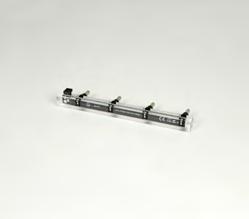

Charging adapter for 4 Mobile-CASSY 2 WiFi
Storage tray Mobile-CASSY 2 WiFi
For the simultaneous charging of up to 4 Mobile-CASSY 2 WiFi (524 005W2) with just one plug-in power supply.
Technical data:
• Charging time: unchanged compared to single charging
• Connection: hollow socket for 12 VAC plug-in connector (incl. in the scope of delivery of every Mobile-CASSY 2 WiFi)
• Fuse: 1.1 A (self-resetting)
• Dimensions: 195 mm x 17 mm x 36 mm
• Weight: 70 g
524 0034
Charging adapter for 4 Mobile-CASSY 2 WiFi
For safe storage of up to 8 Mobile-CASSY 2 WiFi (524 005W2). Together with two adapters (524 0034) all 8 Mobile-CASSY 2 WiFi can be simultaneously charged in the storage tray.
Technical data:
• Dimensions: 27 cm x 45 cm x 16.5 cm
Scope of delivery:
• Storage tray with foam inlay
524 0039 Storage tray Mobile-CASSY 2 WiFi
Recommended accessories: 2 charging adapters (524 0034)
For measuring very small pressure differences with CASSY (524 013, 524 006, 524 018, 524 005W2) or the universal measuring instruments (531 835, 531 836, 531 837), e.g. at flow experiments in the wind tunnel (373 12) or the Venturi tube (from 373 091). Connection to the experiment via two hose nozzles (4 mm diam.). Incl. PVC tubing (667 192) and two connectors with nipple (604 520).
Technical data:
• Measuring ranges: ±0.7/±2.1/±7/±21/±70 hPa
• Resolution: 0.05% of the measuring range
• Dimensions: 70 mm x 50 mm x 25 mm
• Weight: 75 g
524 066 Pressure sensor S, ±70 hPa
Force sensor M, ±50 N
For measuring force components up to ±50 N (e.g. spring pendulum or centrifugal force components) with Mobile-CASSY 2 WiFi (524 005W2). Its rigid design enables the measurement of force components in any position of the force sensor.
Technical data:
• Measurement ranges: ±5/±50 N
• Resolution: 0.1 % of the measurement range
• Compensation (Tare): ±50 N in every measurement range
• Fixing: with securing bolts on stand equipment
• Connection: Mini-DIN
• Connection cable length: 0.3 m
524 434 Force sensor M, ±50 N
Light barrier M
Cascadable photoelectric barrier for measuring period durations, travelling time, paths and velocities on the student track or during free fall with Mobile-CASSY 2 WiFi (524 005W2).
Technical data:
• Time resolution: 100 ns
• Path resolution: 5 mm when utilising the spoked wheels
• Cascading: up to 5 photoelectric barriers (e.g. for travelling time measuring or up to 5 sequential relocity measurements on one track)
• Fixing: locking in place under the student track (460 81/460 82) or via M6 threads
• Connection cable length: 1 m
• Connection: Mini-DIN
• Supply voltage: 5 V DC via Mini-DIN
• Dimensions: 120 mm x 115 mm x 30 mm
• Weight: 180 g
524 431 Light barrier M
Recommended accessories:
• Spoked wheel (524 4322)
For fixing on a light barrier M for continuous path and velocity measuring.
• Start jig, trolley (524 4323)
For fixing on a light barrier M for automatic start of the time measuring when starting the movement on a track (instead of a holding magnet).
• Start jig, ball (524 4324)
For fixing on a light barrier M for automatic start of the time measuring when starting a free fall of a ball (instead of a holding magnet).
Microphone M
For measuring sound level, frequency and the voltage of acoustic signals with Mobile-CASSY 2 WiFi (524 005W2).
Technical data:
• Measuring variables: Voltage, frequency, sound level
• Frequency range: 50 ... 20,000 Hz
• Sound level ranges: 40 ... 100 dB, 60 ... 120 dB (also automatically)
• Sampling rate: maximum 500,000 values/s
• Connection: Mini-DIN
• Connection cable length: 1.2 m
524 442 Microphone M
Magnetic field sensor M, ±100 mT
For measuring the tangential or axial magnetic flux density up to ±100 mT with Mobile-CASSY 2 WiFi (524 005W2).
Technical data:
• Measurement ranges: ±10/±100 mT
• Resolution: 0.05 % of the measurement range
• Measurement direction: switchable between axial and tangential
• Connection: Mini-DIN
• Connection cable length: 1.2 m
524 436 Magnetic field sensor M, ±100 mT



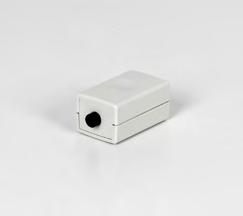





For measuring the illuminance of visible light with Mobile-CASSY 2 WiFi (524 005W2). The lux sensor has a flat design so that it can, for example, be inserted directly into the holder for diaphragms and slides (459 33). With the lux sensor, measurements can be performed along and orthogonal to the optical axis. A printed millimetre scale is used to position the sensor on the optical axis and also enables the recording of intensity distributions of different diffraction objects (e.g. 469 731) without additional equipment.
Technical data:
• Measuring ranges: 0...100 lx, 0...1 klx, 0...10 klx, 0...100 klx
• Dimensions of the sensor: 0.4 mm x 0.4 mm
• Spectral sensitivity: 480 ... 650 nm
• Dimensions: 50 mm x 50 mm x 2.4 mm
• Connection: Mini-DIN
• Length of connecting cable: 1.20 m
524 444 Lux sensor M
For measuring radioactive radiation with a Geiger-Müller counter tube (559 01 or 559 012) with Mobile-CASSY 2 WiFi (524 005W2).
Technical data:
• Counter tube voltage: 200 ... 650 V (adjustable)
• Counter tube input: Coaxial socket
• Connection: Mini-DIN
• Connection cable length: 0.3 m
524 440 GM adapter M
The Relay M is an actuator for the Mobile-CASSY 2 WiFi (524 005W2). It facilitates controlling an experiment on the basis of the input quantities of the Mobile-CASSY 2 WiFi. This allows for the retrofitting of an output X or Y as an addition to the inputs A and B. The simultaneous use of the 4mm socket remains possible.
Technical data:
Output: changeover relay with LED (max. 30 V/2 A)
Trigger: 2 independet triggers for switching on and off Deadtime: ∆t selectable as „off“ or 1/5/10/30 s
Connection: Mini-DIN
Length of the connecting cable: 0.30 m
524 446 Relay M
Conductivity sensor using four-wire technology with integrated Pt temperature sensor for use with chemistry box (524 067), conductivity adapter S (524 0671) and CASSY (524 013, 524 006, 524 005W2, 524 018) or the universal chemistry measuring instrument (531 836). Open design for rapid response to changes in conductivity. When conducting measurements a minimum distance of 1 cm from the side of the, as well as a minimum immersion depth of 2 cm are to be maintained.
Technical data:
• Cell constant 0.58 cm-1
• Measuring range: 0 ... 1 S/cm
• Temperature range: -25 ... +100 °C
• Connections: 6-pole DIN socket
• Dimensions: 160 mm x 16 mm diam.
• Weight: 75 g

Used in conjunction with the conductivity sensor (529 670), this adapter enables conductivity and temperature to be measured with CASSY (524 013, 524 006, 524 005W2, 524 018) or the universal chemistry measuring instrument (531 836).
Technical data:
• Measuring ranges: Conductivity (with sensor 529 670): 10/30/100/300 µS/cm, 1/3/10/30/100/300 mS/cm, 1 S/cm
• Resolution 0.005 µS/cm in the smallest measuring range
• Temperature measurement and compensation: -25 ... +100 °C
• Connections: 8-pole DIN socket for conductivity sensor with temperature measurement
• Dimensions: 50 mm x 25 mm x 60 mm
• Weight: 0.1 kg
524 0671
Conductivity adapter S
Additionally required:
Count Cat.-No. Name
1 529 670
Conductivity sensor
Enables a pH electrode to be connected to CASSY (524 013, 524 006, 524 005W2, 524 018) or the universal chemistry measuring instrument (531 836). Moreover, the voltage at the BNC socket can be measured at a very high resistance, e.g. for measuring electrochemical potentials.
Technical data:
• Measuring ranges pH: 0 ... 14 pH
• Resolution pH: 0.01 pH
• Measuring ranges potential: ±1/±2 V
• Input resistance: > 1013 Ω
• Connection: BNC socket
• Dimensions: 50 mm x 25 mm x 60 mm
• Weight: 0.1 kg
524 0672 pH adapter S
Additionally recommended:
Count Cat.-No. Name
1 529 672 pH sensor, BNC
1 667 416 Single-rod redox probe BNC
1 667 4172 pH sensor with plastic shaft, BNC
1 667 4242 pH probe with glass shaft, BNC
• Measuring range: 0 ... 14 pH
• Resolution: 0.01 pH
• Suitable for: 524 067 and 524 0672
Cat.-No. Designation
529 672 pH sensor, BNC
667 4172 pH sensor with plastic shaft, BNC
667 4242 pH probe with glass shaft, BNC
Mobile power supply for experiments as well as voltage und current measuring device in conjunction with the Mobile-CASSY 2 WiFi (524 005W2). For power supply upt to 300mA as well as the intuitive, parallel measurement of the voltage up to ±20 V and the current up to ±2 A.
Technical data:
• 1 Output: 4 mm safety sockets
• Current: 0 to 300mA (30 ranges), power limited to 1.5 W
• 2 Inputs (current and voltage measurement): 4 mm safety sockets, differential
• Current measuring range: up to ±2 A, self-resetting fuse
• Resolution: 0,1 mA
• Voltage measuring range: up to ±20 V, input resistance 1 MΩ
• Resolution: 1 mV
• Connection: Mini-DIN
• Connection cable length: 1.20 m
524 450 Electrochemistry box M
For measurement of the pulse frequency with the aid of an infrared sensor which is attached to the ear lobe or finger tip, whereby the sensitivity is adjusted automatically. The individual pulse beats are indicated by a LED. The pulse sensor is electrically isolated from CASSY (524 013, 524 006, 524 005W2, 524 018).
524 0471 Pulse sensor S
For blood pressure measurements using the oscillometric method with Sensor-CASSY 2 (524 013) or Pocket-CASSY (524 006, 524 018) without stethoscope and microphone. The pressure variations which are caused by the pulse waves are transmitted by the arm collar and measured together with the falling pressure in the arm collar. Alternative for use with the Mobile-CASSY 2 WiFi (524 005W2) after the auscultatoric method (designed by Korotkov). The characteristic noise phenomena are listened to with a stethoscope (additionally required). The universal biology measuring instrument (531 837) gives an audible sound for the pressure variations.
Technical data:
• Pressure range: 375 mm Hg (500 hPa)
524 0501 Blood pressure sensor S



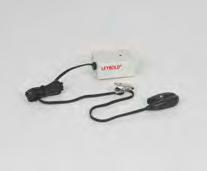


For pneumotachographic measurement of various pulmonary volumes, the flow-volume curve and the forced expiratory volume per second with CASSY (524 013, 524 006, 524 005W2, 524 018).
Technical data:
• Measuring range: -14.0 ... +14.0 l/s
• Accuracy of measurement: ±2.5%
Scope of delivery:
• 1 Spirometer box
• 1 Adapter
• 30 Bacteria filter
• 30 Mouth pieces
524 056 Spirometer box

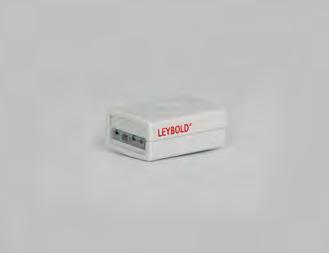
For measuring reaction times, controlled by a hand or foot button, and for determining nerve conductor speed. Signalling accomplished as selected, either via three-colour LEDs (hand key) or acoustic signal (foot button) or software.
524 0461 Reaction test adapter S
Additionally required:
Count Cat.-No. Name
1 662 148 Hand-held button
1 662 149 Foot switch
Enables connection of two NiCr-Ni (type K miniature flat connector) thermocouples for temperature and differential temperature measurements with CASSY (524 013, 524 006, 524 005W2, 524 018) or the universal measuring instruments (531 835, 531 836, 531 837).
Technical data:
• Max. measuring ranges (dependent on sensor): -200 ... +200 °C/-200 ... +1200 °C
• Resolution: 0.1 K/1 K
• Differential temperature measuring ranges: -20 ... +20 °C/-200 ... +200 °C
• Resolution: 0.01 K/0.1 K
• Dimensions: 50 mm x 25 mm x 60 mm
• Weight: 0.1 kg
524 0673 NiCr-Ni adapter S, type K
Additionally recommended:
Count Cat.-No. Name
1 529 676
1 666 1261
1 666 1263
1 666 1264

Temperature probe, NiCr-Ni, 1.5 mm, type K
Temperature probe, NiCr-Ni, fast, type K
Temperature probe, NiCr-Ni, 3 mm, type K
Temperature probe, NiCr-Ni, for surface measurement, type K
Power bank with 2200 mAh suitable for LED lamp (459 094), triple LED lamp (459 098) and laser class 1, red (459 097). The 5V DC USB plug-in power supply unit (459 095) can be used to charge the power bank.
459 099 USB power bank 2200 mAh
Power supply unit for electrical and simple electronic experiments. Output voltage adjustable in steps; overload protected with circuit breakers. All outputs galvanically isolated from the mains, floating. Particularly suited for student experiments at all age levels thanks to safe separation in accordance with BG/GUV-SI 8040 (conforms to German RiSU).
Technical data:
• Output voltages: 2-24 V AC and DC, in steps of 2 V
• DC voltage: bridge rectification
• Load capacity: 5 A, aggregated
• Connector: two 4 mm connector pairs for AC and DC
• DC and AC part may be used simultaneously, but are not galvanically isolated
• Electrical isolation: Isolating transformer in accordance with DIN EN 61558-2-6, (compliant to german RiSU)
• Input voltage: 230 V, 50/60 Hz
• Dimensions: 203 mm x 225 mm x 117 mm
• Weight: 2.8 kg
521 353 Variable transformer 2...24 V/ 5 A
Power supply unit with high load capacity for continiously adjustable DC and AC voltage and digital display. All outputs are overload protected by circuit breakers and are therefore particularly suited for practical experiments. All outputs galvanically isolated from the mains, floating. From a safety standpoint, particularly suited for student experiments at all age levels thanks to safe separation in accordance with BG/GUV-SI 8040 (conforms to german RiSU).
Technical data:
• Output voltages: 0-24 V AC and DC, continiously adjustable
• DC voltage: bridge rectification, smoothed
• Load capacity: 5 A, aggregated
• Display: switchable between AC and DC
• Connector: two 4 mm connector pairs for AC and DC
• DC and AC may be used simultaneously, but are not galvanically isolated
• Electrical isolation: Isolating transformer in accordance with DIN EN 61558-2-6, (compliant to german RiSU)
• Input voltage: 230 V, 50/60 Hz
• Dimensions: 256 mm x 225 mm x 117 mm
• Weight: 6 kg
521 391 AC/DC power supply 0...24 V / 5 A
Variable low-voltage transformer 1...12 V /
Power supply unit for electrical and simple electronic experiments. Output voltage adjustable in steps; overload protected with circuit breakers. All outputs galvanically isolated from the mains, floating. Particularly suited for student experiments at all ages due to safe separation in accordance with BG/GUV-SI 8040 (conforms to german RiSU).
Technical data:
• Output voltages: 1-12 V AC and DC, in steps of 1 V
• DC voltage: bridge rectification
• Load capacity: 6 A, aggregated
• Connector: two 4 mm connector pairs for AC and DC
• DC and AC part may be used simultaneously, but are not galvanically isolated
• Electrical isolation: Isolating transformer in accordance with DIN EN 61558-2-6, (compliant to german RiSU)
• Input voltage: 230 V, 50/60 Hz
• Dimensions: 203 mm x 225 mm x 117 mm
• Weight: 2.8 kg
521 352 Variable low-voltage transformer 1...12 V / 6 A
power
PRO 0...12 V/3 A
Standard student power supply with continously adjustable and regulated DC output voltage, AC voltage adjustable in steps, and digital display; AC and DC outputs galvanically isolated, reliable overload protection and circuit protection by electronic current limitation (DC) and circuit breaker (AC). All outputs galvanically isolated from the mains, floating. Particularly suited for student experiments at all age levels thanks to safe separation in accordance with BG/GUV-SI 8040 (conforms to german RiSU).
Technical data:
• Output voltages: 0 ... 12 V DC, continiously adjustable, stabilised 2/4/6/12 V AC
• Output current: max. 3A
• Residual ripple DC: < 100 mV
• Notification
• Overload protection: DC electronic, AC with resettable circuit breaker
• Connections: 4 mm safety sockets
• Connection voltage: 230 V, 50/60 Hz
• Electrical isolation: Isolating transformer in accordance with DIN EN 61558-2-6, (compliant to german RiSU)




• Dimensions: 203 mm x 225 mm x 117 mm
• Weight: 3 kg
521 487 AC/DC power supply PRO 0...12 V/3 A

Simple student power supply with continously adjustable and regulated DC output voltage, AC voltage adjustable in steps; AC and DC outputs galvanically isolated, reliable overload protection and circuit protection by electronic current limitation (DC) and circuit breaker (AC). All outputs galvanically isolated from the mains, floating. Particularly suited for student experiments at all age levels thanks to safe separation in accordance with BG/GUV-SI 8040 (conforms to german RiSU).
Technical data:
• Output voltages: 0...12 V DC, continiously adjustable, stabilised 2/4/6/12 V AC
• Output current: max. 3A
• Residual ripple DC: < 100 mV
• Overload protection: DC electronic, AC with resettable circuit breaker
• Connections: 4 mm safety sockets
• Connection voltage: 230 V, 50/60 Hz
• Electrical isolation: Isolating transformer in accordance with DIN EN 61558-2-6, (compliant to german RiSU)
• Dimensions: 203 mm x 225 mm x 117 mm
• Weight: 3 kg

For storage of equipment and materials, especially for student experiment materials. High load capacity and the possibility of free labeling by „supplied“ label holder. Stackable with or without lid 647 003. Possibility of multifunctional subdivision by separate fold divider (647 004, 647 005, 647 006).
Technical data:
• Material: styrene-butadiene (SB)
• Dimensions: 450 mm x 270 mm x 108 mm
• Stackable
• High load capacity
• Multifunctional subdivision possibility
647 001 Tray, low

For storage of equipment and materials, especially for student experiment materials. High load capacity and the possibility of free labeling by „supplied“ label holder. Stackable with or without lid 647 003. Possibility of multifunctional subdivision by separate fold divider (647 004, 647 005, 647 006).
Technical data:
• Material: styrene-butadiene (SB)
• Dimensions: 450 mm x 270 mm x 162 mm
• Stackable
• High load capacity
• Multifunctional subdivision possibility
647 002 Tray, high

To cover the trays 647 001 and 647 002. Stackability of the trays remains even with lid.
Technical data:
• Material: Polypropylene (PP)
• Dimensions (outside): 455 mm x 275 mm x 18 mm
647 003 Lid for tray
For holding the labels of the trays 647 001 (low) and 647 002 (high). Suitable for the labeling of 4 complete trays.
Technical data:
• Dimensions: 210 mm x 77 mm
• Quantity: 8 pieces
647 007 Label holder, set of 8 pieces
Fold devider, long, set of 4 pieces
For subdivision of the trays 647 001 and 647 002. Each tray can be divided into 2 sections longitudinally with one fold divider.
Technical data:
• Material: styrene-butadiene (SB)
• Dimensions: 401 mm x 70 mm
• Quantity: 4 pieces
647 004 Fold devider, long, set of 4 pieces
Fold devider, medium, set of 4 pieces
For subdivision of the trays 647 001 and 647 002. Each tray can be divided up to 5 sections transversely with the fold dividers.
Technical data:
• Material: styrene-butadiene (SB)
• Dimensions: 246 mm x 70 mm
• Quantity: 4 pieces
647 005 Fold devider, medium, set of 4 pieces
For subdivision of the trays 647 001 and 647 002. In combination with the fold divider, long (647 004), each tray can be divided up to 10 sections longitudinally and transverseley with the fold dividers.
Technical data:
• Material: styrene-butadiene (SB)
• Dimensions: 120 mm x 70 mm
• Quantity: 4 pieces
647 006 Fold devider, short, set of 4 pieces
Additionally required:
1 647 004 Fold devider, long, set of 4 pieces


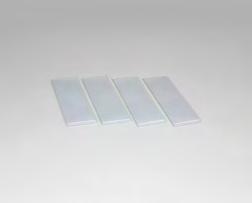
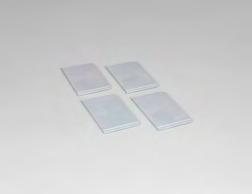



LP1.1.3.2 Hydrostatic pressure

LC1.1.1.2C Boiling point

LB3.2.2.8C Diurnal variation measurements


LP5.3.2.2 Complementary crossed gratings (Babinet‘s principle)

LC2.1.2.1 Detection of hydrogen and carbon

LB3.2.2.3C ph value of soil samples

LP6.2.7.1C The influence of a magnet on beta radiation

GERMANY:
LD DIDACTIC GmbH
Leyboldstr. 1
50354 Huerth
Germany
Tel.: +49 2233 604 0
Fax: +49 2233 604 222
E‐Mail: info@ld‐didactic.de www.ld‐didactic.com

